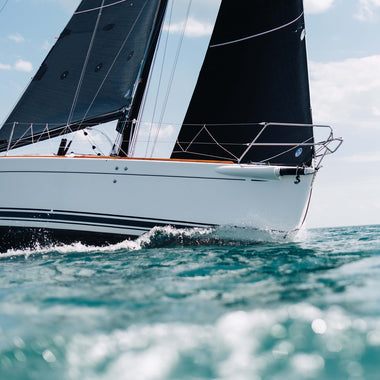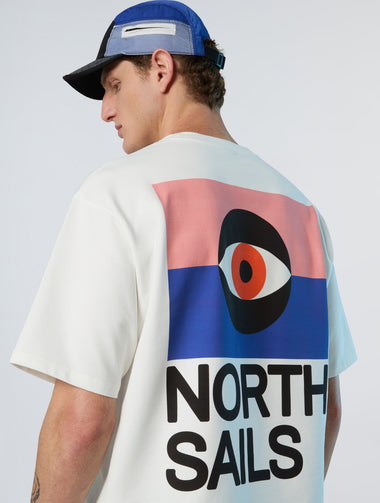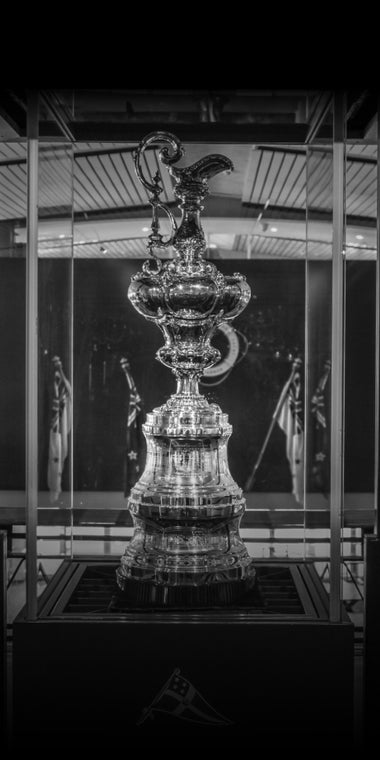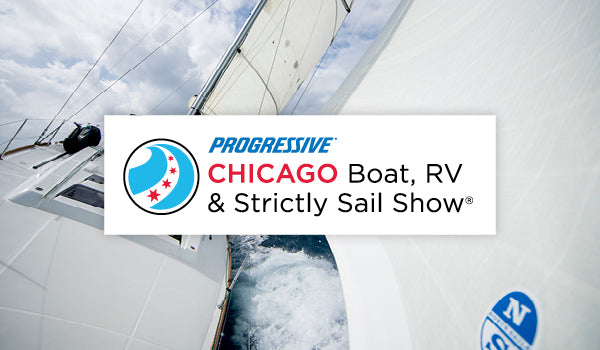NORTH SAILS BLOG
All
Events
Guides
News
People
Podcast
Sustainability
Tech & Innovation
Travel & Adventure
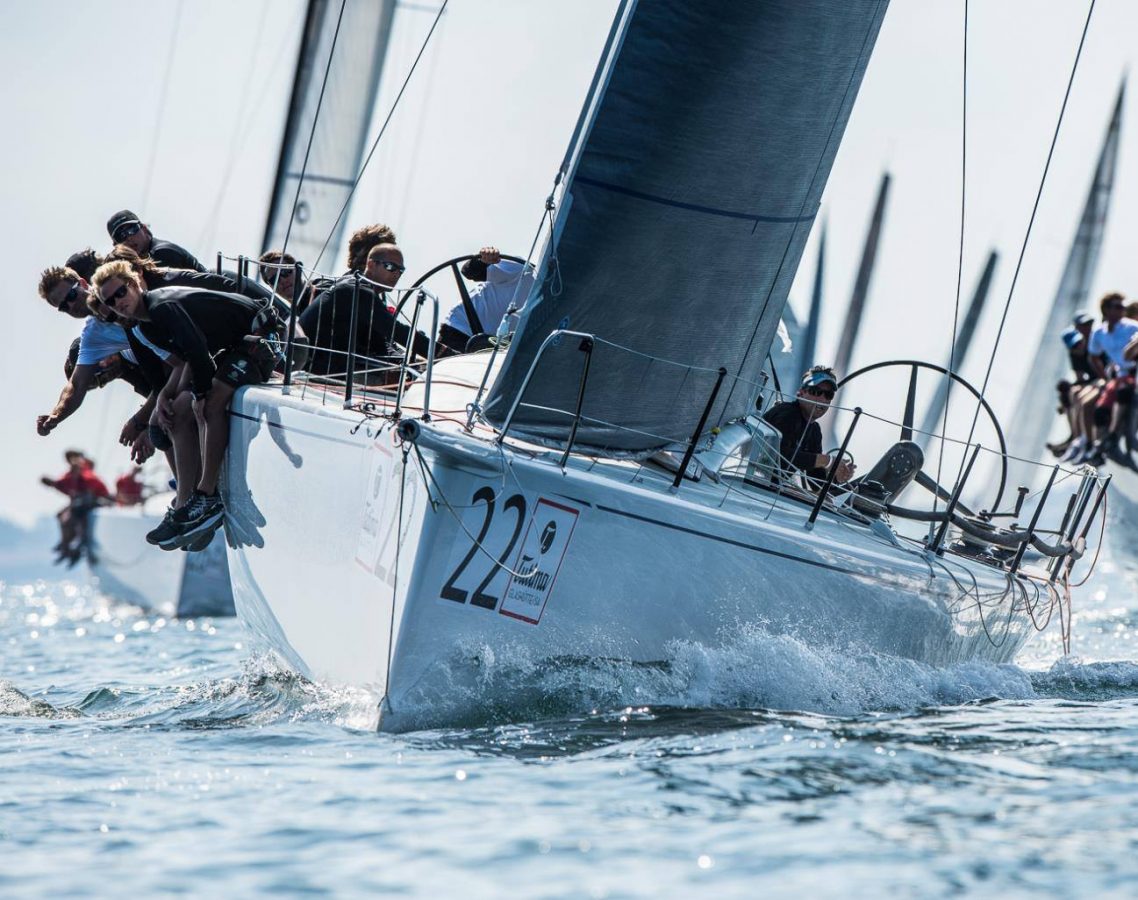
NORTH U VINTEREN 2018
NORTH U VINTEREN 2018
Mandag 15. januar starter vi opp vinterens North U Forum foredragsserie.
En gang i måneden, vinteren igjennom holder vi et spennende kveldsseminar i våre lokaler i Leangbukta, Asker. På programmet nå i januar står riktig og god seiltrim. Vil du vinne regattaer må du gjøre få feil, seile fort og taktisk i riktig retning. Riktig seiltrim gir god fart og da blir det enklere å seile godt taktisk.
Speed makes you look good!
Dette North U Forum viser deg hvordan på en god og lett forklart måte. Benytt anledning til å få kjennskap til teknikkene, systemene og trimmetips som benyttes av de beste båtene og ombord i de beste lagene. Dette vil sette deg og mannskapet ditt i stand til å komme raskere i mål i årets regattaer!
Sted: With Marine , Leangbukta Maritime Senter
Dato: 15. januar 2018
Tid: 19.00 - 21.00
Foredragsholder: Thomas Nilsson
North U Forum er åpent for alle og begrenset til 100 deltagere. Prisen er kr 100,- Betaling Vipps til With Marine 96644. Påmelding er bindene og gjøres på link under:
PÅMELDING
NB! Det blir North U Forum også 12. februar (båthåndtering) og 12. mars (tema ikke fastsatt).
Sett derfor et stort kryss i kalenderen disse datoene.
READ MORE
READ MORE
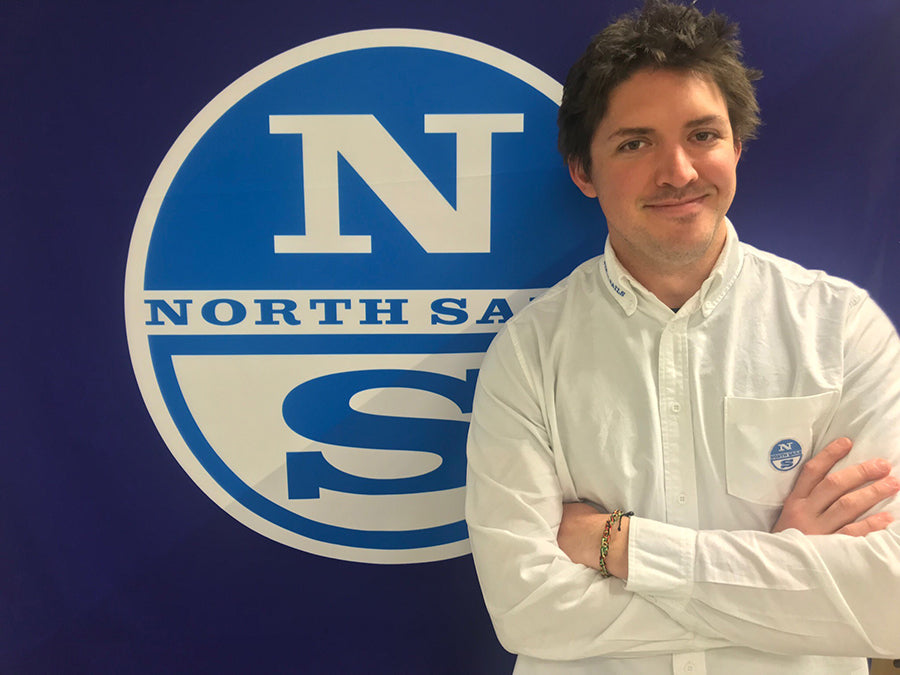
MEET MR HODGSON
MEET MR HODGSON
Matt Hodgson kan kanske beskrivas som en klassisk sailbum. Han har i vart fall fört ett ganska kringflackande liv, och segling och segel är egentligen det enda han har ägnat sig åt sedan han lämnade skolan. Men nu börjar han närma sig de trettio och är stabilt parkerad på landbacken, åtminstone under veckodagarna. Sedan februari 2017 jobbar han nämligen som säljare på vårt Lidingöloft. Man kan säga att cirkeln därmed är sluten. För det var just här hans karriär började för nästan exakt elva år sedan.
Sydney-Lidingö på enkel biljett
Matt är född i Melbourne och uppvuxen på landet utanför Sydney. Det är inget dåligt ställe om man gillar att segla, men han bestämde sig redan i tonåren för att han skulle till Europa. Ambitionen var att bli professionell seglare och han trodde att möjligheterna för det var större här än i Australien.
Så vid 18 års ålder satte sig Matt på ett plan – och hamnade hos oss på Lidingö. Han hade ingen erfarenhet av branschen och kunde inte ett ord svenska. Men att bli segelmakare ingick i planerna för proffskarriären, och det faktum att vi strax därefter fick i uppdrag att göra seglen till Team Ericsson i Volvo Ocean Race gjorde inte saken sämre.
Det blev 21 ganska intensiva månader hos oss. Men så småningom ebbade Ericsson-projektet ut och Matt sökte sig vidare i både världen och karriären. Det var nu livet i kappsäck tog fart på allvar.
Sedan dess har han varit med om lite av varje, både som professionell seglare och segelmakare. Som seglare har han exempelvis slagit alla tänkbara hastighetsrekord med den franska foilande trimaranen l´Hydroptére. Ett särskilt minnesvärt datum är den 4 september 2009 då de seglade 500 meter med en snittfart på 51,36 knop, vilket innebar världsrekord. De slog även rekordet över en sjömil (50.17 knop).
Andra meriter som ligger Matt nära om hjärtat är en silvermedalj i classic-klassen på R8-VM 2014, ett antal guld på finska mästerskap och en andraplats i Tour de France 2011, som i Frankrike rankas som en av de absolut mest prestigefyllda seglingstävlingarna.
Tekniskt sett är en foilande flerskrovsbåt och en klassisk R-båt ungefär så långt ifrån varandra man kan komma inom seglingen, och däremellan har Matt täckt in det mesta, från superyachts och TP 52:or till entyp och mindre IRC- och ORCi-båtar. Han har seglat mycket i Frankrike, Finland och Italien, men en hel del även i Sverige och Australien.
Segling med livet som insats
Segling är inte någon särskilt farlig sport men Matt har varit illa ute ett par gånger.
Som när han 2008 gjorde sitt första Gotland Runt. Racet tog slut utanför Hoburgen när trimaranen han seglade – en SeaCart 30 – började brinna. Hela mittskrovet försvann, och i det låg all säkerhetsutrustning, inklusive livflotte, flytvästar och nödraketer. De fem personerna i besättningen blev sittandes på ena sidoskrovet i sju timmar innan de plockades upp av en av Gotland Runt-deltagarna. ”Kändisadvokat hjälte i sjödrama” löd rubriken i Aftonbladet, ty i besättningen som undsatte de nödställda ingick advokaten Claes Borgström. Det är tydligen seglare av den kalibern som krävs för att massmedia ska intressera sig för kappsegling.
Det där kunde slutat riktigt illa. Än värre var när han blev upphissad i l´Hydroptéres 27 meter höga mast och schackeln till båtmansstolen plötsligt brast. Han föll fritt någon meter men lyckades mirakulöst få armarna om förstaget.
Allting gick oerhört fort, men när Matt tänker tillbaka på händelsen är det som att se en film i ultrarapid. Ögonblicket när han hängde i förstaget och tittade ner på däck är nästan som en stillbild. ”Jag kommer aldrig glömma ansiktsuttrycken på killarna nere på däck”, säger han. ”De var övertygade om att jag skulle dö.”
På något sätt lyckades han ändå fira sig ner genom att glida längs förstaget och landade förhållandevis välbehållen på däck. Men det tog på krafterna och chocken satt i länge. ”Jag darrade som ett löv och har aldrig varit så utpumpad i hela mitt liv.”
Ärmarna på jackan han hade på sig var full av brännmärken och händerna blodiga. Ärren är kvar än idag och utgör en ständig påminnelse om att ingen är odödlig.
Massor av branschrutin
Äventyren i segelbranschen har varit betydligt beskedligare. Matt har varvat professionell segling med jobb som segelmakare och har som sådan varit runt lite varstans. Efter den första vändan hos oss på Lidingö gick han till North Sails på Palma de Mallorca, ett loft som är specialiserat på superyachts. Han har jobbat på Doyle i Melbourne och ett tag var han på Gransegel i Stockholm.
Den längsta perioden har han annars ägnat åt Doyle Sails i Helsingfors, som han ägde och drev under tre-fyra år. Det var en rolig men intensiv tid med otroligt mycket jobb. Kanske lite väl mycket, framför allt med tanke på att han vid det här laget hade bildat familj.
Så han avslutade sitt engagemang i Helsingfors och började titta sig runt efter alternativ. När så Björn Österberg slutade på North Sails Lidingö för att ta hand om skidshopen i Funäsdalen blev det en position ledig, och sedan februari i år är Matt tillbaka på loftet där allting på sätt och vis började.
Skillnaden är att han nu är elva år äldre och betydligt mer erfaren – och att han numera faktiskt pratar riktigt bra svenska.
READ MORE
READ MORE
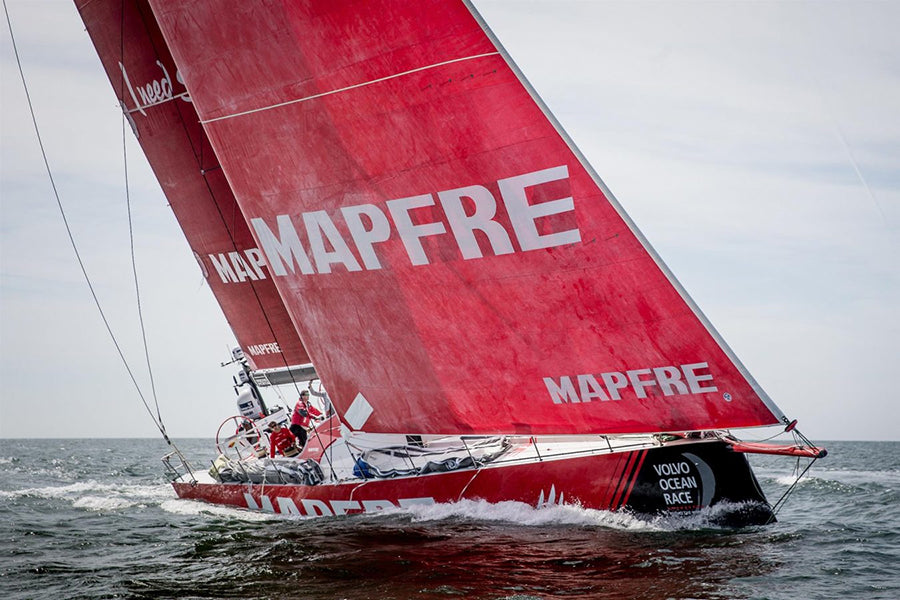
SVENSK INNOVATION I VOLVO OCEAN RACE
SVENSK INNOVATION I VOLVO OCEAN RACE
Rent tekniskt innehåller årets upplaga av Volvo Ocean Race inga större nyheter. Man seglar ju i samma 65 fots entypsbåtar som förra gången, och även segelgarderoben, som utvecklats och levererats av North Sails, ser ungefär likadan ut som tidigare. Dock med ett undantag: I år är båtarna utrustade med varsin Jib Zero – en segeltyp som innan starten beskrevs som ”revolutionerande”, och som rapporterats ha satt griller i huvudet på besättningarna, eftersom de inte riktigt vet hur (och när) seglet ska användas för att ge maximal effekt.
Frågan är bara hur nytt det egentligen är. Segeltypen har nämligen funnits i över fem år. Och det är faktiskt en svensk uppfinning.
Jakten på ett segel som inte fanns
Det hela började 2012, då North-loftet på Lidingö fick i uppdrag av den dåvarande Dufour-importören att sätta fart på en Dufour 36 Performance, som då var ny på marknaden.
Det är en ganska tidstypisk cruiser/racer, ritad av Umberto Felci, med rak stäv, bred akter och djup T-köl. Dessutom fin invändigt och med ett tilltalande utseende.
Typiskt är också att den precis som många andra båtar med ursprung på kontinenten kan upplevas som en smula underriggad, i alla fall för kappsegling i Stockholms skärgård. Eftersom vanten är placerade i relingen går det inte att segla med överlappande genua, och detta innebar att vi nu stod inför ett problem som det inte fanns någon känd lösning på.
Öppna bogar gick att hantera. Man kunde alltid hänga på exempelvis en Code Zero. Men man måste ju faktiskt räkna med att det även blåser framifrån ibland.
Första steget blev att maximera ytan på den befintliga riggen, men det gjorde bara marginell nytta. ”Vi insåg att det krävdes något mer drastiskt”, säger Martin Angsell som jobbade med projektet.
Uppgiften kunde definieras ungefär så här: Vad som behövs är ett plant segel som är betydligt större än focken – och som trots den breda stagningen kan skotas så nära centrumlinjen att det blir ett effektivt bidevindsegel.
Och något sådant segel fanns inte. Men det sägs ju att nöden är uppfinningarnas moder, och till slut kom man på en lösning som så här i efterhand kan verka enkel och nästan självklar: Om vi inte kan förlänga underliket bakåt, därför att vanten sitter i vägen, så får vi väl förlänga det framåt istället!
Till saken hör att Dufour 36P är originalutrustad med ett utskjutbart peke, så det var lätt gjort. Lösningen blev alltså att skota seglet på den befintliga fockskotskenan men halsa det på peket och hissa det från masttoppen. På så sätt kunde ytan ökas med över 30 procent.
Och det gjorde susen. Seglet gjorde väl inte Dufour 36:an till någon blekskenare, men besättningen behövde i alla fall inte känna sig slagen på förhand bara för prognosen lovade lätta vindar.
Hur fungerar det i praktiken?
Idag har vi på North Sails Sverige fem års erfarenhet av det här seglet. Det är inte det vanligaste seglet i sortimentet, men det har används på en lång rad båtar, som exempelvis XP33, J/111, Aspect 40, Farr 400 och Ker 40+. Det kommer också ingå i segelgarderoben på den nya J/121 under Seapilot2Star 2018.
”En Jib Zero är ett riktigt vasst vapen på kryss upp till cirka 7–8 knops vind”, säger Martin. På öppna bogar fungerar seglet som ett reaching-segel”, och det kan då riggas upp på en ’Reaching Strut’ som ökar skotvinkeln (se bild).
På kryss ligger maxstyrkan någonstans kring 10–12 knop. Dels därför att den vanliga focken vid den ”crossovern” är minst lika snabb, dels därför att krafterna börjar bli väl stora. Det handlar inte bara om att saker och ting ska hålla, utan även om att få upp tillräckligt hög förstagsspänning.
Det är ju ett främst ett bidevindsegel, byggt i stabila material, och även om det bara används i lättare vindar, så innebär det ändå att alla ingående delar – peke, mast, fall, avlastare med mera – utsätts för hårda belastningar.
Ju stummare desto bättre, lyder den enkla regeln. Peket bör ha någon form av stagning neråt, och det skadar inte om fallet kan avlastas i toppen med ett fallås.
Prestandamässigt gör seglet stor skillnad i det lägre vindregistret. Även mättalet påverkas förstås, men Martin tycker att seglet bedöms ganska rättvist enligt både SRS och ORCi. Att man trots detta sällan ser seglet på de mest ambitiösa ORCi-båtarna beror på att de ofta har siktet inställt på internationella mästerskap som EM och VM. Och där sätter seglingsföreskrifterna stopp för seglingar under sex knops vind. Eftersom seglet halsas framför förstaget måste det dessutom rullas både in och ut vid varje stagvändning, vilket gör det mindre lämpligt för bankappsegling i tajta fält.
Även namnet uppfanns på Lidingö
Det finns många fördelar med att vara en del i världens största segelföretag. En handlar just om utveckling: Det sitter ständigt klyftigt folk runt om i världen och funderar på hur segel kan förbättras, och det finns system som säkerställer att bra idéer förs ut i hela organisationen.
Det är klart att innovationer ofta kommer från de stora projekten i exempelvis Americas Cup och att de först så småningom hamnar på exempelvis en Dufour 36:a i Stockholms skärgård. Men ibland kan det alltså gå andra vägen.
Även beteckningen på seglet har för övrigt svenskt ursprung. Martin minns hur de brukade sitta i lunchrummet och spåna på namn. De fastnade till slut för just Jib Zero. Förutom att det beskriver ganska väl vad det är för typ av segel ska man nog se det som en liten blinkning till Code Zero. Idag är det en stapelvara hos världens alla segelmakare, men faktum är att även det seglet en gång i tiden utvecklades på Lidingö.
READ MORE
READ MORE
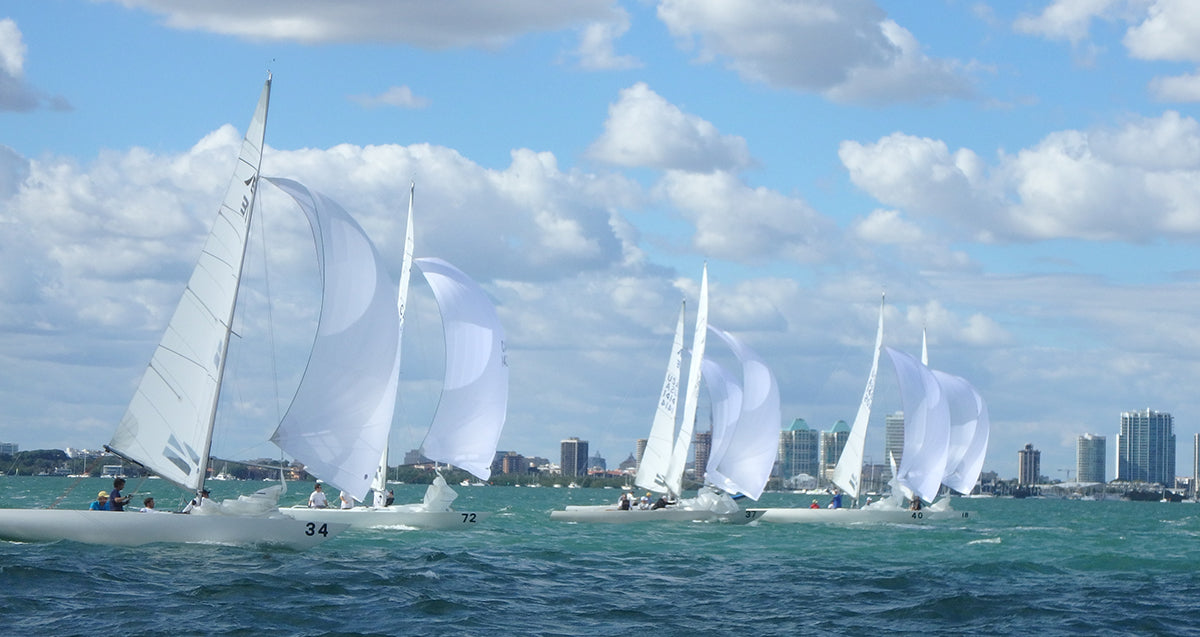
2018 ETCHELLS SID DOREN MEMORIAL REGATTA
NORTH ETCHELLS DESIGNS DOMINATE FLEET IN MIAMI
Jim Cunningham shows excellent performance at the 2018 Sid Doren
Thirty-eight teams made their way to Miami for the second event of the prestigious 2017-2018 Key Biscayne Series – the Sid Doren Memorial Regatta. There were Winter storms up and down the East Coast, some stretching as south as Miami, and big breeze and cooler temps were forecasted.
Team Lifted with skipper Jim Cunningham and crew of Jeff Madrigali, Mark Ivey and Serena Vilage repeated their win at the first event of the winter series, the Louis Piana Cup back in December, by sweeping the 38-boat fleet in five races using the North PC-FM mainsail, GM jib and Full Radial spinnaker.
“We are proud of the results North clients are achieving with our designs. Nine of the top ten boats used full North Sails inventories”, said North expert Skip Dieball. “For my team on War Canoe, we used a brand new PC-FM main. Our speed was noticeably better and we were happy with a third place finish. The radial head really allows for more control in the upper section”.
2018 Sid Doren Memorial Regatta
1
Lifted / Jim Cunningham
2
SCIMITAR / Steve Benjamin
3
War Canoe / Michael Goldfarb
4
Tiburon / Mark Watson
5
Skanky Gene / Jay Cross
6
Gumption3 / Kevin Grainger
8
Blacadder II / Andrew Cumming
9
America Jane II / Scott Kaufman
10
Freedom / Craig Mense
* Denotes Partial North Sails Inventory
Full Results
Find out more about our regatta-winning Etchells products
READ MORE
READ MORE
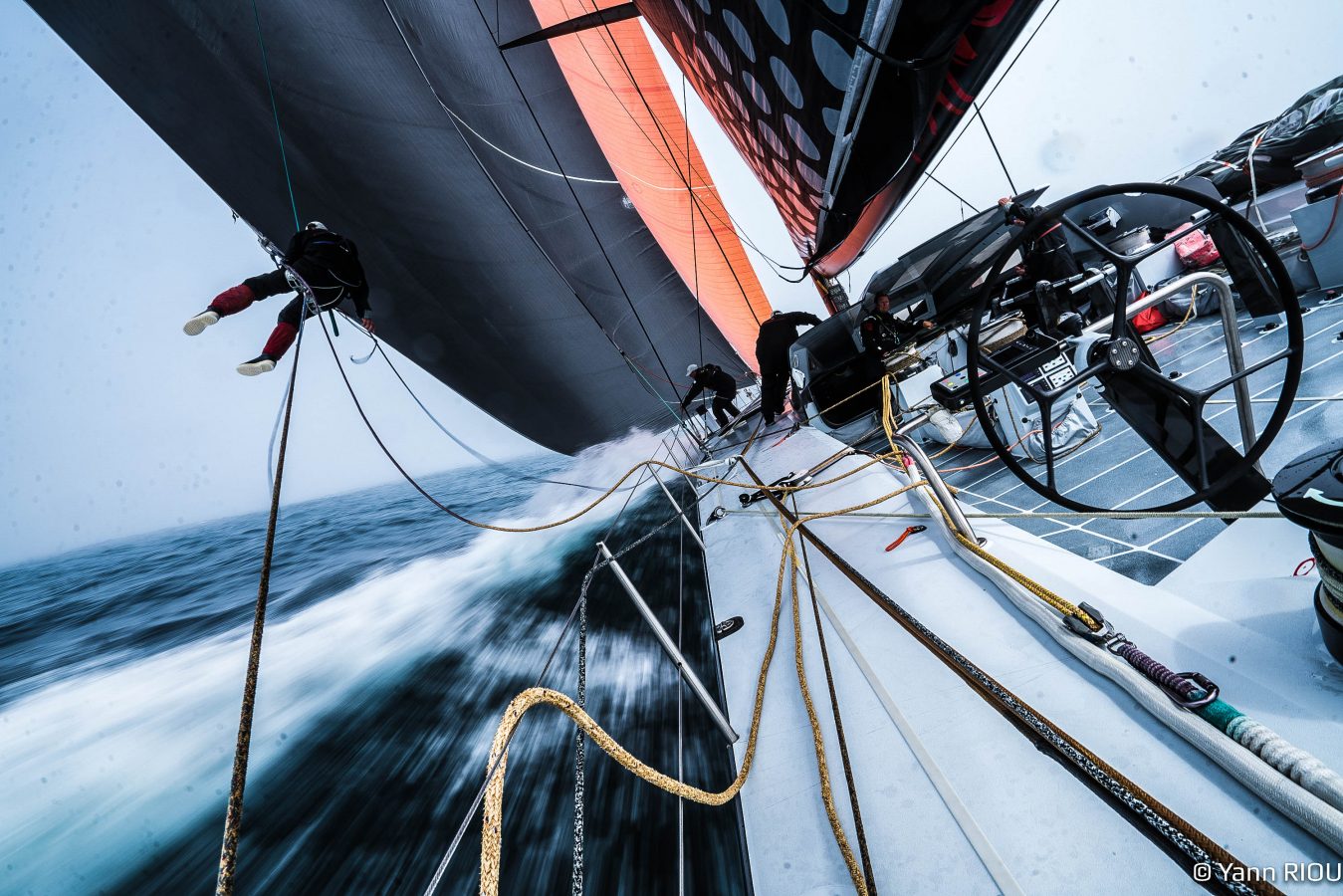
NORTH SAILS OFFICIAL PERFORMANCE PARTNER FOR 2018 NEWPORT - BERMUDA
NORTH SAILS OFFICIAL PERFORMANCE PARTNER FOR 2018 NEWPORT-BERMUDA
© Yann Riou
North Sails, the world’s leading sailmaker, today announced that it will join the prestigious Newport to Bermuda Race as Performance Partner for the 2018 edition. The event is a 635-mile biennial distance race that draws an international fleet and includes a range of yachts from Super Maxis to Corinthian cruisers. The race, that prides itself on accessibility for a wide variety of sailors, is a great test of blue-water seamanship from historic Newport to the beautiful shores of Bermuda.
As Performance Partner, North Sails will be working with participants to help them optimize their offshore sail inventories. North will be hosting three seminars where North Sails experts, and race veterans, will be on hand to answer questions and discuss sail choices and weather routing for the race. The seminars will be held in Annapolis, MD, Portsmouth, RI and Stamford, CT.
North Sails has a long history with the Newport Bermuda Race, powering a huge number of boats including many to race victories. Most recently, Comanche carried a full North Sails inventory when she set the current race record and Warrior Won was fully outfitted with North Sails when she captured the St David’s Lighthouse Division in 2016. North Sails has more offshore miles, around the world records and ocean racing victories than all other sailmakers combined and prides itself on having the best sail solutions for boats across the spectrum. Much of North Sails’ offshore success can be attributed to their unique 3Di technology that delivers speed, durability and reliability for all that use it.
“The Newport Bermuda Race a classic a race on par with the likes of the Fastnet, Sydney-Hobart and Transpac,” said North Sails President and race record holder Ken Read. “The East Coast can serve up a variety of weather conditions in mid-June and having a sail inventory that can take you through a variety of conditions is a game changer. With a range of 3Di upwind and recently introduced downwind sails, North offers a high performance yet incredibly durable choice that we believe can make the race enjoyable for all participants.”
Those interested in attending one of the Performance Seminars, click here.
READ MORE
READ MORE
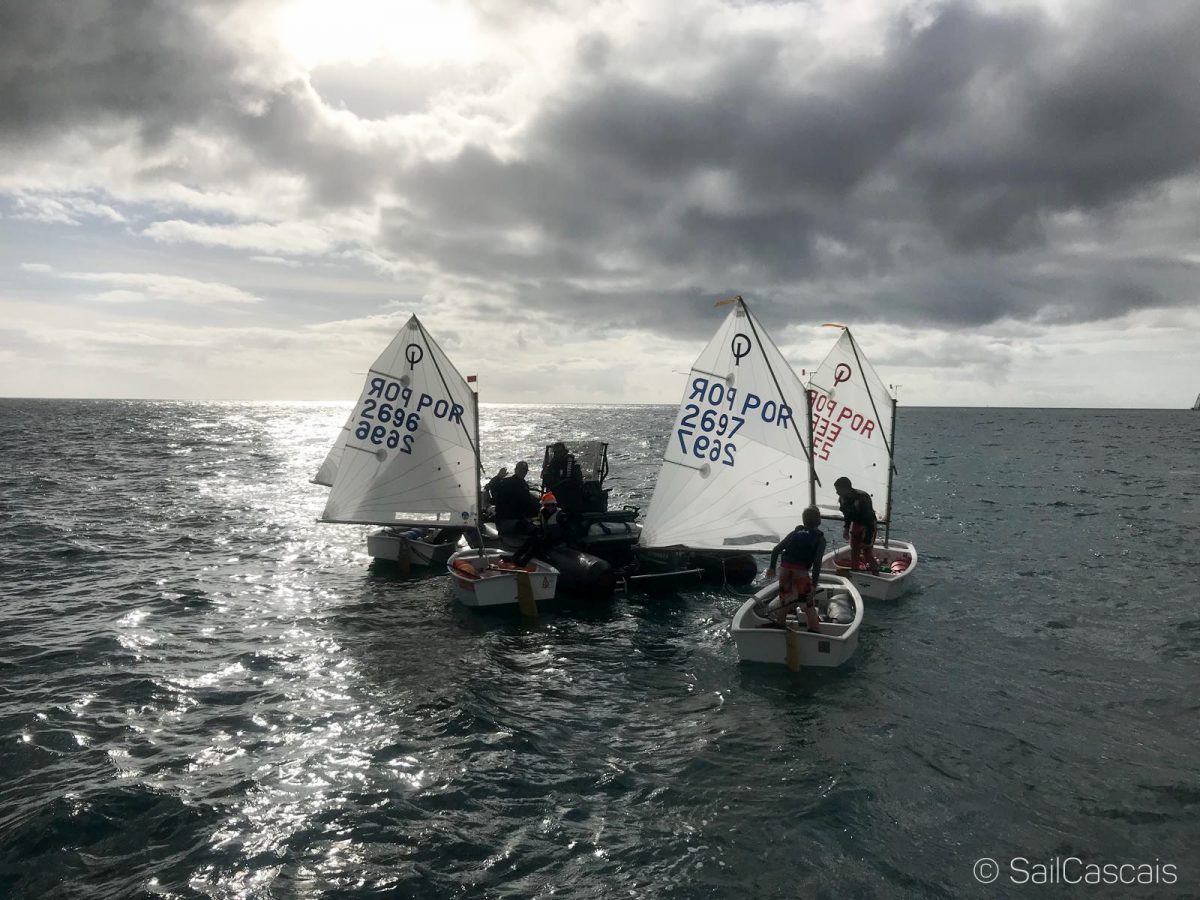
NORTH SAILS REALIZA CLÍNICA DE OPTIMIST EM CASCAIS - 2017 IN REVIEW
Clínica Optimist em Cascais
Photo Credit: SailCascais
Nos passados dias 08, 09 e 10 de Dezembro de 2017, realizámos uma Clínica de Optimist para os velejadores do CVTejo. A acção teve lugar em Cascais, com o apoio da Marina de Cascais e da Yachtworks.
O especialista da North Sails, Vicente Pinheiro, colocou como principal objectivo desafiar os velejadores a ganhar velocidade através do optimização da utilização da sua vela e para tal realizámos um programa teórico-prático, durante três dias.
Neste início de época, os velejadores tiveram a oportunidade de participar numa acção de conceito e dinâmica diferente, aprendendo a fazer uma focagem mais técnica na sua vela e a retirar dela o maior potencial.
Os velejadores foram desafiados a observar a sua vela de uma forma mais científica e técnica, experienciando a noção de “causa-efeito” nas diferentes actividades realizadas.
Contrariando o habitual cenário de vento forte de Cascais, ao longo dos três dias fomos presenteados com ventos de 6 a 16 nós de O/NE, permitindo que se trabalhassem diferentes afinações das velas.
Focados no desafio do aumento da autonomia do velejador e do estímulo do trabalho em equipa na água trabalhamos as North Sails R-1 e R-4.
O balanço final foi bastante positivo,os velejadores conseguiram identificar os seus progressos em termos de aquisição de novos conteúdos e conceitos e demonstrar a sua aplicabilidade dentro de água.
Salvador, 11 anos, utiliza a vela R-4
“ Eu gostei do fim-de-semana porque aprendi noções técnicas sobre as velas e de como as potencializar.
Aprendi como andar com mais velocidade a partir do que a vela tem para dar.
Gostei!”
Deixamos aqui o nosso especial agradecimento à Marina de Cascais que disponibilizou as suas instalações e à Yachtworksque cedeu o seu semí-rígido Zodiac 5.5Pro, contribuindo para o grande sucesso deste evento!
Dezembro 2017
READ MORE
READ MORE
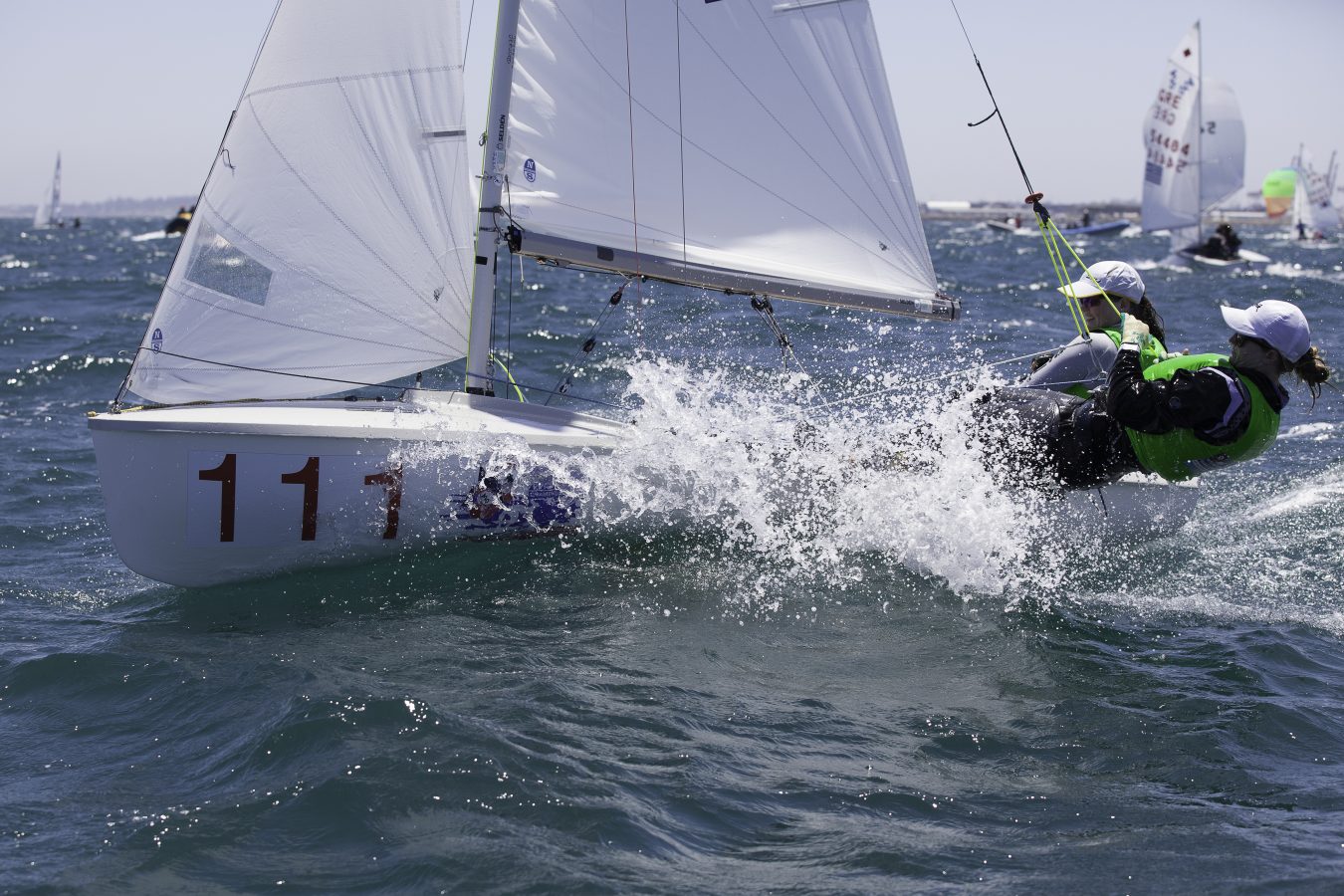
CLEAN SWEEP AT 420 WORLDS
CLEAN SWEEP AT 420 WORLDS
Teams powered by North Sails win all three divisions
Nia Jerwood & Monique DeVries © Bernie Kaaks
The 420 Worlds in Fremantle, Australia, kicked off the 2018 season for the 420 class. The big breeze event with big swell made for exciting sailing conditions for the fleets. The Spanish teams came out with fighting spirit, dominating the top three of the Open division and winning the U17 fleet. In the Open, a run of consistent top 10 results half of which in the podium position, ensured North Sails jockey’s Enrique Lujan & Pablo Lujan the win. In the U17 fleet another consistent event was raced by Martin Wizner & Pedro Ameneiro giving them a 3 point clearance securing the first place.
In the Women’s fleet Australians, Nia Jerwood & Monique DeVries had the home side advantage and used this to come away with the women’s title. Although they were tied on points with second placed boat, 6 bullets on their scoreboard ensured their victory.
Congratulations to all teams sailing with North Sails inventories and good luck for the rest of 2018, this was a fantastic start to the season.
North designs used by the World Champions:
Open: M-9 mainsail, J-13 jib, S-05 Spinnaker
Ladies: M-9 mainsail, J-12 jib, S-01 Spinnaker
U17: M-9 mainsail, J-12 jib, S-05 Spinnaker
If you are interested in any North Sails 420 products, contact your class expert.
Enrique Lujan & Pablo Lujan © Bernie Kaaks
Martin Wizner & Pedro Ameneiro © Bernie Kaaks
420 World Championship
Open
1
Enrique Lujan & Pablo Lujan
2*
Albert Torres & Francisco Mulet
4
Enzo Balanger & Gaultier Tallieu
5
Thomas Andre & Justin Baradat
9
Eduard Ferrer & Carlos De Maqua
10
Elias Aretz & Pablo Garcia
Ladies
1
Nia Jerwood & Monique DeVries
4
Sophie McIntosh & Orla Mulholland-Patterson
6
Sophie Jackson & Laura Thomson
7
María Caba & Pilar Caba
8
Solène Mariani & Maude Schmid
9
Clara Olive & Solenza Mariani
Under 17
1
Martin Wizner & Pedro Ameneiro
4
Pol Marsans & Alex Marsans
5
Jack Lewis & Charlie Bacon
7
Tommaso Salvette & Giovanni Sandrini
8
Ariadni-Paraskevi Spanaki & Myrto Papadopoulou
* Denotes Partial North Sails Inventory
READ MORE
READ MORE
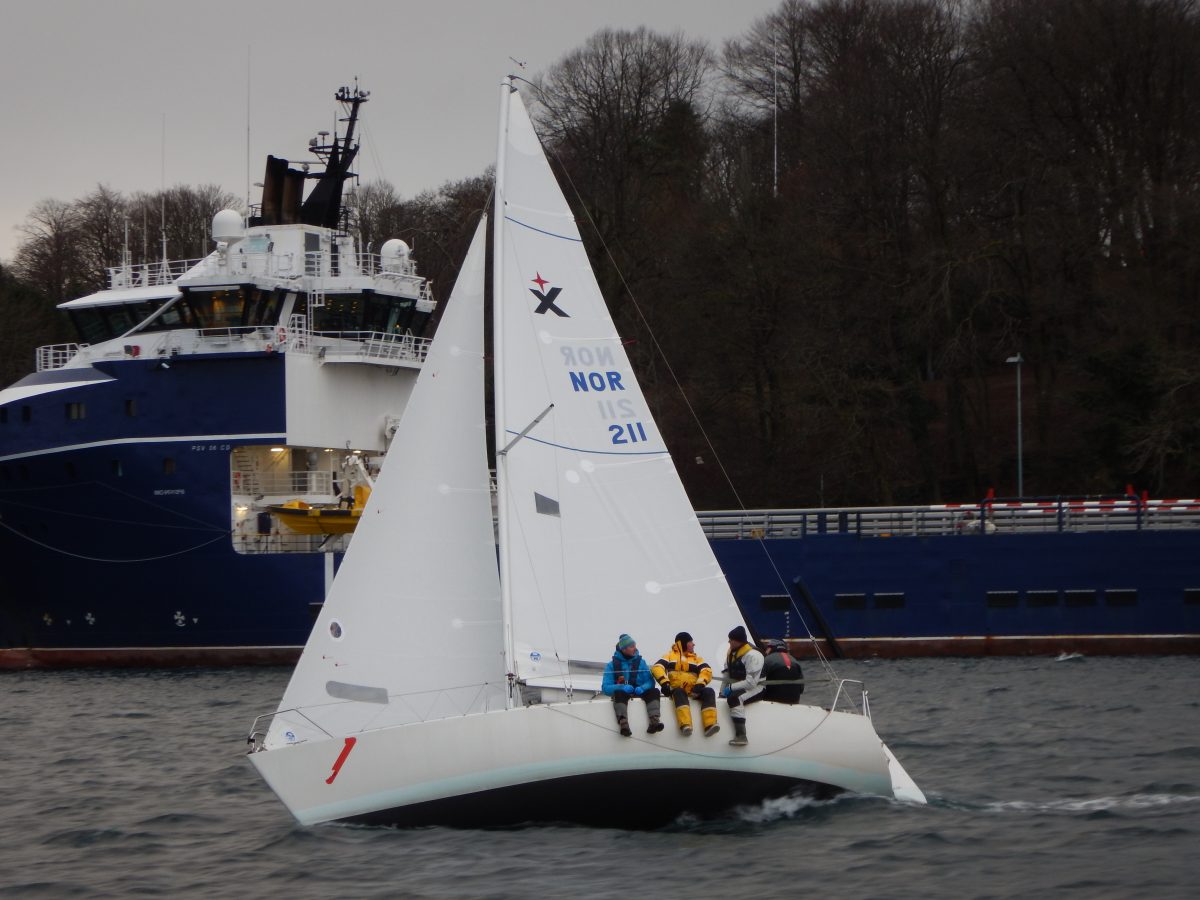
NYTTÅRSSEILAS I STAVANGER - VI ER MED!
NYTTÅRSSEILAS I STAVANGER - VI ER MED!
6. januar er det igjen klart for årets første regatta i Stavanger!
Fars Cortina, vinner av Nyttårseilasen 2016
Tradisjonen tro stiller North Sails med mikrofon og kameramann for å dokumentere det hele. Filmen vil bli vist på De røde sjøhusene etter seiling.
Vi tar med oss North Sails bilen, så det vil være mulig å levere inn seil til service. Ta kontakt med Henrik Terjesen
(tlf 90914942) / Christen (tlf 90730000) for innlevering av seil eller hvis det skulle være noen andre spørsmål.
Vi gleder oss!!!
Lever inn seil for service, vask eller reparasjon.
Ekspertkommentator Christen With under Nyttårsseilasen i 2016
READ MORE
READ MORE
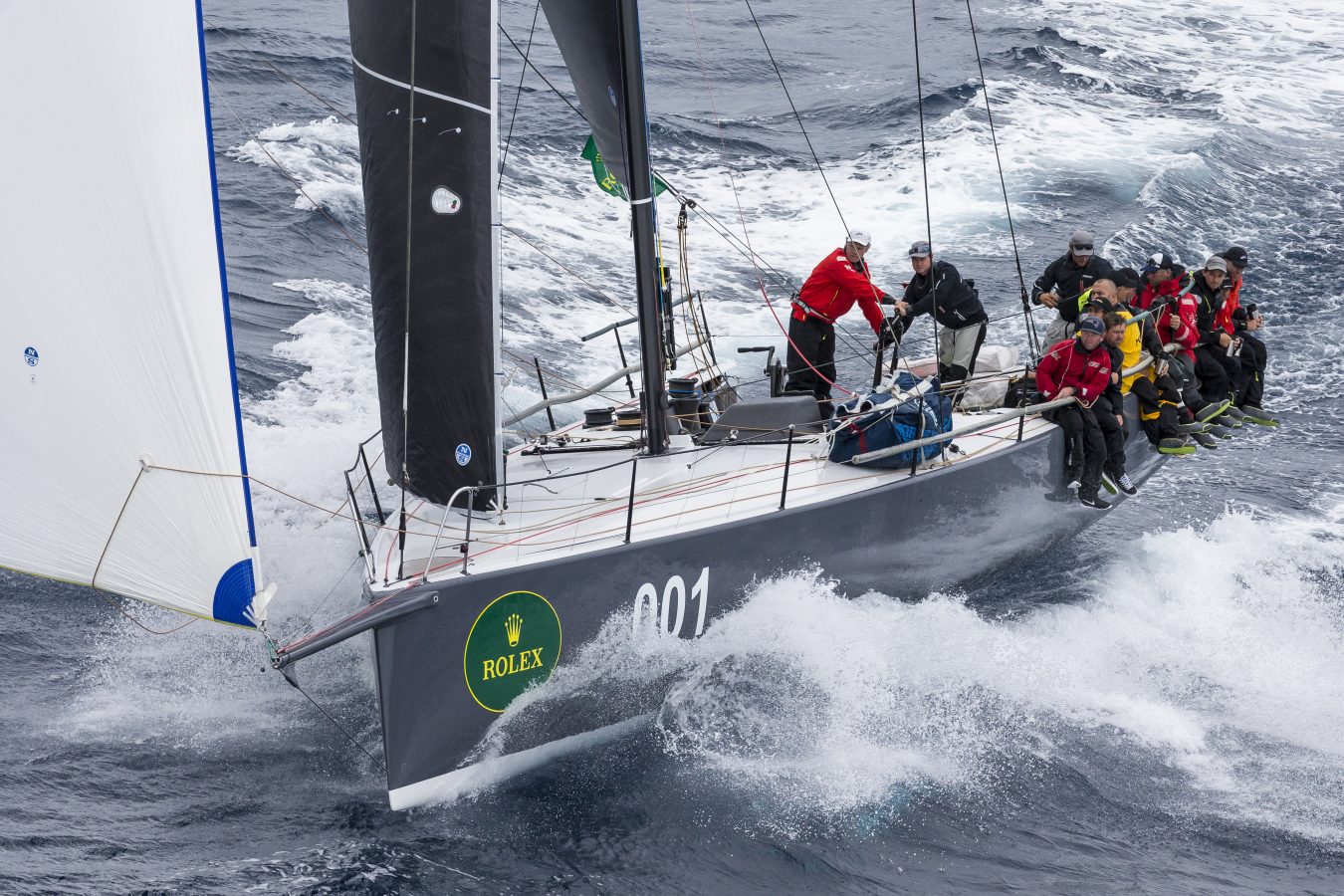
LONG TIME NORTH CUSTOMER WINS ROLEX SYDNEY HOBART
LONG TIME NORTH CUSTOMER WINS ROLEX SYDNEY HOBART
Winning the RSHYR takes determination, preparation, and a well thought-out sail inventory
Matt Allen, a long-time North Sails customer, first won the Rolex Sydney Hobart Race 34 years ago. In 2017, he finally repeated the achievement on Ichi Ban when they were named overall winner of the Rolex Sydney Hobart Race. It was a fitting honor for a boat whose name translates to “number one” in Japanese. The win this year was even sweeter considering that Matt’s new TP52 is only three months old.
Billy Sykes, a member of the North Sails team in Sydney (AUS), was part of Matt’s crew on the legendary race. We recently caught up with Billy to talk about what it takes to win the RSHYR on a brand-new boat.
“The boat was fresh out the packet, which always brings the opportunity for things to go wrong because gear has not been tried and tested. But we managed to put all those things behind us and come away with the win for Matt, which was a great thing.”
Can you take us through the race and any key decisions the team made?
“The RSHYR is 628 nautical miles and unlike inshore racing, the start isn’t everything. That was certainly good for us as we were well out the back door at the beginning. But we know Sydney Harbor well and we managed to wiggle through and get back into a competitive position by the time we got to the top mark. I think we were the first to actually put up our (new) 3Di RAW Code Zero.
Matt had ordered that sail for the race and there is no doubt it helped us get back to where we wanted to be – at the front. From there, we just kept consolidating the whole way. This race was quite unique for a number of reasons; firstly we got to the bottom of Green Cape at six AM the morning after the start, which is exceptional considering this is almost the halfway point. And secondly, we did the whole race in one weather system, which is pretty extraordinary for a 52 foot yacht.
The moment we got our break was when we put up our A4 spinnaker again, which is our largest masthead spinnaker. We had a reef in the main and putting the A4 up was quite a big move, but Quest was pushing us really hard down the coast, so we didn’t have a chance to back off, we had to keep pushing too. We were on the edge of our seats with it up, as the sea state was all over the place and it was blowing hard.
The other important moment was when sailing master Gordon McGuire and navigator Will Oxley made the decision to take us about 15 miles past the layline to set us up for a big shift. It was a great call that essentially got all of our time back on Quest. Then we got into Storm Bay and had our Code Zero and jib up around Cape Raoul up to the Iron Pot, and after we got past the Iron Pot we actually got becalmed in the Derwent for about 25 minutes which was really stressful for the whole team But we managed to get through that little transition back into the breeze and get through to the finish.”
How was the mood onboard after crossing the finish line in Hobart?
“There was a bit of a nervous wait because we guesstimated we owed Quest about 40-45 minutes on corrected time. So we dropped the mainsail and were all pretty keen to hang around for the final result, because we knew if we beat Quest we would have a real chance to get the Tattersalls Cup. We had no control over the corrected finish times but to have made sure that we had as much time as possible on Quest was a real big deal.”
What did you enjoy the most about the race, other than winning?
“The challenge of downwind running pretty much the whole way. This is my twelfth RSHYR and I’ve never seen two years in a row where you’ve been hard running down to Tasman Island. We actually broke two race records this year; the ballasted record set and held by Brindabella in 1999 and the under 18.5 metre yacht record set by Yendys in 2008. The last bit into Tasman Island, hard running in 24 – 30 knots with our biggest masthead spinnaker up, was very challenging but also made for some amazing sailing.”
In one article, Matt Allen attributed the win to the latest technology and design and the most amazing crew he’s ever sailed with. Can you explain what he meant about the latest technology and design?
“Matt had a plan long before Ichi Ban came out of the shed. He bought the old Shogun and made quite a few changes to make it really ready for offshore sailing. Then after last year’s race Matt decided to build a new yacht and took all the things he’d learnt from the previous boats into the new Ichi Ban. It is a Botin design, Adolfo Carrau specifically who was behind it, and they did an exceptional job. The other part of the design would be the Southern Spars mast and working so closely with us on sails. All these things together made a huge difference in how hard we were able to push. In all the development, you’d have to also mention also Tim Sellers the boat captain. He did a great job getting the boat race ready in just three months. But the planning, thought and research that Matt and the team did before the build even started made Ichi Ban the race winning boat it is.”
Can you give us a run through of the sail inventory and how it was matched to the conditions that you had?
“Obviously we had the offshore main (North 3Di RAW 870), which already had one RSHYR on it. And the offshore A4 (NPL Downwind), which is a serious downwind sail we designed specifically for the RSHYR.
The entire North Sails team worked hand-in-hand with Matt on his sail inventory; the mainsail, headsail, and spinnakers. Especially on what DPI we were going to use for each upwind sail. Matt was instrumental in making sure we constructed the headsails and spinnakers out of stronger materials, to give the sails a wider wind range offshore.”
“The mainsail was bulletproof. We never really question the durability when suggesting a 3Di sail. An offshore race like the RSHYR is unforgiving on sails; chafe, high loads, etc. This main also did the 2016 race where it took an absolute beating. But we could go sailing with it tomorrow and there’d be no problem. Holding up in that type of pressure is proof what an exceptional product 3Di is.”
READ MORE
READ MORE

RACE RECORDS
SLÅTT, BRUTT, KNUST.
Det er hva som skjedde med mange rekorder i 2017, et minneverdig år for våre kunder og North 3Di.
I januar seilte Armel Le Cleác'h alene rundt jorden på 74 dager, 3 timer, 35 minutter og 46 sekunder og slo derved rekorden rundt jorden alene i en ettskrogsbåt. I sommer, falt rekordene raskere enn vi kunne følge med på; Round the Island (Isle of Wight), Transpac, Transatlantic og mange fler. Thomas Coville har nå rekorden i å slå flest rekorder innen seiling I løpet av et år!
I desember rakk Francois Gabart julefeiringen i Frankrike da han med “MACIF” sikret seg “solo around-the-world record” ved å seile rundt Jorden på 42 dager, 16 timer, 40 minutter og 35 sekunder. Årets siste rekord gikk til LDV Comanche som satte ny rekord i Rolex
Sydney - Hobart Races (1 dag, 9 timer, 15 minutter og 24 sekunder).
Og med det, skåler vi for seilerne som flytter grensene sammen med produktet som gjør det mulig.
READ MORE
READ MORE
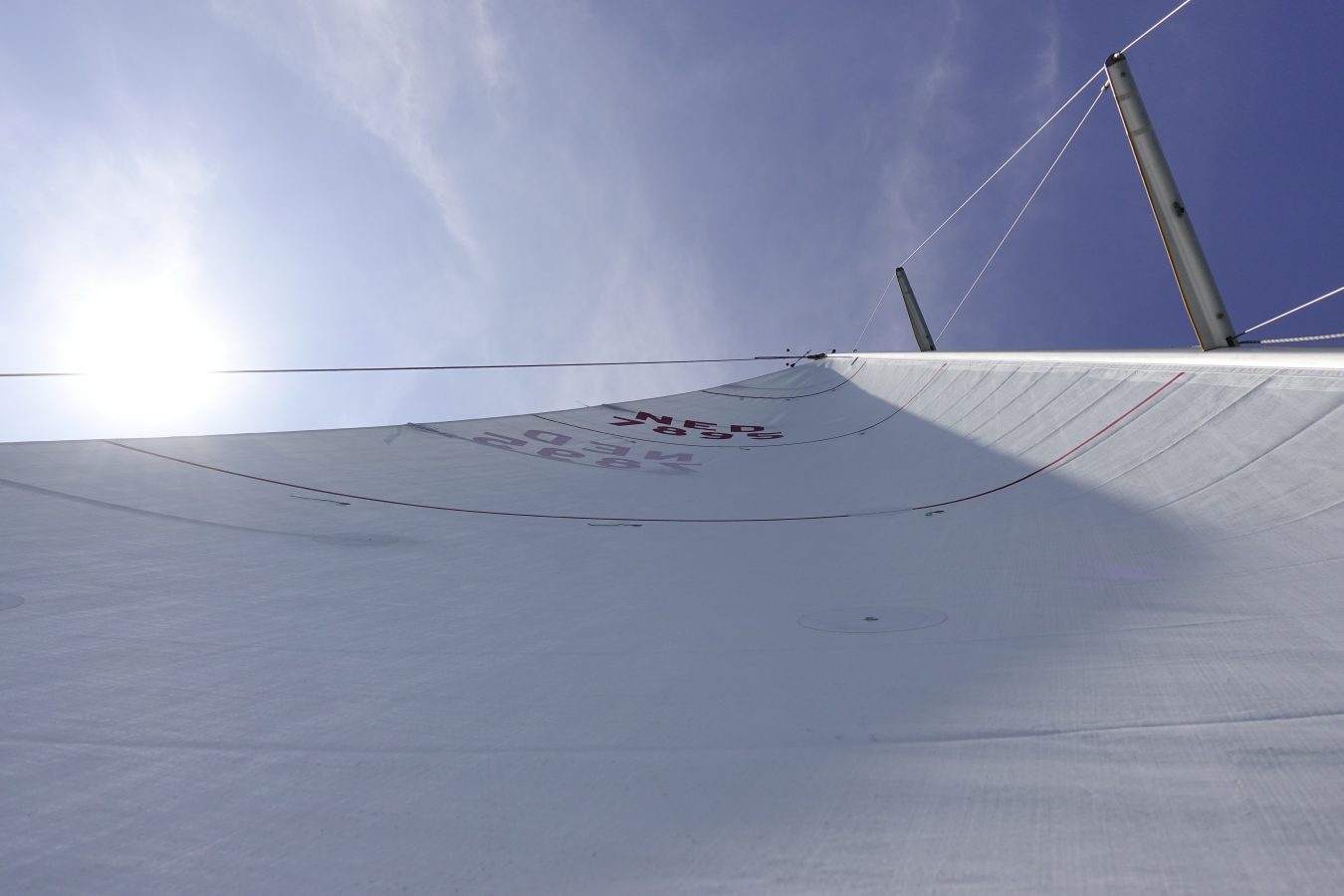
DUTCH QUARTER TON CUP 2018
Dutch Quarter Ton Cup 2018
Vanaf het eind van de jaren ’60 functioneert de ¼ ton klasse als een van de meest succesvolle zeilklassen die er wereldwijd is. Toegankelijk omdat de boten betaalbaar zijn en men geen grote bemanning nodig heeft om ermee te varen. In de jaren '80 en '90 is het een tijdje stil geweest rondom deze bijzondere klasse. Vanaf 2013 wordt echter jaarlijks de Dutch Quarter Ton Cup (DQTC) georganiseerd en er zijn voldoende tweedehands 1/4 tonners op de markt om deze competitie uit te breiden.
DQTC
In de jaren ’70 zeilden deze kleine kajuitboten in Nederland regelmatig wedstrijd. Velden van meer dan 20 bootjes waren geen uitzondering. Een hele tijd hebben maar weinig ¼ tonners wedstrijd gezeild, maar daar kwam in 2013 verandering toen de eerste DQTC werd georganiseerd. Het evenement was een groot succes en de organisatoren besloten hier mee verder te gaan.
Het evenement is inmiddels uitgegroeid tot een kleine competitie, speciaal voor de vele jong bejaarde race orgels die in Nederland liggen. Er is gekozen voor een kleine competitie om ¼ ton eigenaren de kans te geven aan één of meerdere evenementen mee te doen.
Tweedehands 1/4 tonners te koop
In 2018 wordt de zesde editie van de DQTC georganiseerd en de organisatie hoopt wederom meer ¼ tonners te mogen begroeten dan in 2017. Er liggen genoeg snelle tweedehands 1/4 tonners te koop voor weinig, dat kan wellicht ook een handje helpen om mensen over de streep te trekken. Meer informatie is te vinden op www.kwarttonzeilers.nl
Agenda Dutch Quarter Ton Cup 2018
Onderstaande vijf evenementen tellen mee voor de DQTC, de punten van maximaal drie evenementen tellen mee voor de eindstand van de DQTC 2018.
1. Almere Regatta, 2 - 3 juni @ Muiderzand
2. Deltaweekend, 8 - 10 juni @ Zierikzee
3. Blue Water App Regatta, 16 - 17 juni @ Lelystad
4. Pampus Regatta, 8 - 9 september @ Durgerdam
5. 1/4 Ton Klassenkampioenschap, 15 - 16 september @ Muiden
3Di NORDAC voor kleine tot middelgrote zeilboten
Voor kleine tot middelgrote zeilboten transformeert 3Di NORDAC polyestervezel in prachtige naadloze zeilen uit één stuk, die uitermate sterk en duurzaam zijn en perfect voor performance cruising/club-racing toepassingen. North Sails 3Di NORDAC zeilen zijn dus ook uitermate geschikt voor 1/4 tonners met de ambitie om de DQTC te varen.
Enkele 1/4 tonners die met North Sails 3D-zeilen varen zijn de SECOND WAVE - (3DL-3Di Race), de BLACK PEARL (3Di NORDAC) en de Furi - Dehler Sprinta (3DL). Hylke Steensma en zijn zwager zijn eigenaar van de BLACK PEARL en hebben voor de zeilen gekozen vanwege de kwaliteit van North Sails: "De zeilen zijn voor ons weliswaar helemaal nieuw maar we hebben er vertrouwen in."
Neem voor meer informatie contact op met een North Sails expert in de buurt voor meer informatie!
READ MORE
READ MORE

73RD SYDNEY TO HOBART: A YEAR LIKE NO OTHER
73rd SYDNEY TO HOBART: A YEAR LIKE NO OTHER
North-powered clients raise the stakes higher than ever in 2017 with new records
© Rolex / Carlo Borlenghi
Months of preparation and weeks of anticipation culminated on Boxing Day for 102 yachts racing in the 2017 Sydney to Hobart Yacht Race. With wind speeds of 25-50 knots, sailors have to mentally prepare for a race as tough as this one from Sydney to Hobart, never forgetting the possibilities and unknown outcomes of their own fate. A legendary offshore race, the RSHYR puts sailors and their equipment to the ultimate test. The 73rd edition of the Rolex Sydney Hobart is one for the history (and record) books.
This year the meteorologist outlook provided a forecast that favored the big boats. A race of broad reaching and downwind sailing with a high probability for records to fall; a forecast suited for yachts built to sail off the wind. Competition was tough for boats in the 45-55 foot range, an “easy race” by historical standard, but by no means is the RSHYR ever easy. Starting out light around 10 knots then building to 25 in the Bass Strait and coast of Tasman, clients put 3Di to the test.
The top five boats and many in the fleet trusted North Sails 3Di to power their 628-mile adventure to Hobart. Being mostly a downwind race, 3Di launched the super-Maxis down the race track towards the finish line in Tasmania. LDV Comanche found her sweet spot using a full inventory of 3Di downwind, while Wild Oats XI and Black Jack have combined inventories of 3Di downwind and NPL gennakers.
Five boats finished within the race record of 1 day, 13 hours, and 31 minutes set by Perpetual Loyal in 2016. A controversial protest saw LDV Comanche replace the on the water winner Wild Oats XI as line honors winner and new record honor. A tough race win, and for all, a race by the rule book. The new race record is 1 day, 9 hours, 15 minutes, and 24 seconds.
Congratulations to Botin 52 Ichi Ban’s Matt Allen and crew for winning the overall corrected time Tattersall Trophy and having one of the fastest records for a boat their size in the history of the race.
© Rolex / Carlo Borlenghi
READ MORE
READ MORE
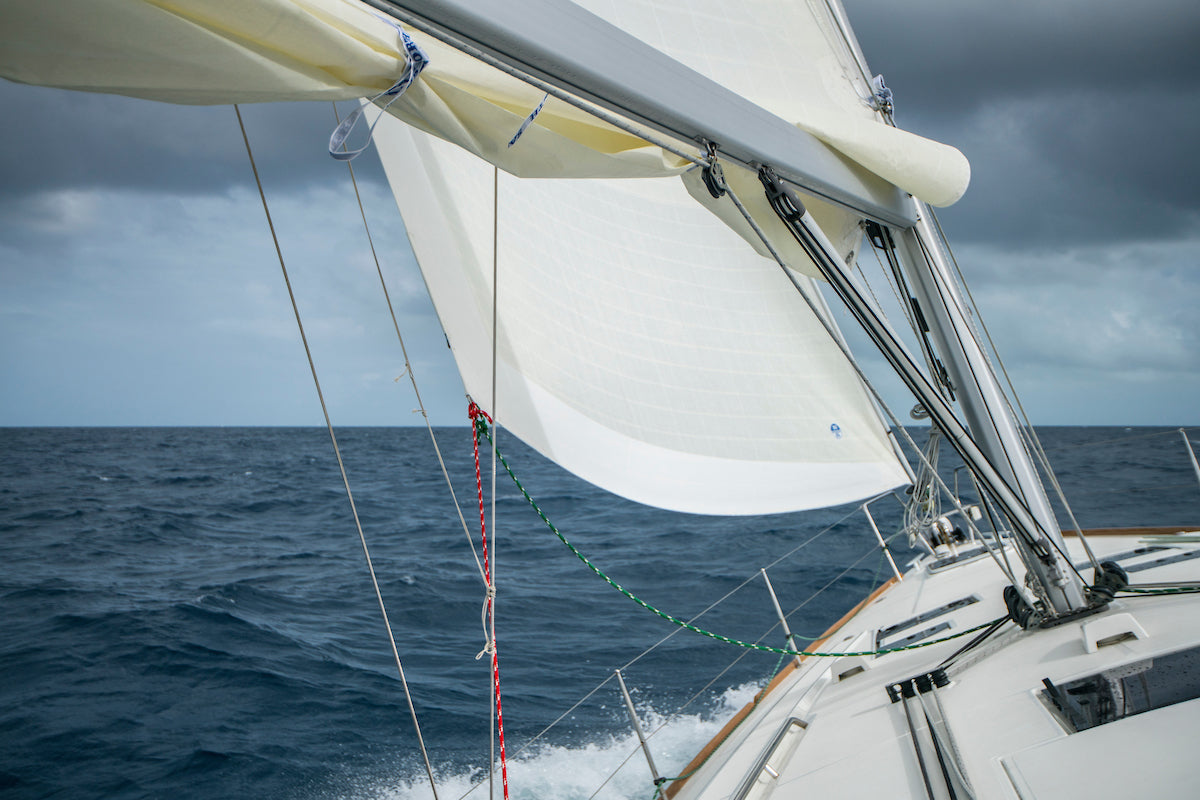
BEZOEK NORTH SAILS OP BOOT DUSSELDORF
Bezoek North Sails op Boot Dusseldorf
20 t/m 28 januari 2018
Het North Sails team heet u van harte welkom op Boot Düsseldorf van 20 tot en met 28 januari. Onze experts zijn te vinden in hal 11, standnummer H24. Tijdens de beurs is er elke dag minimaal één expert uit de Benelux aanwezig. We laten u graag kennis te laten maken met onze nieuwe producten, waaronder de nieuwe 3Di NORDAC zeilen. Hebt u vragen of wilt u een afspraak met ons maken? Neem contact op met één van onze experts.
3Di NORDAC
Afgelopen jaar introduceerden wij 3Di NORDAC, een innovatief en betaalbaar polyester zeil, gemaakt met onze unieke, gepatenteerde 3Di techologie. 3Di NORDAC combineert traditionele materialen met moderne, reeds bewezen 3Di productieprocessen en is speciaal ontwikkeld voor kleine en middelgrote toerboten. Dit baanbrekende product levert meer vormbehoud, duurzaamheid en comfort tijdens het zeilen. Bezoek ons op Boot Düsseldorf voor meer informatie.
Meer informatie over Boot Dusseldorf vindt u op https://www.boat-duesseldorf.com
READ MORE
READ MORE
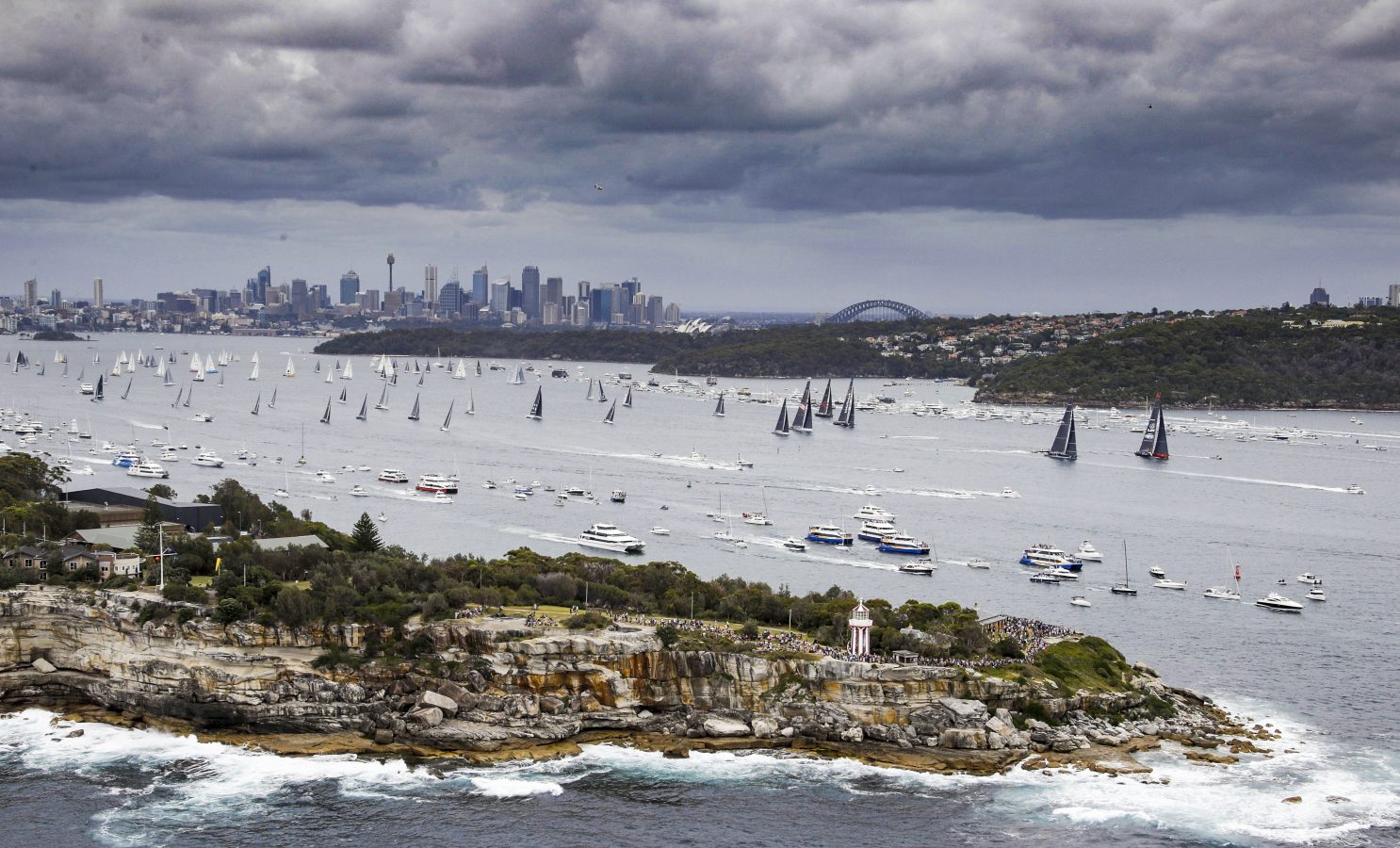
AND THEY'RE OFF
AND THEY’RE OFF!
A 102 boat fleet sets off in the 2017 Rolex Sydney Hobart Yacht Race
The forecast at the start of the 73rd Rolex Sydney Hobart Yacht Race was cloudy with a chance of rain and potential to break race records. This Boxing Day tradition in Sydney drew a spectator crowd on land and lining the shore to see the 102 boat fleet off on their 628-mile slug to Hobart. While the big boats get the media coverage, the RSHYR draws a range of yachts sizes, yacht ages, and crew experience. There is something for everyone, and while the goal is to be first to finish, you first have to finish; not always easy in this famous race.
We at North Sails wish all competitors good luck a safe journey. We’ll be on race and record watch in the meantime…
Enjoy this selection of our favorite images from the start line in Sydney Harbour.
The 102 boat fleets charges up Sydney Harbour before heading offshore. Our North Sails team in Australia says every sailor should have this race on their bucket list. We say the everyday sailing fan should have spectating in Sydney on their list! ©Rolex/Studio Borlenghi
Peter Hamburg’s Black Jack and Jim Cooney’s LDV Comanche were locked together at the start. The Maxis are expected to take two-three days to finish, while the smaller boats in the fleet can take four, five, or six days. ©Rolex/Studio Borlenghi
The RSHYR has three start lines. Wind and water are quite disturbed after the Maxis and the spectators following them. It makes for choppy conditions for the rest of the fleet. Seasick remedies anyone? ©Andrea Francolini
Wild Oats XI was struck by lightning last Sunday, damaging many of her electronics. It was a full team effort to get her race ready. ©Andrea Francolini
628 miles. We hear the welcome in Hobart is unreal. ©Rolex
READ MORE
READ MORE
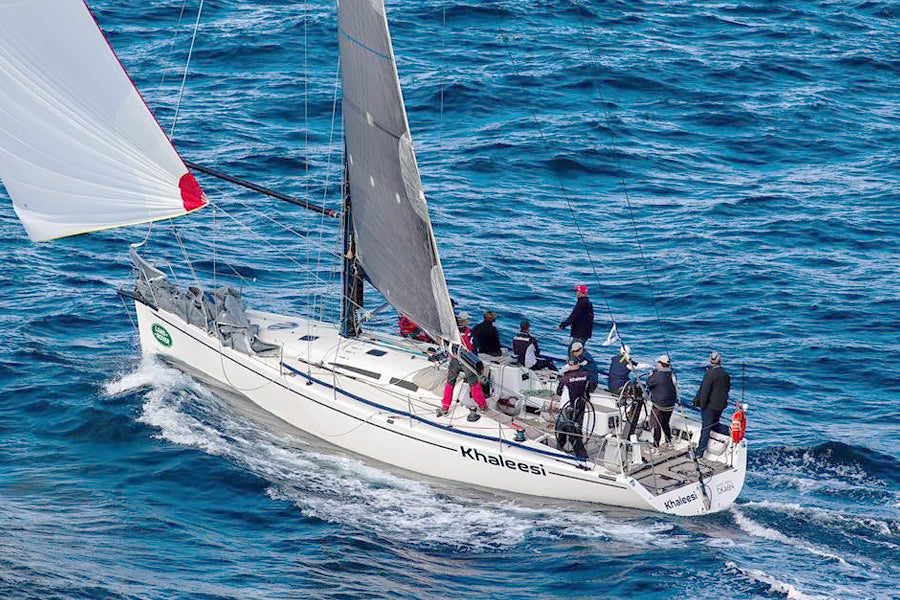
KHALEESI: READY FOR RACING
KHALEESI: READY FOR RACING
Equipped with 3Di ENDURANCE, Khaleesi is ready to take on the 628 nm race
© Andrew Dally
Andrew and Pauline Dally’s Khaleesi had a busy 2016, posting three second places before sadly breaking their mast during the Brisbane to Keppel Island Race. Since then, the team has notched up only one victory (the Bird Island Race, an 85 mile race in early December). Now, “with the expert setup by North Sails and Sydney Rigging,” Andrew explains, “we feel the boat is faster and with a bit of luck we might visit the podium again.”
Khaleesi’s next podium opportunity is the Rolex Sydney Hobart Yacht Race (RSHYR). We caught up with her experienced skipper just days ahead of the start.
Why did you go with 3Di ENDURANCE for your new mainsail?
Our headsails are 3Di ENDURANCE and we have had them since 2014. Despite a recut on a couple of them they are still in good racing condition. Whilst it is heavier than 3Di RAW it allows us to be fast, but more importantly it has the longevity we need for our budget.
What's the biggest difference you've noticed between that sail and your previous main?
Durability. It’s fast and still able to deal with the rigors of hard offshore racing.
Congratulations on winning the Bird Island Race – part of your preparation for Hobart. What’s Khaleesi’s secret?
We attribute our success to a strong loyal crew that stayed with us while the mast was out of the boat, as well as to great preparation and fast sails.
Who’s your closest competition for Hobart?
St Jude . There is also another DK 46 is the race, Extasea, which we have beaten in previous matchups.
© Andrew Dally
READ MORE
READ MORE
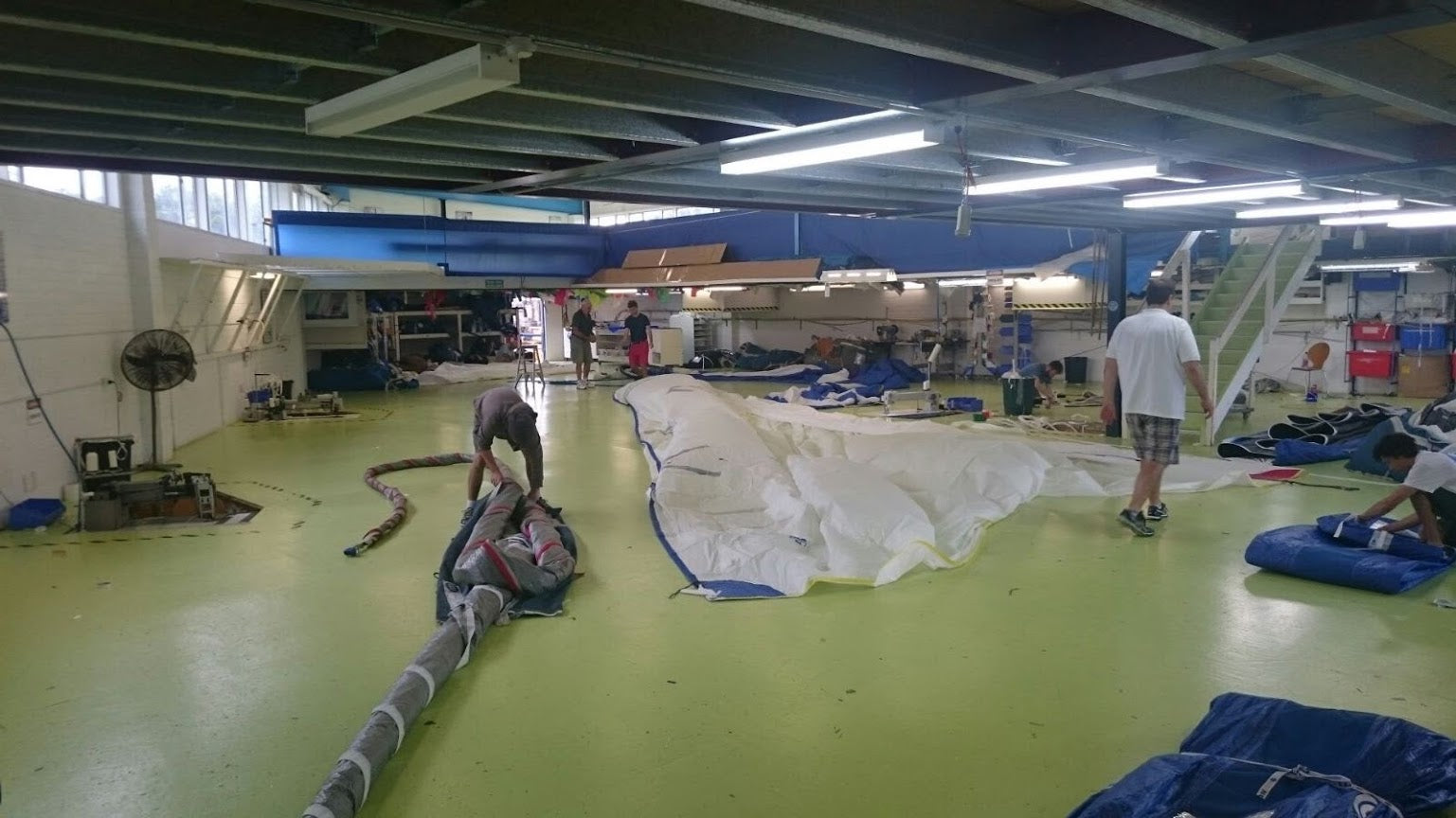
PRE-RACE PREPARATIONS : SYDNEY TO HOBART
PRE-RACE PREPARATIONS WITH NORTH SAILS AUSTRALIA
Our Australia team is busy with sail modifications and inspections to prepare clients for the 73rd Sydney to Hobart
The Sydney - Hobart is a bit different to preparing for any other event, just due to the type of weather that boats will see in the race. So a big part of it for us, whether it be on the smaller 30' yacht or all the way up to Wild Oats, Black Jack or one of the 100' footers, we are always just trying to get out with our clients and assess their heavy weather sail options. Making sure their mainsail reefing system works well and that the sails are not going to let them down in any way is very important for their success during Sydney-Hobart. The reason we do this is that the boat can sail all year out of Sydney, up and down the East Coast and never have to reef but guaranteed in the Sydney - Hobart race it is mandatory to have a reef, and to make sure it works and the crew knows how to use it. If not the first afternoon, then sometime during the first night this opportunity will arise, so our job in the lead up is to focus on making sure the boats are well prepared for the things that they wouldn't normally think to do.
Our loft in Sydney is running 15 hour days getting all the boats and equipment ready. People have last minute service jobs on their sails that need sorting before they depart the dock. Wild Oats tore her spinnaker this week in the SOLAS big boat race so that is on its way in to be fixed up. Once the boats arrive in Hobart we have a loft called 42 South Marine, which will be ready to assist teams. They stay busy doing a lot of service work and repairs as the boats arrive into Hobart in order to get them turned around and back on their way. In slight contrast to us, our service teams in Hobart are down there from December 29th through January 5th to assist all incoming and outgoing race teams.
Contact our local team today to make sure your sails are in tip-top condition to take on Sydney-Hobart.
READ MORE
READ MORE
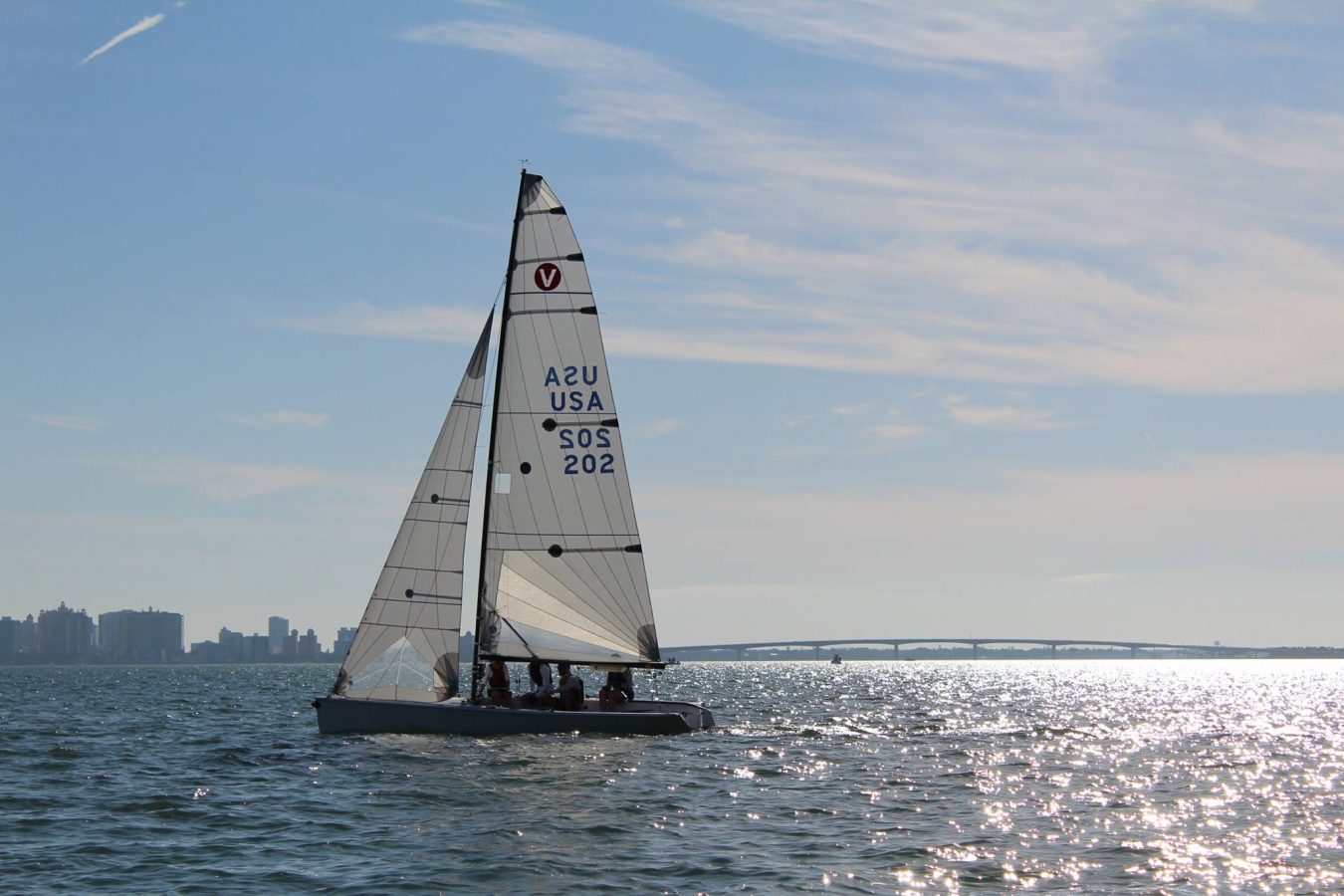
VIPER 640 LIGHT AIR TIPS
LIGHT AIR TIPS FROM THE 2018 WINTER SERIES OPENER
North-powered clients, Jay Rhame and Peter Beardsley, dominate Viper 640 fleet in Sarasota
Light winds challenged twenty-one teams for the first event for the Viper 640 Sarasota Winter Series. Saturday’s racing was cancelled due to the lack of wind, but four races were achieved in 2-7 knots on Sunday. Jay Rhame with crew Rachel and Peter Beardsley from Larchmont Yacht Club on Great Scott! dominated the event, winning all four races.
North Sails Viper expert, Zeke Horowitz, caught up with Peter and Rachel Beardsley after racing to hear about their day on the water and what they did to win all four races.
Peter, what was the key to your setup and why you were going so fast in the light air, both upwind and downwind?
It was really light. We were at 22 on the uppers. I was sitting in the boat a lot more towards the middle. I was playing the fine tune on the jib a lot. We were able to windward sheet the jib as long as we had at least five knots, which was something that Zeke told us to do a long time ago that we didn’t have much success with it until today. It allowed us to lift off people. I felt like a puppeteer for a while there when I was playing the windward sheet, leeward sheet, and fine tuning simultaneously. We were able to really open our gage on people at the right time. We tried not to do too many maneuvers because it was so light, and every time you made a big move, it affected your boat speed drastically. We tried to only tack once or twice a beat to keep our speed up.
Rachel, you were in the front of the boat. Tell us what you were looking for on the upwinds and the downwinds so you could avoid maneuvers but still get the overall strategy good enough so you can focus on speed?
“Our goal was to minimize the numbers of maneuvers, so we talked about the wind and where we thought the pressure was, making sure that whatever the strategy that we stayed on our goal to minimize number of tacks and jibe.”
I look at almost nothing else other than the kite when sailing downwind, but if we feel a little bit light the first thing we do, Jay and I, is to sit on the floor of the boat. Rachel, as our forward crew and tactician downwind, stands up on the foredeck with the best view. If we want to head up,we will all lean into leeward and try to use very little rudder. One of the weird things about today is that we usually have a mode where we lean to weather if we are going to fall off, and today we were never able to do that. It felt like it got half a knot lighter each race and we were almost never able to rock to weather to get it down. We were just trying to heat it up, heat it up and we kept our momentum on which was key.
Give us the 3 biggest tips for light air Viper sailing for someone new to the boat:
Don’t pinch upwind if you are under 6 knots. The boat likes to sail low and fast, we tack into 100 degrees in these conditions.
Downwind: Allow at least 3-5 degrees of leeward heel. Place yourselves on centerline so the boat is more sensitive to the puffs.
Pressure is key. Stay in the pressure and be cognisant of where the next puff is.
You guys were the fastest boat on the water. Anything you might change for next time?
The class changed the rule to allow a more vertical rudder bracket and we are going to install that before the January event and see how that goes. We are also going to move positions around the boat a little bit. Jay and I usually alternate driving in local events and we will do that in January and February. Rachel can do a lot more kite trimming with me up forward looking downwind. If all of us can do every job really well we know we are going to be faster as a team.
Congratulations Peter, Jay and Rachel!
Learn more about our products or contact your local expert
2018 Sarasota Winter Series – Event 1
1
Great Scott! / Jay Rhame / Peter Beardsley
3
Moxie / Zeke Horowitz
4
Merica / Paul Kleinschrodt
5
Coming In Hot / Michelle Lee
6
USA 264 / Jonathan Nye
7
Caterpillar / Peter Ill
8
USA 105 / William Stocke
9*
Entourage / Nick Amendola
* Denotes Partial North Sails Inventory
Full results
First Place
Third place
More photos
READ MORE
READ MORE
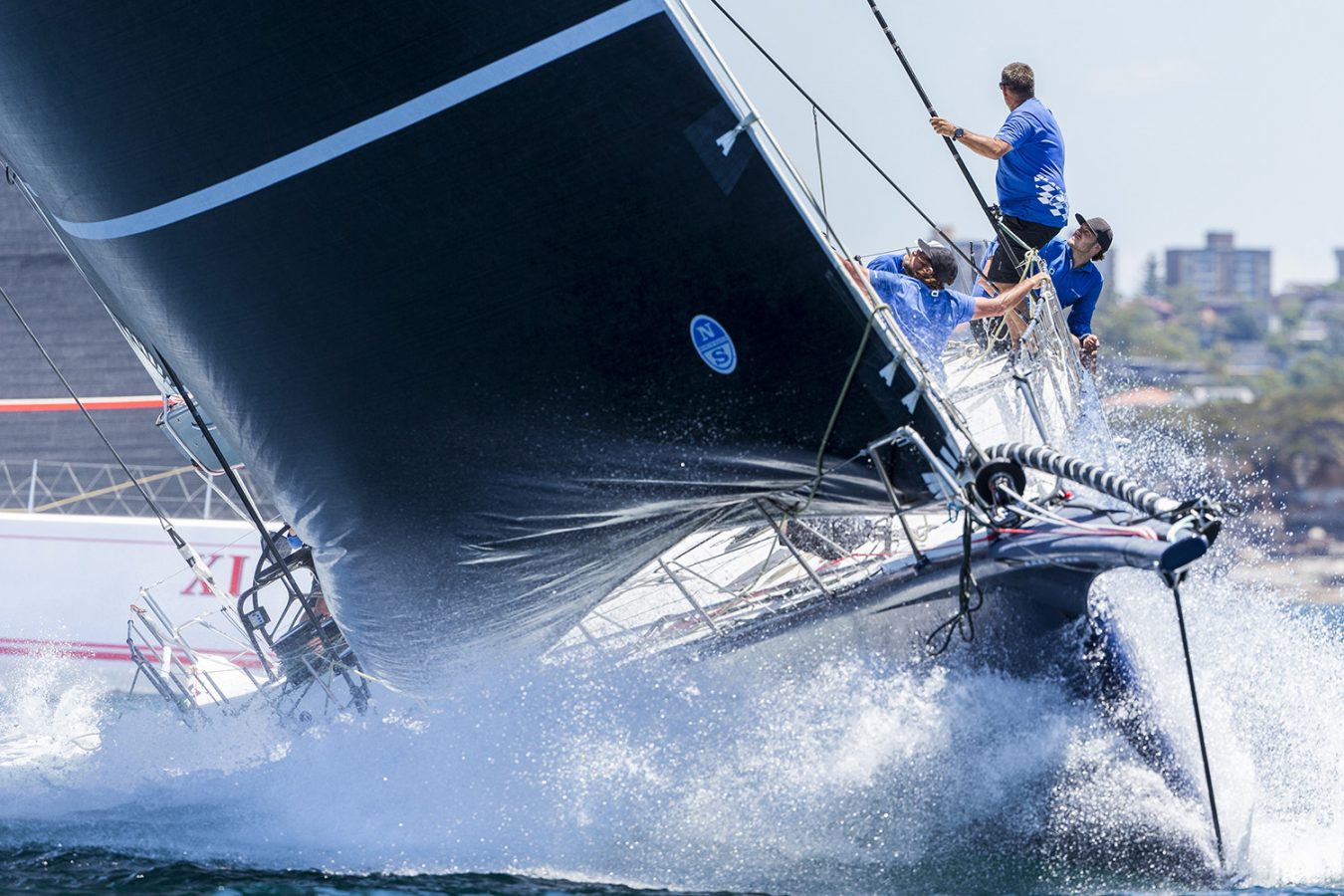
ROLEX SYDNEY TO HOBART YACHT RACE PREVIEW
ROLEX SYDNEY - HOBART RACE PREVIEW
Alby Pratt, Sales Manager of North Sails Australia, previews this offshore classic
© Andrea Francolini
The SOLAS Big Boat Challenge on Sydney Harbour is always a spectacular preview to the Rolex Sydney - Hobart Yacht Race (RSHYR) . Are you surprised that Black Jack took the win over Wild Oats?
It looks like Black Jack is a stronger boat upwind in lighter air and Wild Oats is stronger upwind in heavier air, probably due to the modifications that Wild Oats has done. The same applies downwind. Once upon a time, Wild Oats was a very strong light-air boat but she seems to have given some of that away. Mark Bradford and Vaughan Prentice from North Sails Brisbane both sail on Black Jack so they were obviously really happy to have won, but the SOLAS results shows a slight shift in focus for Wild Oats to optimize for the full range of conditions that they will see in the Sydney - Hobart.
The RSHYR is one of the pinnacle offshore races in the world and one of the biggest sports events in Australia - what do you think makes this event so special and why should it be on every offshore sailor’s bucket list?
There is a lot of history behind the race. This is the 73rd year; long enough to become a stalwart of offshore races. It is always a tough race-you know that you will get a range of conditions while you are out there. You are also pretty much guaranteed to be going upwind in heavy air at some point during the race; 30 knots plus for a period of time. And the smaller boats will likely see two weather transitions during the race so they will have to deal with two frontal systems, which makes it that much harder. When you do complete it, to have come through all that and arrive in Hobart the feeling of achievement is so much sweeter!
The Aussies are famously welcoming - what is the race atmosphere like on the ground in the build up, out at sea, and at the finish?
The race is a buzz around the Cruising Yacht Club of Australia (CYCA) with everyone getting ready and final preparations going on, but it is Christmas in a major city and the activity is more localized at the Sydney waterfront. That said because it is Christmas there is an awesome feeling of anticipation and fun; it is one of the things that makes it such a special event. There are quite a few boats from overseas competing this year, so there is a nice international feel to the whole event. When the race gets to Hobart it is crazy, as it takes over the whole city. There is no one who doesn't know about it. Everyone has a boat they are rooting for, a friend competing, stories from their own experiences or they just get caught up in the arrivals and the achievements of each of the boats as they make it across the Tasman Sea. It’s a really cool arrival city and one that every sailor should have on their bucket list.
Any favorite memories of the race, as a spectator growing up or about racing yourself?
I always remember 1998 because it was such a hard race. Unfortunately six guys lost their lives and I remember how tough it was. We did get second overall, but I remember it more for the brutal nature of the weather that was thrown at us. In 2005 I sailed on Wild Oats and we won line honors. We also won on handicap and broke the record. We had only launched the boat three weeks before the start of the race and we were racing against Alfa Romeo who were race favorites. So for us to beat them and take the record was pretty exciting.
© Rolex / Daniel Forster
You will be racing onboard Infotrack, (which as Perpetual Loyal broke the race record in 2016). What are your expectations? Any insights yet on conditions and how this will impact strategy and sail choice?
Infotrack likes reaching, but it will be tough to beat LDV Comanche in those conditions as that is her sweet spot. If we get light air or any sort of transition where the boats are becalmed for a while, I think Black Jack will really come into her own. For all-round performance it is always hard to get past Wild Oats. It will be a really hard fight at the fastest end of the fleet.
We start monitoring the weather pretty much from 10 days out and look at how that is going to play into our sail inventory. We are always looking to take sails off to lighten the boat, but you get such a broad mix of conditions in this race that you end up using every sail you have. All teams monitor in the final prep day and start fine tuning their inventory.
The big boats take a lot of the headlines, but there will also be a battle for handicap winners, especially the Corinthian Class. Any boats you think we should be keeping an eye on? How does their preparation differ from the bigger boats?
The boats to keep an eye on for handicap are:
Matt Allen’s Ichi Ban, a brand new IRC 52
Khaleesi, DK46, Andrew Dally. Won the 90 mile warm up race in the SOLAS last weekend.
St Jude, Noel Cornish’s boat
The ‘little’ Wild Oats skippered by Troy Tindall cold also be a handicap champ
Concubine, Jason and Shevaun Ward’s Mills 45, which given the right conditions will be right up there.
Preparation isn’t dependent on size - we have the same priority to get all North Sails customers fully race ready and all their reefing, sail systems and sails working at 100% before they leave the dock.
We have very experienced North Sails representatives going across the Tasman on LDV Comanche, Ichi Ban, Wild Oats, Black Jack, InfoTrack, and Concubine. The ‘little’ Wild Oats (66 footer) is also going with a new North Sails inventory, so we have. Sailing onboard gives us first-hand feedback on anything we can be doing better for future.
@ Andrea Francolini
READ MORE
READ MORE
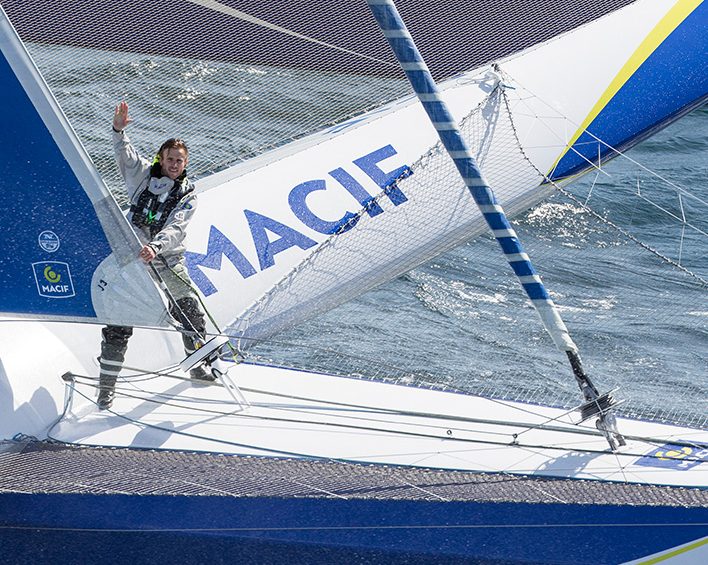
HOME FOR THE HOLIDAYS...RECORD IN HAND
HOME FOR THE HOLIDAYS…RECORD IN HAND
42 days. 16 hours. 40 minutes. 35 seconds. 3Di sails.
© Vincent Curutchet
François Gabart now owns a mind-blowing solo record pace. Gabart has broken the Around the World, Singlehanded record a few days shy of one year from Thomas Coville’s 2016 record of 49 days last December. Gabart’s accomplishment is most impressive, considering that Coville smashed eight days off a record previously set in 2008 by Francis Joyon, and this latest attempt falls only two days off the fully crewed around-the-world record.
Gabart’s full inventory of North 3Di sails powered Macif around the world at an average of 27 knots. The mainsail on Macif had 47,000 miles on it before the start of this record attempt. This latest record is further proof that 3Di technology produces sails are the highest performance and most durable.
2017 saw many records broken, smashed and shattered. Congratulations to François Gabart and the entire Macif support crew, who we’re sure are already planning their next adventure.
© Jean Marie Liot
READ MORE
READ MORE
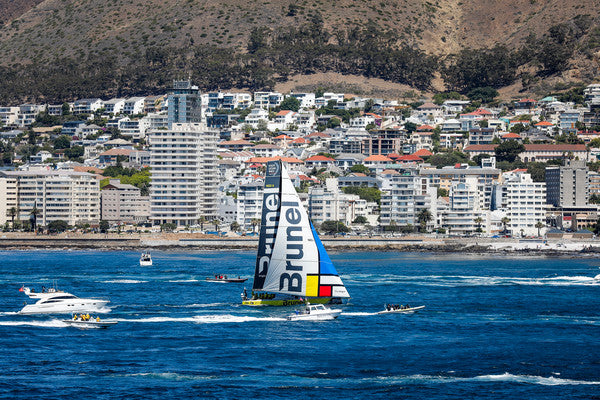
TEAM BRUNEL ONTHULT MONDRIAAN ZEIL
Team Brunel onthult Mondriaan zeil
Het Nederlandse team Brunel onthulde tijdens de stopover in Kaapstad het nieuwe graphic design van de master code zero, het Mondriaan zeil. Op weg naar Den Haag vaart het team met het zeil geïnspireerd op de iconische werken van Piet Mondriaan.
Bouwe Bekking:
“Mondriaan was zijn tijd ver vooruit. Prachtig in zijn eenvoud en toch was zijn werk echt avontuurlijk. Hij durfde te vernieuwen, uit te dagen en anders te denken. Dat zijn eigenschappen die iedere zeezeiler echt aanspreken. Dat we op weg naar de ultieme bestemming met dit Mondriaan zeil varen en Den Haag op deze manier kunnen uitdragen is mooi.”
Photo by Ugo Fonolla/Volvo Ocean Race. 11 December, 2017.
Volvo Ocean Race Finish in Den Haag
Op 24 juni 2018 finishen de zeven deelnemende teams in de Volvo Ocean Race voor het eerst in de historie in Den Haag. De stad is dan met recht de ultieme bestemming. Team Brunel is een van de deelnemers in deze legendarische race. Dit Nederlandse team zeilt vanaf Kaapstad richting de finish met een echt Haags voorzeil geïnspireerd op de iconische werken van Piet Mondriaan.
READ MORE
READ MORE
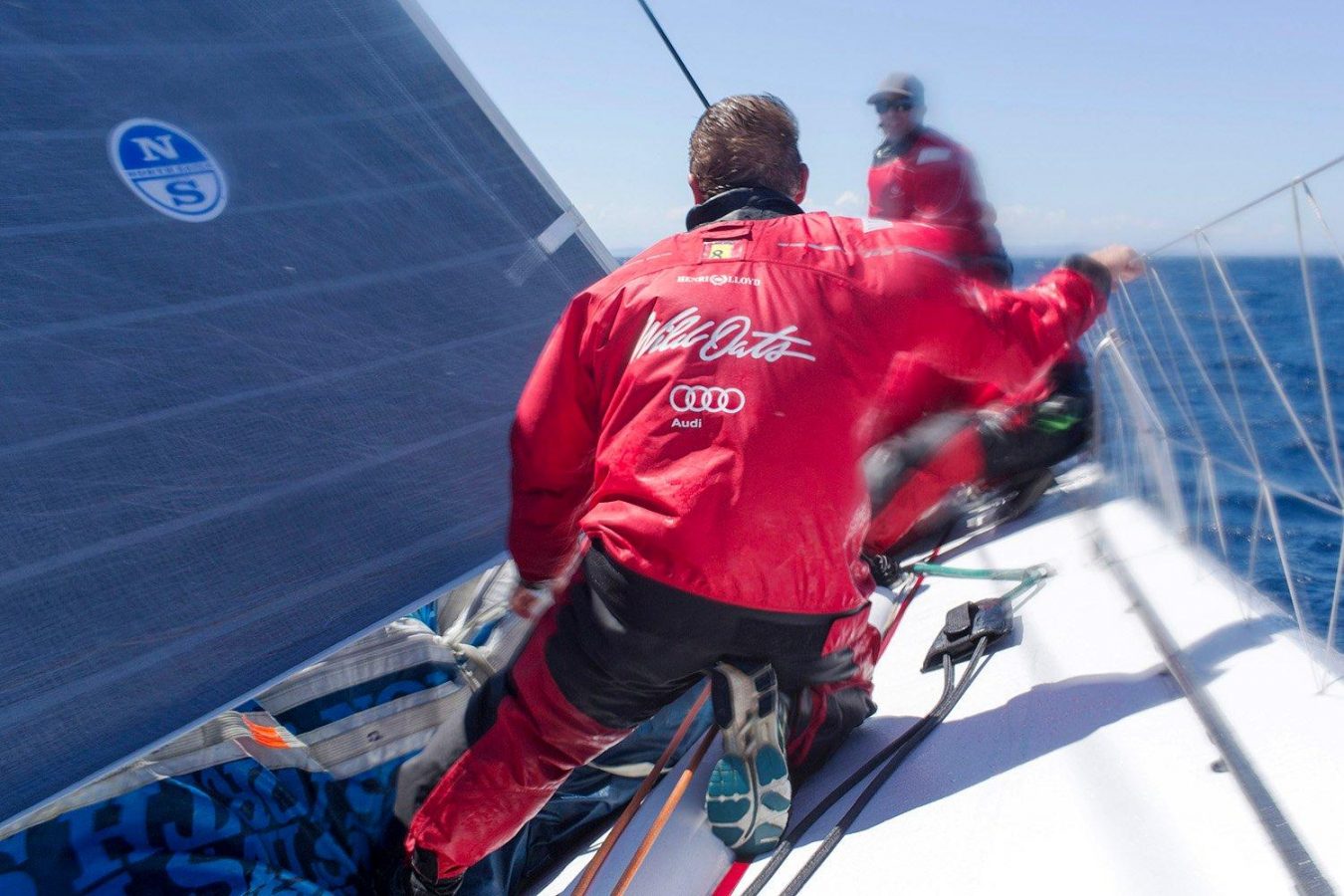
A BEGINNER'S GUIDE TO NAVIGATING SYDNEY-HOBART
A BEGINNER'S GUIDE TO NAVIGATING SYDNEY-HOBART
© Andrea Francolini
The Rolex Sydney-Hobart Race is one of the classic yachting events on the annual race calendar, arguably the most famous and difficult race taking place in the Southern Hemisphere. Its reputation is well deserved, giving all who enter it numerous challenges – not only in the level of competition the race draws, but also with many hurdles brought by Mother Nature. These environmental challenges take the form of fast changing and often strong winds, squalls, complex ocean currents, and potential for extremely rough, boat-breaking sea conditions. All that on top of what is often a more than 20 degree Celsius drop in air temperature from balmy Sydney to cool Hobart.
Navigators of the race watch typical wind patterns of the Australian summer: a semi-permanent high pressure to the east over the Tasman Sea, and another over the Great Australian Bight west of Tasmania. Air flows anti-clockwise around these high pressure systems, which means there is a tendency for northerly winds off the Sydney coast and southerly winds west of Tasmania.
Between these two high pressure areas there is normally an extension of the thermal low pressure from the hot interior of Australia, extending into NSW and pointing toward the Bass Strait.
The patterns described above represents the average – that is, what you get if you average the weather maps over a long period of time in the Australian warm season. However, the actual weather on any given day is the result of modulations on the average pattern and disturbances (weather systems) embedded within the larger scale.
SOUTHERN OCEAN CHILL
One such important and common disturbance involves the northward intrusion of cold air out of the Southern Ocean. When cold air pushes north toward Tasmania, the Bass Strait, and southeastern Australia, some very abrupt and severe changes can result. Ahead of the cold fronts which mark the leading edge of a cold push, winds typically build from the north along the coast. Sometimes thunderstorms can develop over the hot interior of NSW and move east into the course from Sydney and south to Green Cape. Such storms have generated spectacular waterspouts on the course – an encounter with which is not only memorable, but potentially very dangerous.
"Being ready to weather strong upwind sailing and very rough seas in the wake of a S’ly change are a must for any crew and boat taking on this race."
As a cold front moves north and east across the race route, fast running conditions down the coast abruptly change to hard, very rough, upwind conditions. Not to mention the fact that squalls and much cooler air make sailing more difficult. These post-change encounters are a make or break point for some teams. Being ready to weather strong upwind sailing and very rough seas in the wake of a S’ly change are a must for any crew and boat taking on this race.
TRICKS OFF TASMANIA
Further down the track from crossing the Bass Strait to east of Tasmania, winds are no less challenging. Large ocean swells are common crossing the strait, and Gale or Storm force winds can occur - especially in the day or two following a front. Off Tasmania, winds can run the gambit from strong to exceedingly light. One certainty of sailing off Tasmania is that the wind will change. The weather patterns there are fast moving and can behave erratically. An area of no wind can exist within hundreds of meters of gale force gusts. Understanding how conditions will change and making a correct call at the last moment can make the difference in almost any team’s race.
SURF OR SWIM
Another important factor in the strategies for this race is often the East Australian Current (EAC). The EAC is a western boundary current similar to those found on the east coasts of most continental land masses around the world (Gulf Stream off North America; Brazilian Current off South America; Agulhas Current off South Africa, and; the Kuroshio off Asia). The EAC is a generally south-flowing current off the coast, typically extending from north of Sydney to the Bass Strait and off the east coast of Tasmania. While the current is always present in one form or another, its speed and position relative to the course can vary significantly. In addition, tight swirls or eddy's are typically present in proximity to the main current flow, and can result in areas of rotating water over ten miles wide, often delivering the opposite of what a skipper may expect.
While the current doesn’t change much on a day-to-day basis – unlike the weather – it does vary over a period of weeks. Sometimes it is close to the coast and within reach of the fleet to take advantage of its southward flow. Other times, it is further offshore, and sailing out to it can be a gamble whether or not the favorable flow will be enough to offset the extra distance necessary to get to it.
There is also a potential significant downside to being in the current – even if it is within reach. When winds are blowing from the south, very large and steep waves can develop within the EAC which can, at a minimum, slow progress or, in the worst case, be boat-breaking. Anytime there is a southerly change and strong upwind conditions in this race, sea state within the EAC is a significant factor.
The crews will be closely monitoring the weather forecasts and EAC condition in the days leading up to the race. While the forecasts can be reliable, it is often the small differences that are more difficult to predict. That will combine with the level of seamanship on-board to determine how well a team does.
"Having a fast boat and sails are of course a bonus, but being ready and able to handle whatever the weather and sea brings will make the difference."
Chris Bedford is a well known sailing meteorologist and has advised many professional teams on inshore and offshore race routing, including the Abu Dhabi Ocean Racing 2014-2015 Volvo Ocean Race team. Read more from Chris at sailwx.com
Contact your local North Sails experts to get your sails inspected and ready to take on the big race!
READ MORE
READ MORE
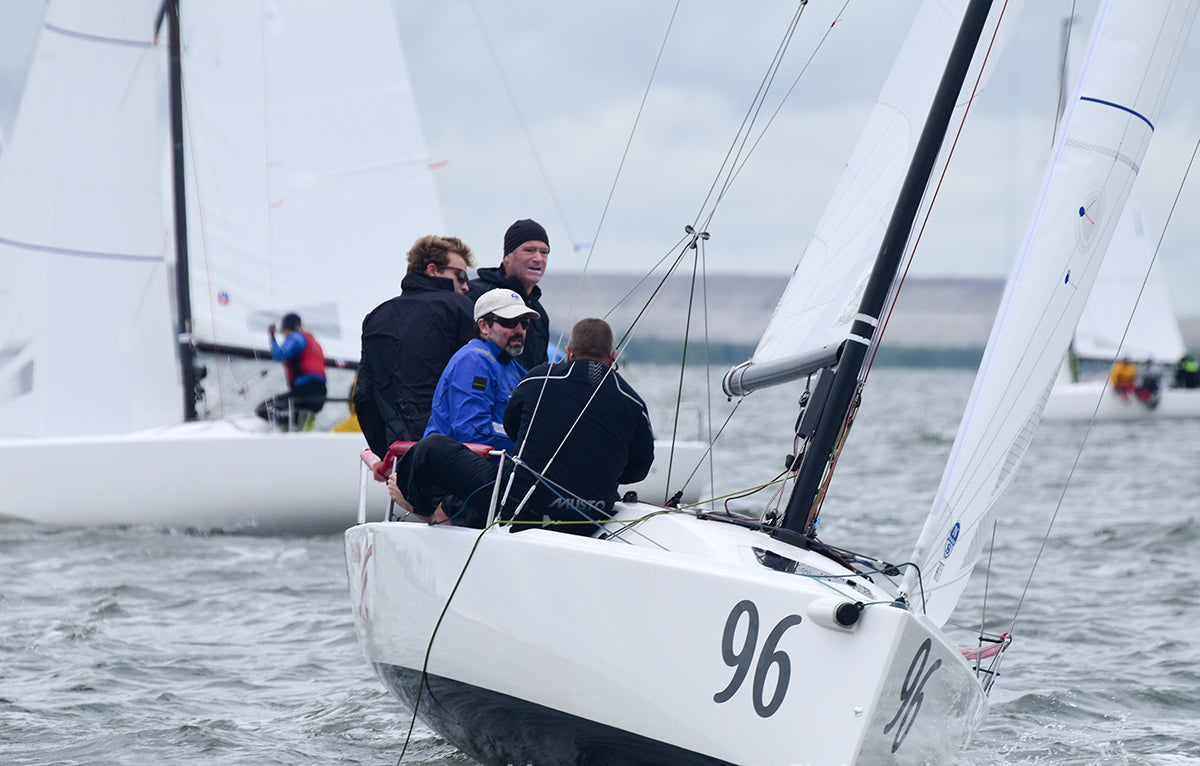
J/70 US WINTER SERIES OPENER: BIG BREEZE TIPS
J/70 US WINTER SERIES OPENER
Key Tuning and Trimming Points from Savasana’s Trimmer Tim Healy
Event one of the J/70 Winter Series at Davis Island was a great success for North Sails clients. With an approaching frontal system, teams were psyched to sail in big breeze that was forecasted. Seven races were completed in the highly competitive 53-boat fleet. It was tight racing throughout of the fleet but Brian Keane’s Savasana deemed to be the fastest of them all, taking first place with a 22-point lead from the rest of the pack. Two bullets and only one race out of the top five was an impressive way to end the regatta.
We caught up with Savasana’s trimmer, Tim Healy, to see what he had to say about tuning and trimming points that helped them win the regatta. Tim provided the team’s top three tips that kept their boat sailing fast.
Congratulations to our clients on starting the series off with a bang, sailing very well with outstanding results in some unpredictable frontal conditions. The North XCS-1 main, J-6 jib and AP-1 spinnaker were the most popular sails in the top 10. Boats powered by North finished 1,3,5,6,7,8*,9,10 and won 6 out the 7 races.
Tim’s Top Tips for sailing in big breeze:
Get the rig tune tight enough.
We ended up at 28 on the uppers and 30 on the lowers. This allowed us to use a lot of backstay before we would get inversion wrinkles in the main. A lot of backstay tension, with a tight rig, translates into a tight headstay. A tight headstay keeps the jib from getting too deep which can overpower easily and drag the bow down in the puffs making the boat hard to control.
If the rig is not tight enough, the mast will bend too easily when the backstay is applied resulting in inversion wrinkles in the main too early and the headstay never getting tight enough.
Move jib leads back 1-2 holes and play/ease weather sheet in puffs.
Moving the leads aft make the bottom of the jib flatter and the top twist off easier. When the top of the jib can twist in the big puffs, it dumps some of the excess power and allows the boat to be sailed flatter. The weather sheet should also be eased in the big puffs to open the slot, flattening the bottom of the jib more and adding more twist to the upper leech. In these big puffs it proved to be very fast, as the skipper would feather slightly in the sharp increase of pressure. If the jib had too much weather sheet or if the lead was too far forward, the boat would heel over too much. The main would need to be eased/luffed and the bow would be dragged down because the balance of the boat is thrown off. When the puff is over, the weather sheet can be pulled back on adding upper leech tension as well as depth to the bottom of the sail. Playing the weather sheet can all be done from the crew hiking on the weather rail without much movement. A steady crew that is sitting still and hiking is important for the mainsheet trimmer and helmsman to get in sync to balance out the helm and trim.
Downwind – Leave backstay on if in overpowering windy conditions.
This will not only keep the main flatter, but it will pull the luff of the spinnaker tighter as well. A tighter luff will flatten the overall shape of the spinnaker by moving the draft forward, making the leech of the spinnaker twist. Easing the traveler down all the way will make pumping more effective, and give the main trimmer more control of the main leech. When the traveler is all the way to leeward and the trimmer pumps the main, the boom not only comes in to weather but it also is being trimmed more effectively down. This acts like pulling the mainsheet and vang on at the same time. When the big puff hits, a quick ease of the main will open up the leech allowing the boat to stay under control and ripping with very little vang tension.
Need to step up your game? Contact your local North Sails expert today for the latest products to get you up to speed for the winter sailing circuit.
J/70 2017-18 US Winter Series – Event 1
1
Savasana / Brian Keane
3
Stampede / Bruno Pasquinelli
5
NINE / Oivind Lorentzen
6
Tea Dance Snake / Todd Jenner
7
Scamp / Will Welles
8*
Flojito 3 JT / Jack Franco
9
Rimmette / John Brim
10
Polar / Doug Clark
* Denotes Partial North Sails Inventory
Full Results
READ MORE
READ MORE
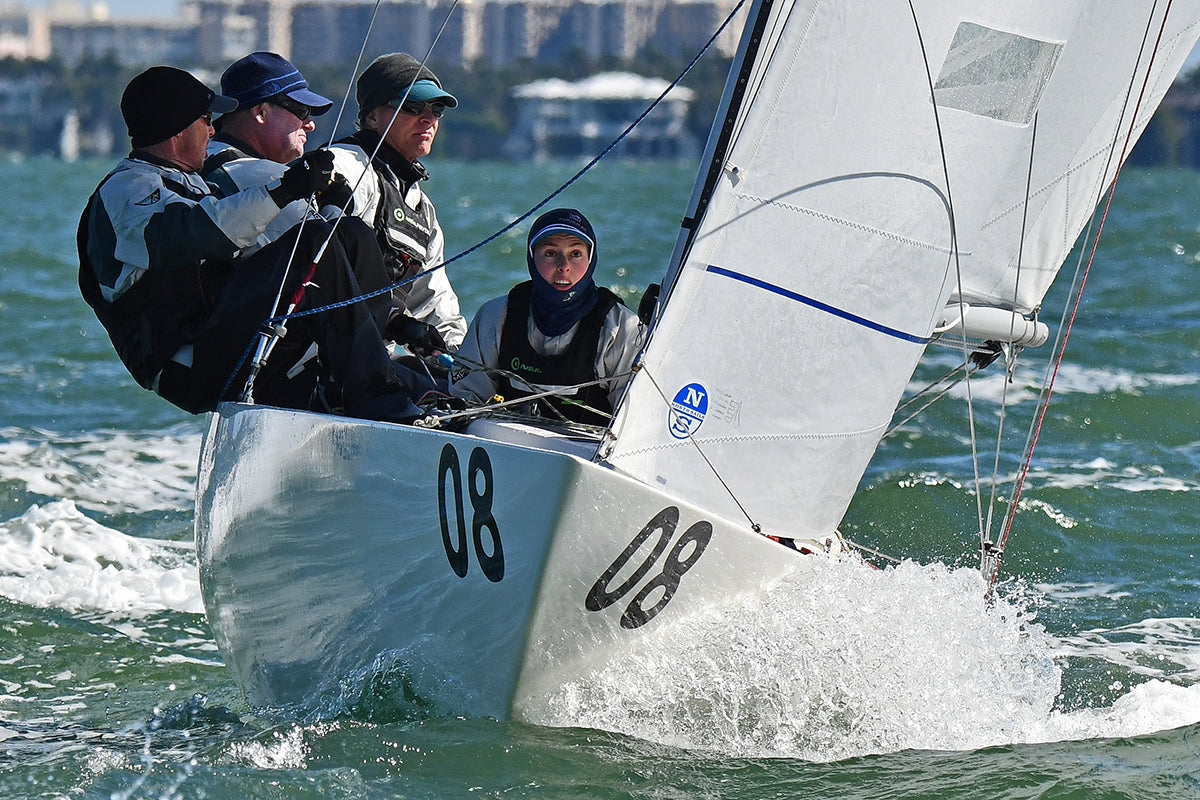
NORTH CLIENTS DOMINATE 2017-18 ETCHELLS BISCAYNE BAY SERIES OPENER
NORTH CLIENTS DOMINATE 2017-18 ETCHELLS BISCAYNE BAY SERIES OPENER
Congratulations Jim Cunningham and team Lifted! North Sails 9 of top 10!
The Louis Piana Cup, first stop of the 2017-18 Biscayne Bay Etchells Series, started out with a bang for Jim Cunningham and his team of Jeff Madrigali, Mark Ivey and Serena Vilage who took the regatta by one point over visiting Brit Lawrie Smith and his 3 amigo team of Richard Parslow, Goncalo Ribeiro and Graham Sutherland.
Tight rigs and warm clothes were the call as five races were expertly run by former world Champion Stuart Childerly and his great team from Biscayne Bay Yacht Club. A very strong cold front delayed racing on Saturday by a couple of hours as the race committee wisely held the fleet on shore as dangerous thunderstorms with 50 knot gusts and tornadoes were moving down the state. Two races were completed with Jim and Lawrie atop the standings after the first day.
Sunday brought an early start, unseasonably cool temperatures, and blustery strong winds. Steve Benjamin and his team showed some of his World Champion form to take the first race in 18-22 knot winds while the rest of the day was owned by Jose Fuentes with his crew of Luke Lawrence and Ian Liberty. In a dying and very shifty north westerly breeze they took control and won both of the final two races and pulled themselves into 3rd place overall—very impressive. Equally impressive was the fourth place all Corinthian team of Peter Vessella, Tracy Usher and Mark Callahan.
The North Sails PC-Fm Radial Head mainsail used by the top teams continues delivering impressive performance. Most teams opted for either the GM 6.5 heavy air jib or the LM-2H radial head jib for the strong winds of the weekend. It wasn’t until the final run of the last race that teams choose to put up the VMG spinnaker instead of the Full Runner.
2017-18 Luis Piana Cup
1
Lifted / Jim Cunningham
2
Alfie / Lawrie Smith
3
Caramba / Jose Fuentes
4
Peter Vessella / Mahalaga
5
Lion Heart / Adrian Owles
6
SCIMITAR / Steve Benjamin
8
Blackadder II / Andrew Cumming
9
Freedom / Craig Mense
10
America Jane II / Scott Kaufman
Full results
READ MORE
READ MORE
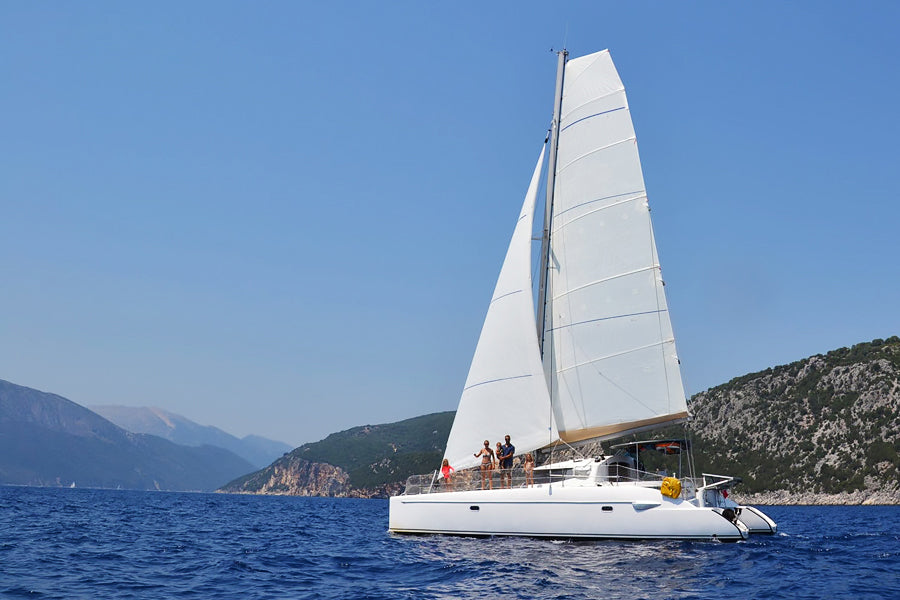
GUSTAVE'S ADVENTURES IN THE MEDITERRANEAN
Gustave’s Adventures in the Mediterranean
The Aubert family indulges on their Mediterranean adventure aboard their Lavezzi “Gustave”, powered by 3Di NORDAC
One couple, three young children, a catamaran, and six months sabbatical to make the most of the Mediterranean. That was the project in 2017 for Jérôme Aubert, 40, and his wife Hélène, 35. The couple have three children: Jeanne, Louise and Arthur, who are seven, five and two respectively. At the same time, Jérôme quickly became interested in a catamaran, for him the ideal platform to travel across the water with young children. Not necessarily an obvious choice for this sailing professional as he has been working at Harken for eight years where he is more accustomed to the rigors of monohull racing.
Jérôme has in fact the perfect CV of a pure sailor: Optimist, Europe, Melges 24, Figaro – he took part in the Figaro Solitaire Race in 2006 and the Tour de France à la Voile. This long summer journey will therefore be a voyage of double discovery: the catamaran and cruising! He settled on a second hand Lavezzi 40 (built by Fountaine-Pajot): the boat was in great shape but the sails not so much. It was for this reason that the relationship with North Sails started. The sailmaker, at the time going through a test phase for its 3Di NORDAC, proposed a special price for a totally new sail plan, a square top mainsail with full battens and a furling solent. The sails were delivered to Saint Nazaire two days before taking the boat down to the Mediterranean. This wasn’t due to a late delivery, but thanks to a good weather window! The expected downwind breeze arrived in the Bay of Biscay, but a little punchy all the same:
“We had 45 knots twice, on the nose” recalls Jérôme. “At times more than 15 knots surfing, an initiation of fire for new sails!”
After 2 stopovers and 10 days sailing, Gustave arrived in Ibiza. It was from here that the family cruise started. On the agenda, the Balearic Islands of course, Sardinia, Sicily, Southern Italy, Montenegro, Albania, the Ionian Islands, the Peloponnese, the Amalfi Coast, Capri and Ischia, and Corsica. Hélène’s summary “167 days, 165 those were sunny, 4,800 miles sailed, seven countries, 15 pairs of sunglasses, 10 bottles of sun lotion, four tuna caught, five wasp stings, two stitches, 25 kilos of bananas.” Jérôme strived to sail in manageable conditions and with the wind from behind. By the end of the journey, Gustave had not used her engine and had practically never tacked. And even though the basis of sailing in the Mediterranean consists of little leaps from mooring to mooring, the Aubert family journey still counted some beautiful crossing, up to 310 miles. It was the perfect opportunity to test the new 3Di NORDAC sailing on a catamaran on an intensive cruise.
“After 6,000 miles of sailing, they haven’t changed shape and handled the UV exposure very well,” noted Jérôme, “The same for the material around the forced slats, which held very well.” And with the sale of Gustave, to return to another cruise, presenting the beautiful North Sails 3Di NORDAC onboard is most definitely a plus.”
READ MORE
READ MORE
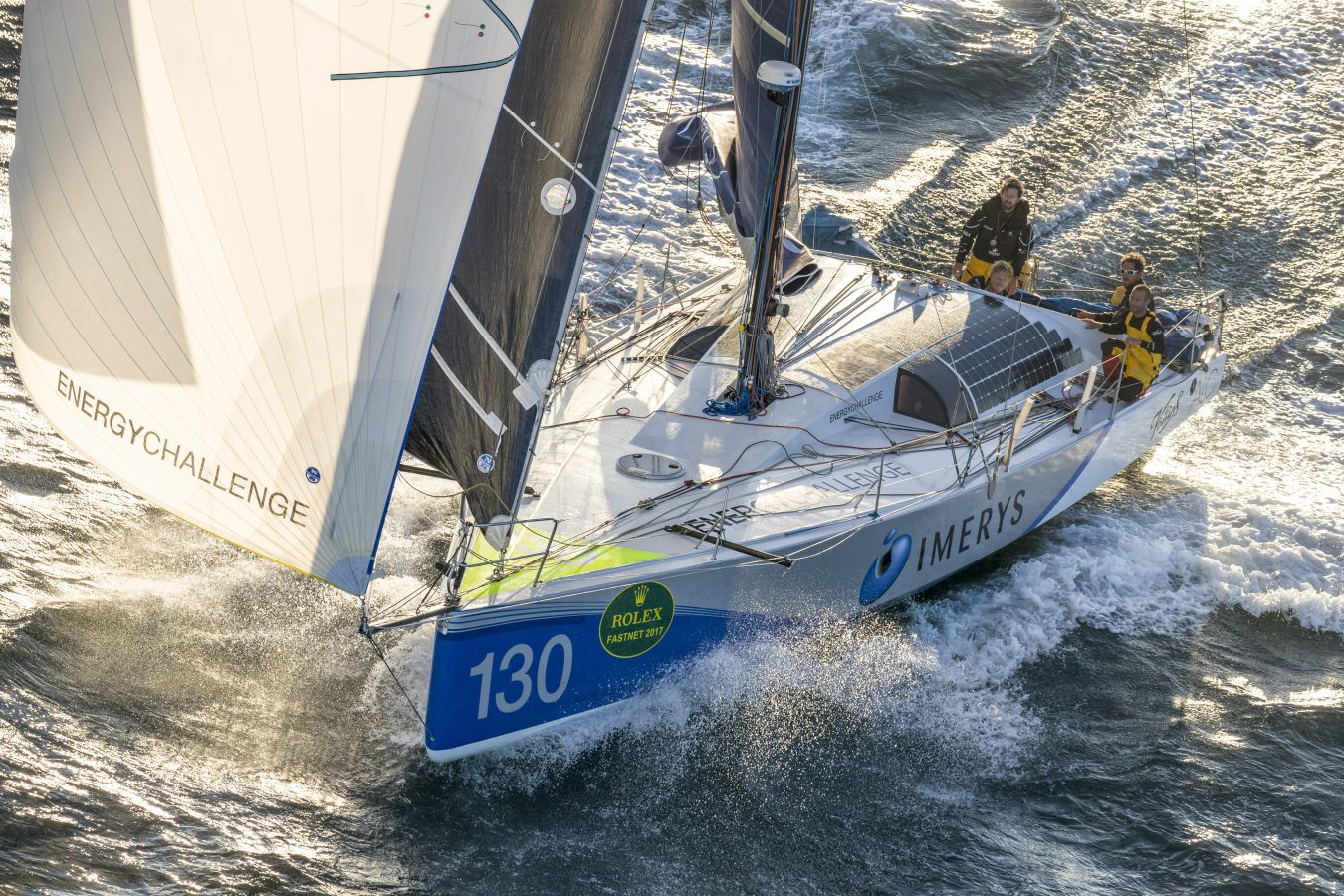
INTERVIEW WITH CLASS 40 CHAMPION PHIL SHARP
INTERVIEW WITH CLASS 40 CHAMPION PHIL SHARP
Imerys Clean Energy skipper Phil Sharp wins Class 40 Championship in the finale Transat Jacques Vabre
© PhilSharpRacing.com
We caught up with the skipper of Imerys Clean Energy, Phil Sharp, on his Class 40 win after completing the Transat Jacques Vabre, the final race of the 2017 Class 40 season. Powered by North Sails 3Di, Phil has been competing in Class 40 division for just two seasons now, and winning this year is quite the feat! Placing 1st overall, with a lead of 247 points after five events: Trophée Guyader, Normandy Channel Race, Les Sables Horta, Rolex Fastnet Race and the Transat Jacques Vabre, Phil looks forward to his next opportunity to shine.
You are relatively new to Class 40. What does this achievement and quick rise to success mean to you?
This is my second full season sailing in Class 40 which is now a very established and competitive offshore Class. I would say that it takes one full season to achieve that all-important reliability, and to really learn how to maximize the boats potential. It has been a lot of work over the last 18 months, so what we have achieved this year is really satisfying for everyone involved and it is really great to reap the rewards.
What do you think enabled you to get the level of consistency you needed to win this series (preparation, hardware (including sails), decisions, weather etc) and with such a huge margin?
If I compare this season against last, I think this year we really had the time to meticulously prepare the boat, particularly towards the end of the season. This meant that it was possible to spend the vast majority of the race focusing on strategy and speed, rather than fixing things, which is absolutely key.
“The sails are fundamental in this equation – in order that you can race with real confidence you have to have sails you can rely on, that are well-tested and that you can push hard with.”
What did North Sails do to support you in making an impact in Class 40?
Where North Sails have been particularly supportive and professional to work with, is in the development process. It is virtually impossible to create the perfect sail out of the box, so they have given us some great support in listening and understanding to what we wanted, what we needed to improve, and optimizing the sails to meet our objectives. This has definitely given us important performance gains throughout the season.
When did you take delivery of your sail inventory? Have you added or replaced any sails for the 2017 season, and your ultimate victory?
We started building up an inventory from July 2016, when we started working with North Sails. This has been a gradual process replacing the sails that came with the boat, according to our budget. We have also worked with North Sails on developing and modifying new sails by tweaking the shape and looking at the effects on the water.
“This was a real eye-opener and a great learning experience for me – to really see what a difference the sails could make to performance.”
How did you feel about your sail inventory, how did it fare over the series and are there any changes you would like to make to it (and why)?
I was actually really pleased with how everything performed in the TJV. In particular, two fractional sails that worked really well were our A6 and A5, which enabled us to push the boat hard during windy conditions. If anything, I would work on developing our reaching setup and perhaps refine the Code 0 for reaching, rather than upwind.
What was your greatest memory of the TJV?
Escaping the doldrums. We had had a pretty awful time to the west with seriously light airs, which pushed us back from 1st to 4th, with the boats to the east of us getting slightly more pressure for two days. The last night was particularly dreadful with lots of wind shifts and we were sure we had lost out. However, when we downloaded the positions the next morning it was a very nice surprise to see that we had pulled back into the lead with a 10 mile advantage, and had managed to break into the southeast trades before the others. We rewarded ourselves with a large portion of porridge that morning!
Other than winning, what was your greatest achievement of the series?
“Leading 12 of the 17 days of the TJV was a nice statistic to finish with. As well as being able to report zero sail damage at the end of an Atlantic race! Although that is largely North Sails achievement as well as ours!”
So Phil, what’s up next for you?
After a great season in Class 40 we feel it is a good time to move up to IMOCA 60 so we are working on attracting further support for a highly competitive entry towards the 2019 Barcelona World Race and the Vendee Globe 2020.
© Carlo Borlenghi
© Jean-Marie Liot / ALeA / TJV2017
READ MORE
READ MORE
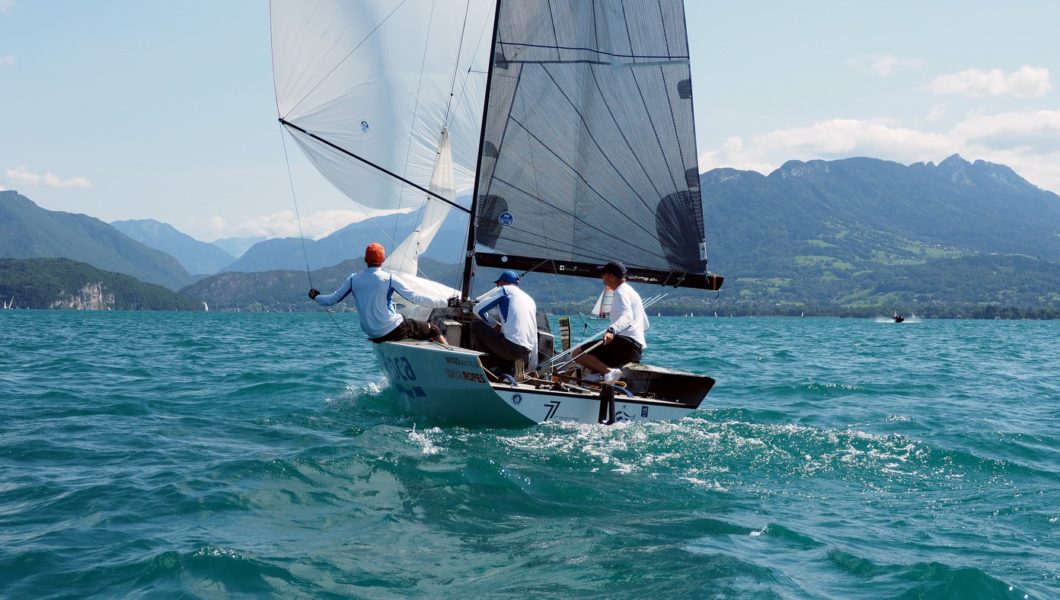
TARNACKI DOMINATES MICRO CLASS WITH ALL NEW NORTH INVENTORY
TARNACKI DOMINATES MICRO CLASS WITH ALL NEW NORTH INVENTORY
With the support of 6-time World Champion Piotr Tarnacki, North Sails came into Micro class in 2017 with an all new prototype sail inventory which included:
– MK-1 Mainsail
– JK-1 and JK-1 Light Jibs
– SS-1 Spinnaker
Tarnacki with his team, 77 Racing dominated season with a stunning 23 out of 26 race wins in Polish Cup regattas, which included the Polish Nationals. The Polish fleet is the toughest Micro fleet in the world. The main test took place at the World Championship in France.
Sixty-eight crews were fighting for the 2017 Micro class World Championship title in French Annency. The competition was very tough with very light conditions for the event, making sailing a big tactical challenge. Due the lack of wind there were only 4 races, of which one was a long-distance race.
A championship battle took place between the two Polish crews, Piotr Tarnacki and Piotr Ogrodnik. Combined the skippers have won 10 World Championships since 2004 (6 times Tarnacki, 4 times Ogrodnik) so there was true duel of the Micro class giants. However Tarnacki took the overall win, giving him his 7th World title.
Piotr Tarnacki said :
“We were very pleased that we could use North Sails for this regatta. The Jk1-L Jib let us sail fast up to windward mark, but our biggest weapon was SS-1 Spinnaker which make us the fastest boat on a downwind course. We are very happy with our sails performance. This is first step for North Sails in Micro class, and we have already won everything this season. We are very happy, but now we will start preparing for the next worlds in our home waters in Poland. Together with North Sails we will keep developing these sail design to be even faster next year!”
If you are interested in any Micro class products, visit the One Design Class page to find an Expert.
READ MORE
READ MORE
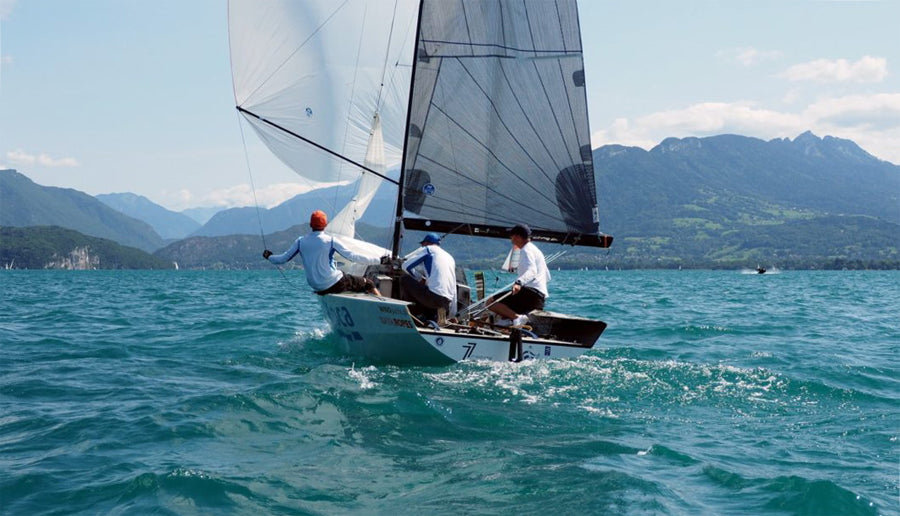
TARNACKI DOMINATES 2017 MICRO WITH ALL NEW NORTH INVENTORY
Tarnacki Dominates Micro class with all new North Inventory
With the support of 6-time World Champion Piotr Tarnacki, North Sails came into Micro class in 2017 with an all new prototype sail inventory which included:
- MK-1 Mainsail
- JK-1 and JK-1 Light Jibs
- SS-1 Spinnaker
Tarnacki with his team, 77 Racing dominated season with a stunning 23 out of 26 race wins in Polish Cup regattas, which included the Polish Nationals. The Polish fleet is the toughest Micro fleet in the world. The main test took place at the World Championship in France.
Sixty-eight crews were fighting for the 2017 Micro class World Championship title in French Annency. The competition was very tough with very light conditions for the event, making sailing a big tactical challenge. Due the lack of wind there were only 4 races, of which one was a long-distance race.
A championship battle took place between the two Polish crews, Piotr Tarnacki and Piotr Ogrodnik. Combined the skippers have won 10 World Championships since 2004 (6 times Tarnacki, 4 times Ogrodnik) so there was true duel of the Micro class giants. However Tarnacki took the overall win, giving him his 7th World title.
Piotr Tarnacki said :
“We were very pleased that we could use North Sails for this regatta. The Jk1-L Jib let us sail fast up to windward mark, but our biggest weapon was SS-1 Spinnaker which make us the fastest boat on a downwind course. We are very happy with our sails performance. This is first step for North Sails in Micro class, and we have already won everything this season. We are very happy, but now we will start preparing for the next worlds in our home waters in Poland. Together with North Sails we will keep developing these sail design to be even faster next year!”
If you are interested in any Micro class products, visit the One Design Class page to find an Expert.
READ MORE
READ MORE
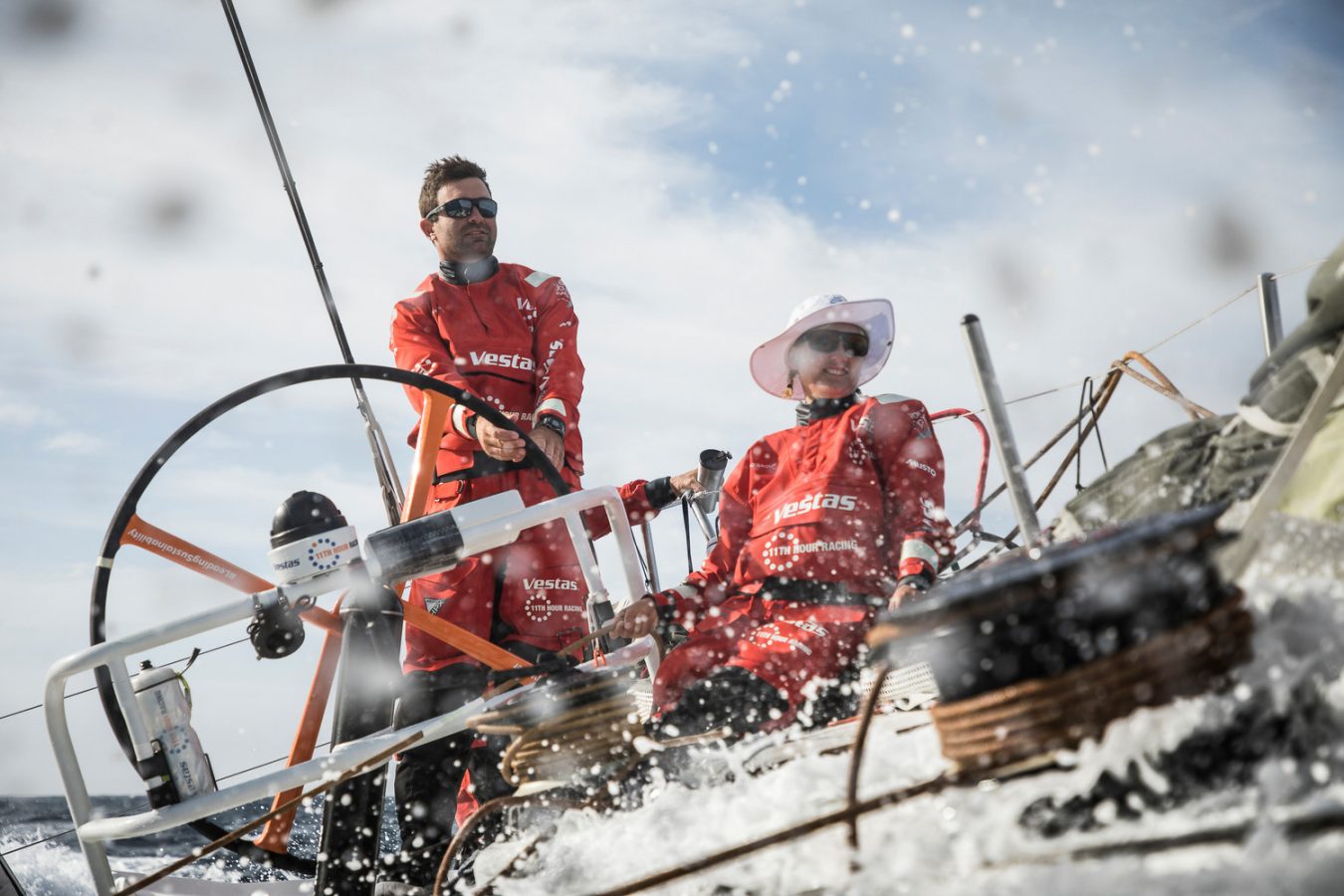
VOLVO LEG 3 PREVIEW WITH CHARLIE ENRIGHT
VOLVO LEG 3 PREVIEW
Charlie Enright, skipper of Vestas 11th Hour, shares his insights of what is to come next in life at the extreme
©Martin Keruzore / Volvo Ocean Race
Vestas 11th Hour’s skipper (and North Sails expert) Charlie Enright stopped by our Newport office on his brief trip home before the start of Leg 3 from Cape Town. We were able to sit down with him for a few minutes to chat about the race so far and check in before the fleet makes the deep Southern Ocean dive in Leg 3.
Two legs of the Volvo Ocean Race 2017-18 down. Your first big offshore leg complete. What is your first impression of the race so far?
My first impression is the racing is closer than ever, which I guess you’d come to expect given how close it was in the 2014-15 edition. Things are the same but different. The weather’s the same, the polars are the same, and now there’s overlap in the sailors. Difference is all players have been shaken up; same faces, different teams, different mix of knowledge within the teams.
You have a new team with a lot of experienced race veterans. How is it this time around? Since you’ve done this race before – what’s the difference in the team this time?
Mark and I inherently are experienced by having done one before. But, there’s a lot of people that have done this race for a long time and never won. So in addition to adding experience, we’ve tried to add winning experience. I think it’s important to differentiate between the two.
“I think that’s healthy to have a crew that brings different things to the table. We have a variety of ages and nationalities. We’ve got the ladies onboard. Keeping that whole thing running is fun, and vital to the success of the team.”
© Martin Keruzore / Volvo Ocean Race
Are your expectations higher or are they more realistic because you know more this time around as well?
Yes, higher. But it’s tough. I struggle with that question because there’s something great about being naïve. You know?
It can be great not knowing what will happen in the end…
And going for it. We didn’t know what we didn’t know last time, but at least we knew that. We didn’t go into it under any pretenses last time, by any means. But it’s nice to have a little experience to rely on.
“We didn’t have any expectations before because we didn’t know what to expect. Now we feel like we’re contenders in this race, and I think that the winner is going be the boat that improves the most between now and the finish. I feel Vestas 11th Hour Racing has every opportunity to be that boat.”
What would you say is the most difficult part of this race so far?
Trying to find boat speed, but that’s always the case. The fastest boat is going to win this race, and that’s what everybody’s yearning to be. We’ve got a little work to do in some very specific areas, but at least now, after this leg, we know what those areas are and where to focus our efforts.
© Ainhoa Sanchez
You’re heading to Melbourne on Sunday. What are you looking forward to (or not looking forward to…)?
Anyone that tells you that they like the cold of the Southern Ocean is probably lying. Having said that, I much prefer cold to the Equator because you can always put on another article of clothing. Conversely, once you’re baking in the sun, you can’t get any cooler.
But you know, I look forward to going downwind. That’s one of the greatest feelings in sailing. I look forward to the double points, I guess, but I don’t know why, because it doesn’t change how you approach the legs. You’re always trying to win. You just happen to be double points.
Do double points put more pressure on you guys?
It can’t. Or better said you can’t let it. I mean you can’t operate differently based on the fact that it’s double points. Some would say they are disproportionately happy or disproportionately angry after the fact, but it can’t affect the way you approach the leg.
How are the sails holding up?
Good. We had some sail damage in the last leg. We had a batten pocket come off our J1. It was one tack in the pre-start, in the river in Lisbon. But I think the damage might’ve occurred the day before, during the in-port race when it was a blunt 40 when we were sailing in a squall.
“Our 3Di sails continue to be a very robust product and the right one for the job Just like last race; the sails aren’t going to be something that you think twice about.”
Follow your favorite team at VolvoOceanRace.com for updates, latest news, routes, and results.
© Martin Keruzore / Volvo Ocean Race
© Ainhoa Sanchez
READ MORE
READ MORE
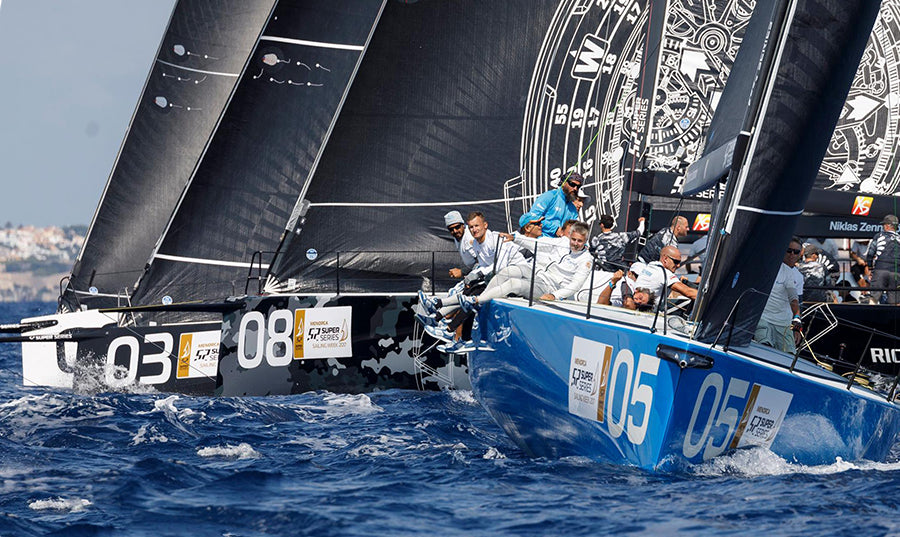
GRAND PRIX TREND REPORT
NORTH SAILS DESIGN TEAM HOSTS 2017 GRAND PRIX RACING DEBRIEF
Experts collaborate in two-day design meeting at North’s 3D headquarters in Minden, NV
© Nico Martinez / Martinez Studio
Earlier this month the North Sails Design Team hosted a collaborative Grand Prix racing debrief at the company’s 3D sailmaking headquarters in Minden, NV. Attendees brought a range of expertise to the discussion, including the TP52, RC44 and Maxi 72, as well as emerging classes such as the Melges 40 and ClubSwan 50. The two day agenda also covered discussion in complementary fields of software development and product engineering, led by North Sails Lead Programmer, Michael Richelsen.
Strength in design has kept North Sails ahead of the curve in providing the fastest sail shapes for clients throughout the sailing world. The design brief is an example of how the North Sails global team works together to secure a common foundation and commitment to technical excellence. As a result of the meeting, North Designers and stakeholders worldwide will receive a “Trend Report” for key classes and sail types with reflection on how these can affect designs for the wider market.
Per Andersson was recently appointed as head of North Sails 3D. His experience as a sail designer will ensure he has a hands-on role in the merging the processes of sail design and production. Beyond Per’s valuable contribution to the design discussions, he also hosted the group at his “home”, North’s largest 3D loft in Minden Nevada.
Paul Westlake, VP and North’s Grand Prix sales leader who together with Per Andersson hosted the group in Minden. In addition to his sales responsibilities, Paul provides first-hand feedback from the field through his various sailing commitments.
JB Braun inspects finishing details on a 3Di sail. JB provided the group with lessons learned in 2017 and updates to the North Design Suite as well as development news on everything from small boat one design through the 37th America’s Cup. As Head of Sail Design to a team of 80+ experts, JB is responsible for turning the meeting ideas into projects and providing focus to North’s design team.
Steve Calder, the lead designer for downwind, ran the debrief on Grand Prix downwind development and looking ahead to new concepts for 2018.
Magnus Doole led the group in a discussion on “Engine Above The Deck; ” a term coined by Terry Kohler, former owner of North Sails. Engine Above The Deck is used to describe integrated sail, rig and hull analysis and design.
Grant “Fuzz” Spanhake is the coach for Alegre and provides an “outside view” of North Sails performance during the 2017 season. Feedback from coaches and sailors is imperative to continued development and innovation within the Grand Prix design team.
Casually referred to as “the smartest people in North Sails,” Burns Fallow and Michael Richelsen are user and developer of North Design Suite. Burns, a lead designer for Superyachts and Grand Prix programs, has most recently been helping ETNZ with the AC75 rule. Michael is North Sails Lead Programmer who writes the proprietary software that runs North Design Suite. In addition to sail design; NDS makes the “Engine Above The Deck” concept possible.
Mickey Ickert provided a design debrief on the TP52, RC44 and Maxi 72. His debrief included design analysis of all teams, in all classes. The analysis gives North’s design team insight on what designs are delivering results and areas for improvement.
Juan Garay is a sail designer for TP52 Azzurra and oversees the continued development of North’s Virtual Wind Tunnel, a tool within the North Design Suite. VWT models air flow on downwind sails and the sail designer to visualize and analyze sail shape, sail forces, shape stability and ease of trim in the computer at 100% scale. Juan briefed the group on VWT updates and developments planned for 2018.
Shane Elliott, designer for TP52 Phoenix 2 and Grant Spanhake, watch as 3Di tapes are loaded into a tape head. The use of spread filament tapes used in conjunction with full-size 3Di molds is what give North 3Di its unprecedented combination of performance and durability.
READ MORE
READ MORE
HELSINGIN TOIMIPISTEESSÄ REMONTTIA JOULUKUUSSA
Helsingissä tehdään pienimuotoista remonttia joulukuun aikana ja olemme paikalla epäsäännöllisesti. Soitathan aina ennen tuloasi 040 5392477
READ MORE
READ MORE
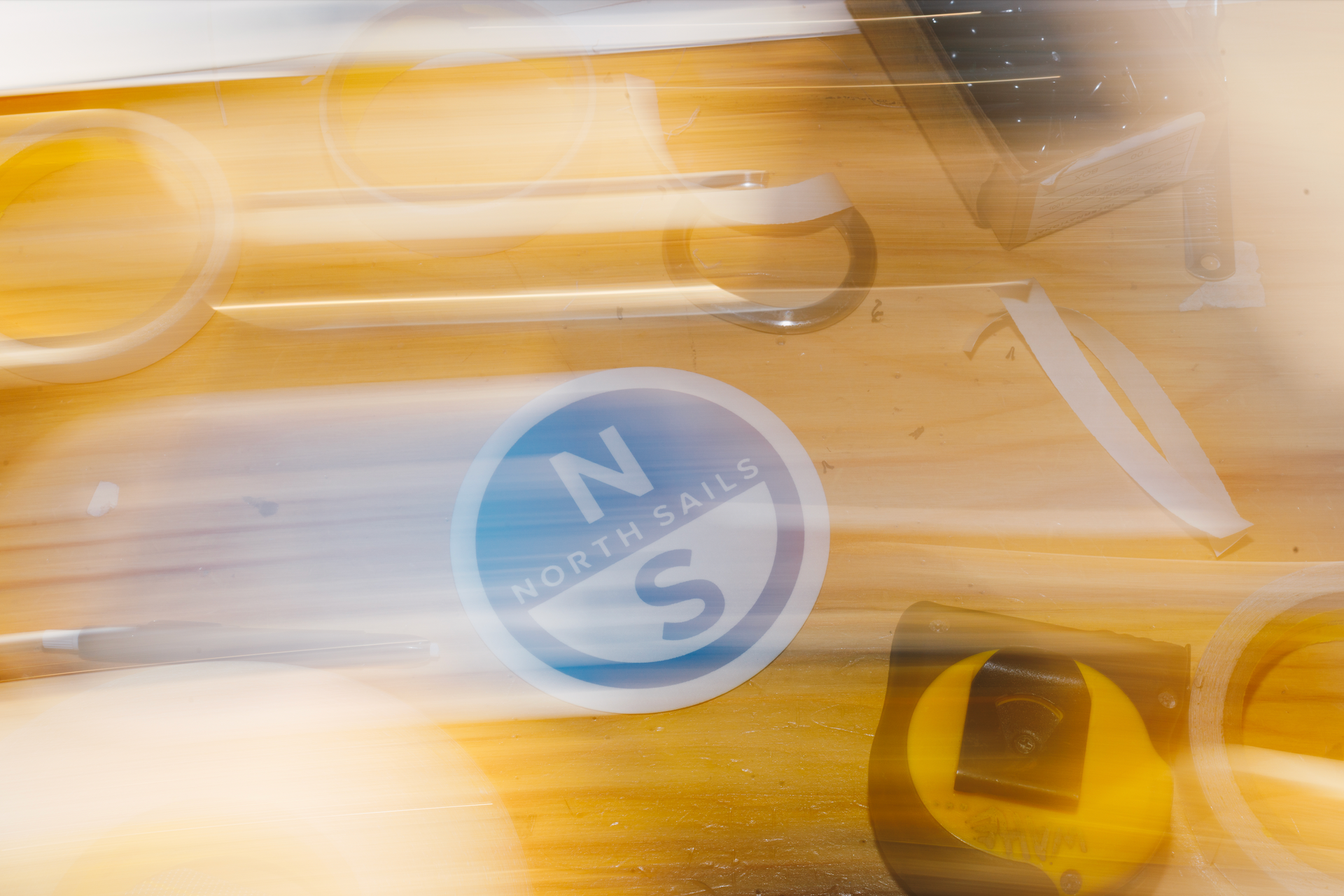
HOW TO CARE FOR YOUR SAILS THIS WINTER
As we come to the end of the sailing season and head into winter, the North Sails global service team is gearing up for a busy period - from helping clients prepare for the Caribbean season, to packing boats away for a winter hiatus.
READ MORE
READ MORE
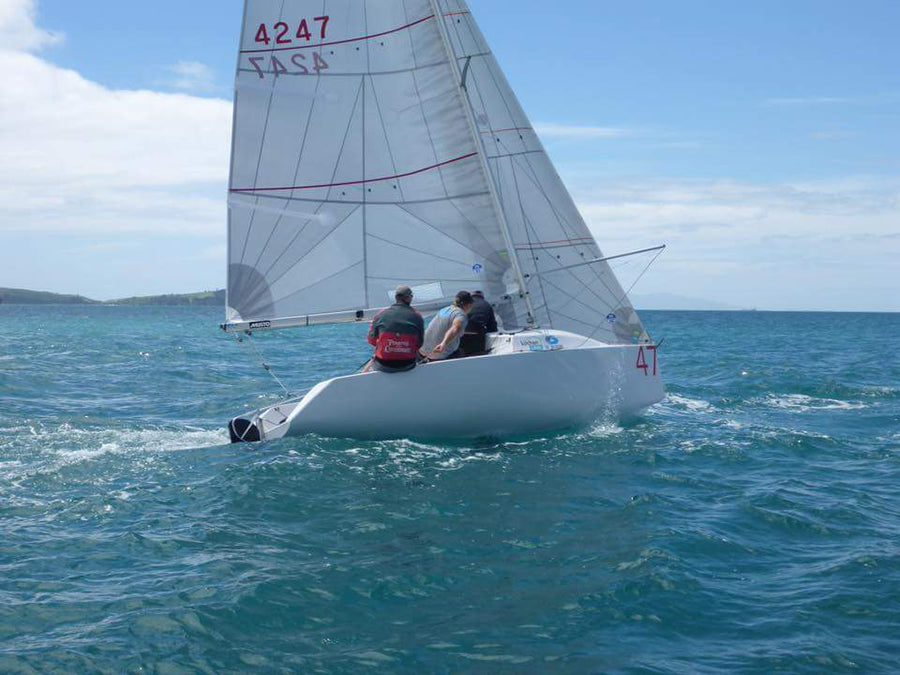
GREAT SEASON START FOR THE NORTH SAILS ONE DESIGN TEAM
THE SAILING SEASON HAS GOT UNDERWAY WITH A BANG FOR THE NORTH SAILS ONE DESIGN TEAM, WITH BOATS WITH NORTH SAILS WINNING THE OPTIMIST NORTH ISLAND CHAMPS AND ELLIOTT 5.9 NATIONALS.
Young Wakatere sailors Josh Hyde and George Lee Rush finished first and second in the gold fleet at the Opti competition, sailed at Lake Taupo in early November. Jack Olsen from Plimmerton, who also uses a North sail, finished first in the green fleet.
Elliot 5.9 Craig Satterthwaite
Derek Scott of North Sails One Design says all three sailors are have been using North sails, which are available in several different cuts.
The next big event for the highly competitive Optimist fleet is the Sir Peter Blake Regatta, hosted by Torbay in early December, before the Auckland champs in late January.
Scott himself sailed in the Elliott 5.9 nationals, crewing for Stu Clarke, who finished second. The regatta was won by Craig Satterthwaite, who had North salesman Matt Kelway on his crew. Both the two leading boats, and third-placed Sam Edwards, had North sails, with the result coming down to the last two of twelve races to decide the winner between Satterthwaite and Clarke.
Scott says North hopes to soon introduce 3Di sails into the class, with moulded mains and jibs to be available.
‘It’s going to be really good to bring 3Di technology to the class, as the class rules specify polyester cloth but these sails will have much less stretch,’ he says. ‘We’ll be getting some test sails soon and hope to have them more widely available next season.’
Scott has also been sailing a Paper Tiger, competing at the class’s sprint regatta at Lake Rotorua in October. Boats with North sails finished first, second and third.
North sails were to the fore at the Young 88 owners championship, sailed out of Bucklands Beach Yacht Club in mid-November. Auckland’s fickle spring weather meant only three of the five scheduled races could be sailed, but Raging Hormones, with North Sails New Zealand sales and marketing manager Andrew Wills aboard, took the gun in two of the races to win the regatta, with Slipstream 3 second and Waka Huia, with Scott and Kelway aboard, winning the other race to take out third. All three top boats were using North sails, with Raging Hormones and Waka Huia both running a full North inventory.
Other recent results include the OK Dinghy ‘Rum Bucket’ regatta, held at Labour Weekend at Wakatere Boating Club. The event was won by former Olympian Dan Slater, using a new North KAP-1 all-purpose sail, with a deep shape right down to the foot, allowing for power downwind and in the lighter wind ranges. Scott says Slater and fellow sailing legend Rod Davis have also been working with the North team to develop and test a new OK sail design.
From here the summer season is really starting to heat up, with the large Napier Sailing Club summer regatta in late November, then a range of national championships in January.
‘It’s going to be a busy summer, but hopefully a very successful one,’ says Scott.
READ MORE
READ MORE
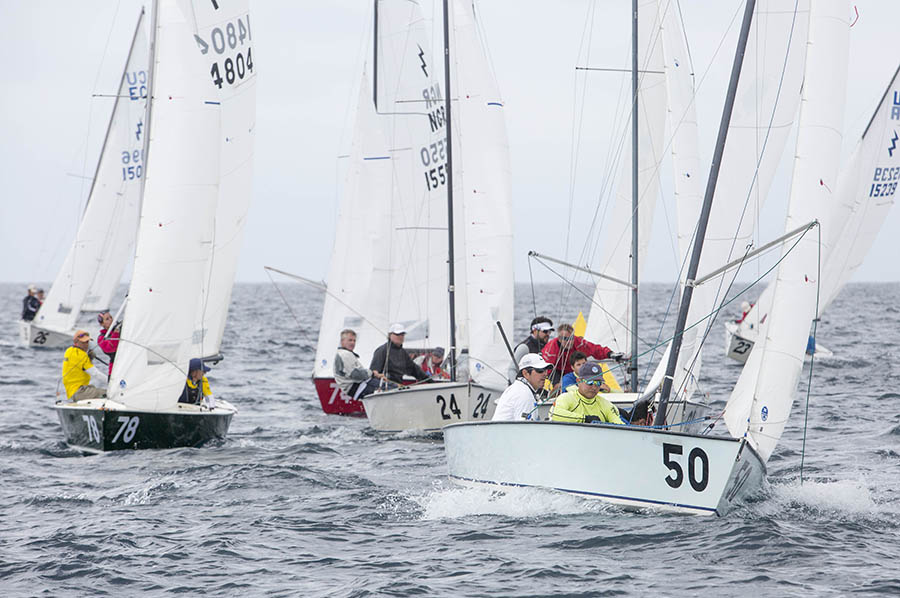
LIGHTNING WORLD CHAMPIONSHIP
2017 LIGHTNING WORLD CHAMPIONSHIP
North clients sail for speed in Ecuador taking the fleet by storm claiming World title, sweeping the podium
©Manuel Medir / Salinas Yacht Club
Fifty-six Lightning teams from 13 countries gathered in Salinas, Ecuador for the 2017 World Championship. Javier Conte and his teammates, Julio Alsogaray and Paula Salerno of team Argentina captured the 9 race championship in dominating fashion. Using North Sails M-5 main, 5A+ jib and R-2 spinnaker , Argentina scored six race wins and an overall total of 12 points on the scoresheet to cap an impressive 28-point margin of victory over the young runner-up team from the USA of Nick Sertl, Dylan Farrell and John Mastrandrea.
Salinas provided great breeze for sailing every day. As the breeze built every afternoon, the shifty conditions and variable wind patterns required skippers to concentrate on boat speed. A large hill located on Salinas Point caused confused wind patterns as it funneled down to the bay. Some teams found success extending out to the right as the shifts on the edges of the course were often game changers. Pressure lanes combined with significant shifts, including a distinct shift on the port lay line kept things interesting at the top mark and made finishes just as hard for competitors as it did the race committee scoring team.
Ched Proctor, sailing his aptly named Veggie Sub with son Charlie and Meredith Killion had excellent speed throughout the week. Coming off his win at the International Masters, Proctor, using the North M5 main, new V-17 jib and R2 spinnaker credited his team’s’ ability to focus on their jobs, allowing Ched to focus on driving which became a key sailing upwind in wavy conditions.
“We relied heavily on our middle crew member to make tactical decisions and the forward crew would call the puffs and lulls,” said Ched.
Congratulations to our clients on outstanding results! Seven countries including Argentina, Ecuador, Puerto Rico, Brazil, Chile, Canada, and the United States rounded out the top ten spots. Junior team Freak Gasoline Fight Accident placed 2nd overall, with five race finishes in the top ten. Way to go Nick Sertl and team! Raul Rios and his team Black Beauty representing Puerto Rico, topping the podium off at 3rd place with five top-five race finishes.
Special congrats to team Argentina’s Javier Conte, Julio Alsogaray, and Paula Salerno, who not only won the North Americans earlier this year but took the South American title earlier in the week and finished off by claiming the 2017 Lightning World Champion title!
Team Argentina was powered by North Sails M5 mainsail, 5-A+ jib, and R2 spinnaker.
Impressive sailing by our clients, and great memories for all to take home. Thank you, Salinas Yacht Club for running three fantastic events International Masters, South Americans, Worlds> over the course of nine days, giving sailors an experience of a lifetime.
“It’s hard to think of a better place to hold a Championship Lightning event. The organizers did a fantastic job, and I look forward to returning to Salinas soon”, said Jackson Benvenutti, tactician on Hard Asset.
Click here for more information on our products, or to speak with your local expert
Visit our tuning guide to get the winning numbers for your next event!
2017 World Championship
Lightning
1
Argentina / Javier Conte
2
Freak Gasoline Fight Accident / Nick Sertl
3
Black Beauty / Raul Rios
4
Veggie Sub / Ched Proctor
5
Team PatStrong / David Starck
6
The Cat / Marvin Beckmann
7*
Money for Nothing / Mark Sertl
8
Ojo de Lince / Alberto Gonzalez
9
No DesesPerez / Cristobal Perez
10
Layline / Claudio Biekarck
11
Hard Asset / Josh Goldman
12
15590 / Jeff Linton
13
Fly Volatore / Juan Santos
14
15412 / Tim Scanlon
15
El Doctorado / Felipe Robles
* Denotes Partial North Sails Inventory
Full Results
©Manuel Medir / Salinas Yacht Club
©Manuel Medir / Salinas Yacht Club
©Manuel Medir / Salinas Yacht Club
©Manuel Medir / Salinas Yacht Club
©Manuel Medir / Salinas Yacht Club
Congrats Team Argentina, 2017 Lightning South American & World Champions!
READ MORE
READ MORE
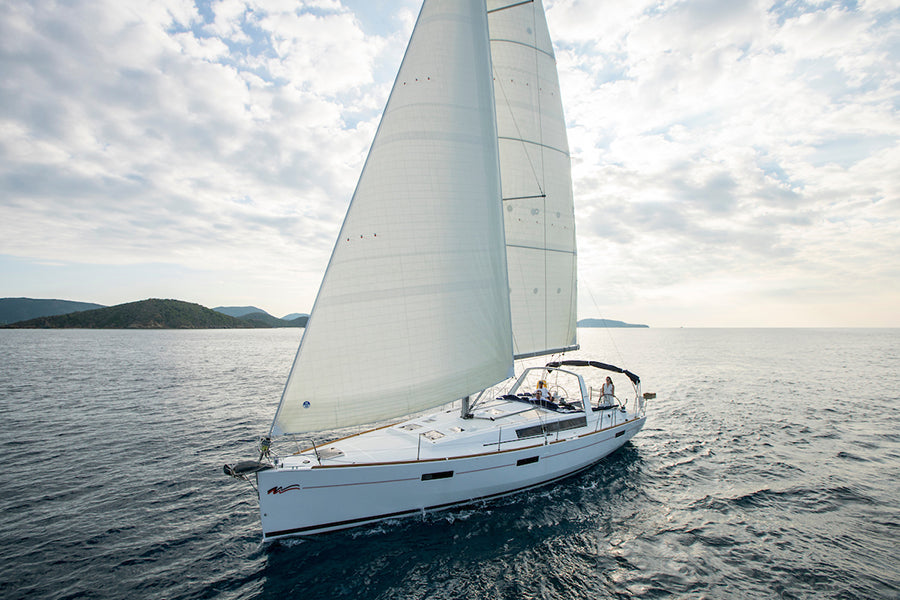
¿HAS PENSADO EN PASARTE AL 3Di?
¿HAS PENSADO EN PASARTE AL 3DI? TE EXPLICAMOS POR QUÉ TE INTERESA HACERLO.
Desde su revolucionaria aparición a bordo del Alinghi en la America’s Cup de 2007, el 3Di ha pasado de equipar exclusivamente a barcos de competición de máximo nivel, a popularizarse con versiones adaptadas a todo tipo de barcos de regata y crucero.
Si estás pensando en renovar las velas de tu crucero, el nuevo 3Di Nordac es tu mejor elección. Se trata de un composite hecho en 3D, con cintas de poliéster, sin mylar, más estable y más duradero que las velas de paneles de Dacron, y a un precio similar. No encontrarás mejor compromiso entre calidad y precio.
Si lo que te interesa es actualizar tu inventario de velas para regatear la próxima temporada, te recomendamos planificar tu compra con antelación, al menos mes y medio antes de la primera regata. Hoy es posible competir con la misma tecnología 3Di que equipan los mejores equipos de competición del mundo, las velas más estables, ligeras y con mejor rendimiento del mercado. Pregunta a tu agente North Sails más cercano sobre nuestra gama 3Di para regata, y te asesorará sobre la mejor opción para tus necesidades: 3Di RAW (máximo rendimiento, magnífica durabilidad y ligereza) o 3Di Endurance (para un extra de durabilidad).
READ MORE
READ MORE
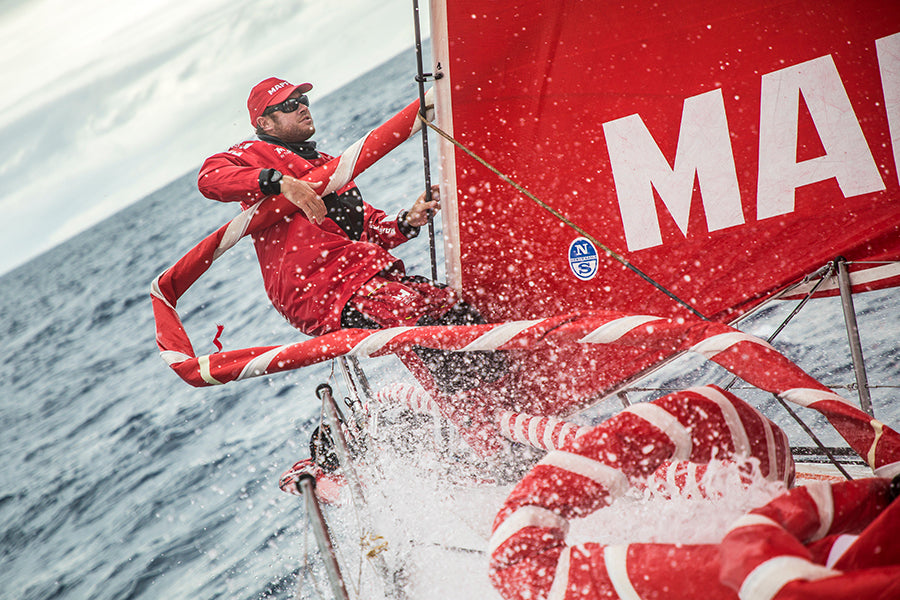
LA SEGUNDA ETAPA DE LA VOR PONE A PRUEBA EL 3Di
LA SEGUNDA ETAPA DE LA VOR PONE A PRUEBA EL 3Di
La flota de la Volvo Ocean Race completó la segunda etapa entre Lisboa y Ciudad del Cabo, considerada una de las etapas reinas del recorrido de 45.000 millas náuticas diseñado para esta edición.
En su salida al Atlántico, los barcos afrontaron vientos duros que pusieron a prueba la habilidad de sus tripulaciones para navegar a velocidades superiores a los 30 nudos, un aperitivo de lo que les esperaría en el rápido recorrido de 7.000 millas hasta Sudáfrica. Los equipos pudieron usar todo su inventario de velas North Sails 3Di, que una vez más demostraron sus prestaciones y resistencia. El MAPFRE de Xabi Fernández fue el mejor de este segundo asalto y lidera la provisional de cara a la tercera etapa, que partirá de Ciudad del Cabo rumbo a Melbourne el próximo 10 de diciembre.
Más información sobre la presencia de North Sails en la Volvo Ocean Race, aquí
READ MORE
READ MORE
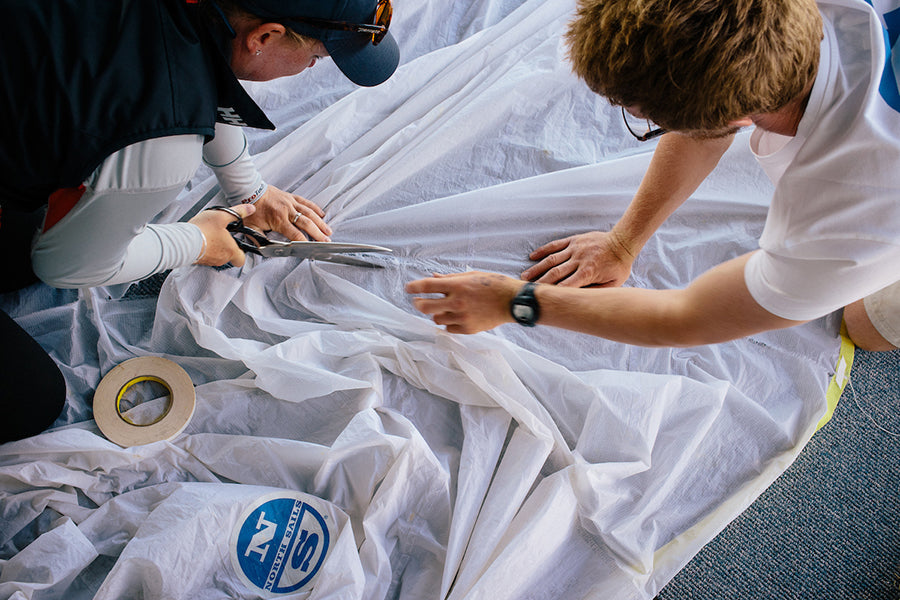
SERVICIO A LA FLOTA DE LA ARC
SERVICIO A LA FLOTA DE LA ARC
La 32ª edición de la regata ARC comenzó en Las Palmas de Gran Canaria el pasado 19 de noviembre.
Cerca de 200 barcos de 40 nacionalidades participan en esta prueba de navegación de cruce del Atlántico hasta la isla caribeña de Santa Lucía, un recorrido de 2.700 millas náuticas. En North Sails nos enorgullecemos de dar servicio a la flota un año más, tanto de mantenimiento como de reparación e incluso reposición para clientes que quisieron actualizar su inventario antes de poner rumbo al Caribe. North Sails está representado en las Islas Canarias por Alisios Sailing (Gran Canaria) y Lanzarote Sails (Lanzarote).
Más información sobre los clinics North Sails, aquí
READ MORE
READ MORE
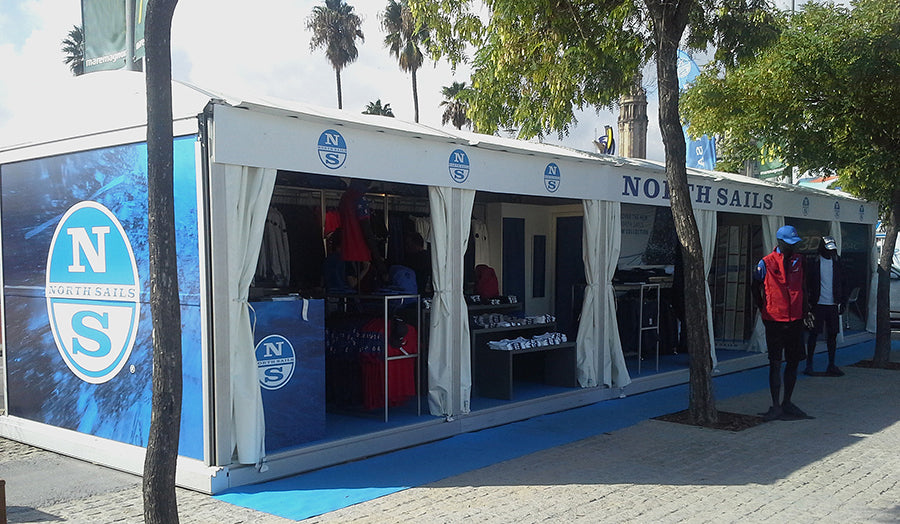
SALONES NÁUTICOS DE VALENCIA Y BARCELONA
SALONES NÁUTICOS DE VALENCIA Y BARCELONA
Un año más, North Sails España ha participado en el Salón Náutico de Barcelona (11-15 de octubre) y en el Valencia Boat Show – Salón Náutico de Valencia (1-5 de noviembre), dos de las exposiciones temáticas más importantes de España.
En Barcelona compartimos espacio por primera vez con nuestros hermanos de North Sails Apparel en un magnífico stand de 45 metros cuadrados que no dejó de recibir visitas en los cinco días que duró el evento. Nuestros clientes se mostraron especialmente interesados por el nuevo 3Di Nordac, el producto con el que revolucionamos el mercado de crucero.
Más información, aquí
READ MORE
READ MORE
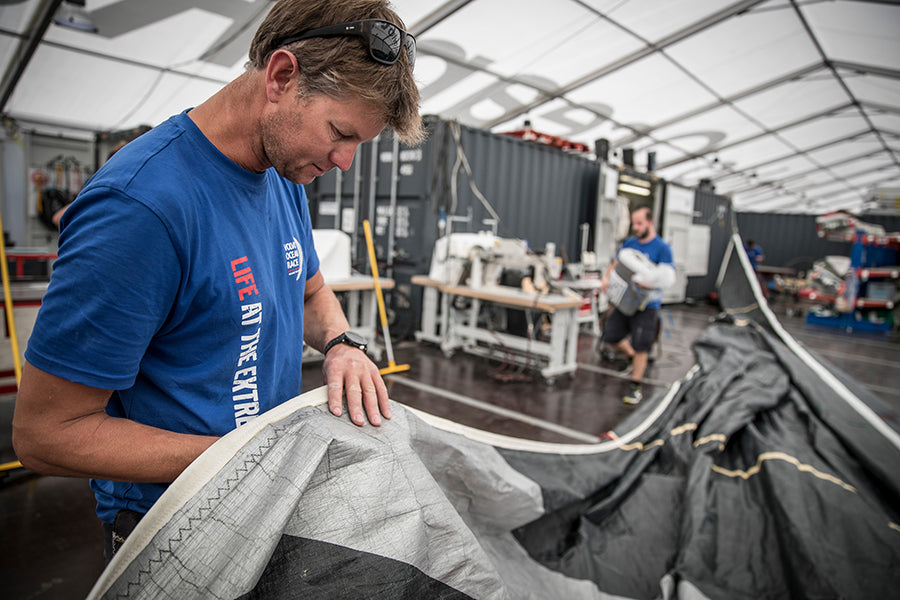
NORTH SAILS 3Di Y LA VELERÍA DEL ASTILLERO VOLVO OCEAN RACE
NORTH SAILS 3Di Y LA VELERÍA DEL ASTILLERO VOLVO OCEAN RACE
La estructura de la Volvo Ocean Race incorpora en esta edición 2017-18 la velería de su astillero (Boatyard), un servicio de mantenimiento y reparación de velas común a toda la flota. Hemos hablado con su director, Nathan Quirk, sobre su funcionamiento y los cambios que ha supuesto la llegada de la tecnología North Sails 3Di a la regata.
North Sails comenzó a fabricar velas para la Volvo Ocean Race hace 30 años, cuando todavía se denominaba Whitbread Round the World Race. Desde entonces, el mundo de la vela ha cambiado radicalmente al tiempo que la regata se ha profesionalizado y los barcos se han vuelto más veloces. En su condición de auténtico motor de los barcos, las velas han evolucionado para adaptarse a las exigencias de los tiempos, y North Sails ha liderado cada avance en diseño de formas y materiales.
El desarrollo de la tecnología North Sails 3Di surgió en parte como respuesta a la demanda de los regatistas de velas que fueran más ligeras y proporcionaran mayor durabilidad, algo crítico en navegación oceánica. Las North Sails 3Di se fabrican con cintas de filamento pre-impregnadas que imitan las cualidades de distribución de cargas y mantenimiento de forma de una vela rígida, pero añadiendo ligereza, durabilidad y facilidad de uso. Su llegada supuso toda una revolución que cambió el enfoque de los equipos hacia las velas, ahora más ligeras, robustas y fiables que nunca.
En la actual edición de la Volvo Ocean Race, la segunda que se corre con monotipos VO65 dotados de velas North Sails, la organización aporta la velería del Boatyard (astillero), un servicio de mantenimiento y reparación común para todos los participantes. Nathan Quirk es su director:
“Las 3Di soportan increíblemente bien el esfuerzo que les exigen las tripulaciones”, explica. “Les exigen más que en ninguna otra regata, pero aún así aguantan. Además, los tripulantes confían más en las 3Di que en otras velas, al punto de que muchos equipos ya no llevan máquina de coser a bordo. Si piensas en dos o tres ediciones atrás, en cada etapa teníamos que embarcar mucho material de reparación y adhesivo, más una máquina de coser de 50 kilos. En cuanto llegó la 3Di, los equipos se dieron cuenta de que ya no tenían que realizar tanta reparación. Entonces comenzaron a dejar las máquinas de coser en tierra, y ahora la mayoría de los equipos ya ni tienen una. Eso da idea del avance que han supuesto estas velas en los últimos ocho o diez años. Un cambio enorme”.
La incorporación de la velería en el astillero tiene gran repercusión en la estructura y los costes operativos de los equipos. Y todo ello con un reducido grupo de especialistas trabajando desde la organización, como indica Quirk:
“Cuento con dos chicos a jornada completa y North Sails aporta otros dos veleros para cada período de mantenimiento. Hay cinco personas en la velería en los momentos de máxima actividad durante las paradas, que no es demasiado si lo comparas con los tiempos en que los equipos se encargaban de sus propias velas, en algunos casos con tres o hasta cuatro veleros por equipo”.
El equipo de la velería del astillero dispone de toda la información relativa a las velas de cada barco, incluyendo un registro del número de horas que ha navegado cada vela, lo que facilita su tarea a la hora de calcular el desgaste, los posibles puntos que requieren mantenimiento, y anticiparse a posibles problemas.
“Todavía tenemos que dar mantenimiento a las velas, revisar su desgaste y estar al tanto de su estado general, pero apenas tenemos que realizar reparaciones importantes”, explica Quirk. “En toda la edición 2014-15, sólo tuvimos cuatro velas con problemas. Gracias al 3Di, las reparaciones son mas fáciles, mientras antes en muchas ocasiones nos veíamos obligados a tirarlas directamente. Tenemos cinco días para dar servicio a entre 50 y 60 velas. Antes, los equipos tenían que recortar y modificar las formas de las velas para mantenerlas en condiciones de rendir a su nivel óptimo. Ahora ya no lo hacemos, sencillamente porque no es necesario: los equipos completan la vuelta al mundo con las velas 3Di, y todavía están en un magnífico estado. Las mayores, por ejemplo, en la pasada edición completaron 40.000 millas sin un solo problema. Hace tres ediciones, cada equipo necesitaba tres mayores para completar la vuelta al mundo, y eso que el recorrido era más corto”.
Gracias a la tecnología North Sails 3Di, los equipos ven cómo sus costes en velería disminuyen radicalmente. Cada barco puede afrontar la participación con sólo dos sets de velas, aunque probablemente sólo necesitarán uno de ellos para completar la circunnavegación.
La Volvo Ocean Race 2017-18 llevará a los siete equipos alrededor del mundo en un viaje de 45.000 millas náuticas dividido en 11 etapas. En cada puerto de escala, los expertos de la velería del astillero esperan a la flota para someter a las velas a una exhaustiva revisión y garantizar así que afrontan la siguiente etapa al cien por cien de su capacidad.
Cada Volvo Ocean 65 equipa ocho velas North Sails 3Di más un tormentín de Spectra. Un inventario reducido pero que cubre las necesidades en cada rumbo y en cada intensidad de viento, siempre con las prestaciones y la fiabilidad únicas del 3Di.
READ MORE
READ MORE
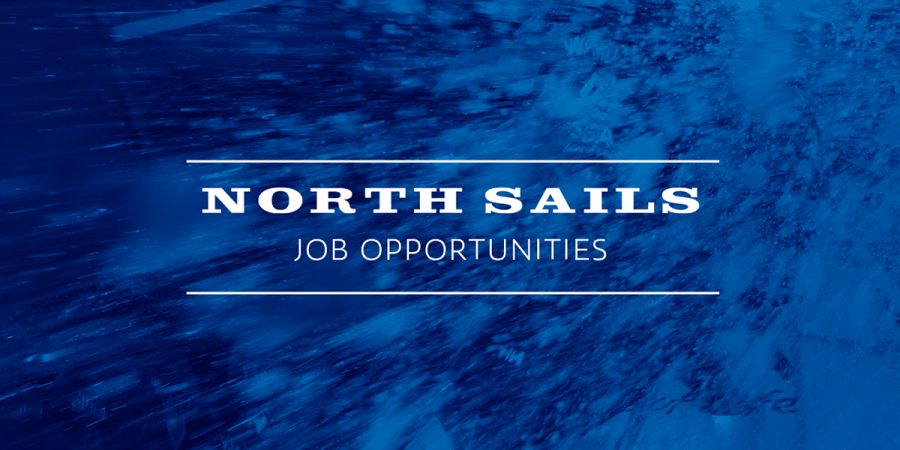
NORTH SAILS AUCKLAND IS LOOKING TO EXPAND THE TEAM
NORTH SAILS LOOKING FOR AN ENTHUSIASTIC, KNOWLEDGEABLE SALESPERSON TO JOIN ITS AUCKLAND TEAM.
You need to be passionate about sailing and sails, keen to share your love of the sport with others and to help find the best solutions for clients. The person we’re looking for will be honest and trustworthy, reliable, and not afraid of a bit of hard work — but also have a good sense of humour and enjoy working in a friendly, dynamic environment.
North Sails is renowned as the world’s top sailmaker, and has supplied every sail to the America’s Cup for the past 20 years. North has been the exclusive sail supplier for the Volvo Ocean Race for the last two events, and every winner of the round-the-world race since 1994 has carried North sails. North’s workmanship can also be seen on hundreds of other boats, from racing dinghies to luxury superyachts.
For your chance to become part of the North Sails team, contact the NZ sales manager, Andrew Wills:
Andrew.wills@northsails.com
+64 21535735
READ MORE
READ MORE
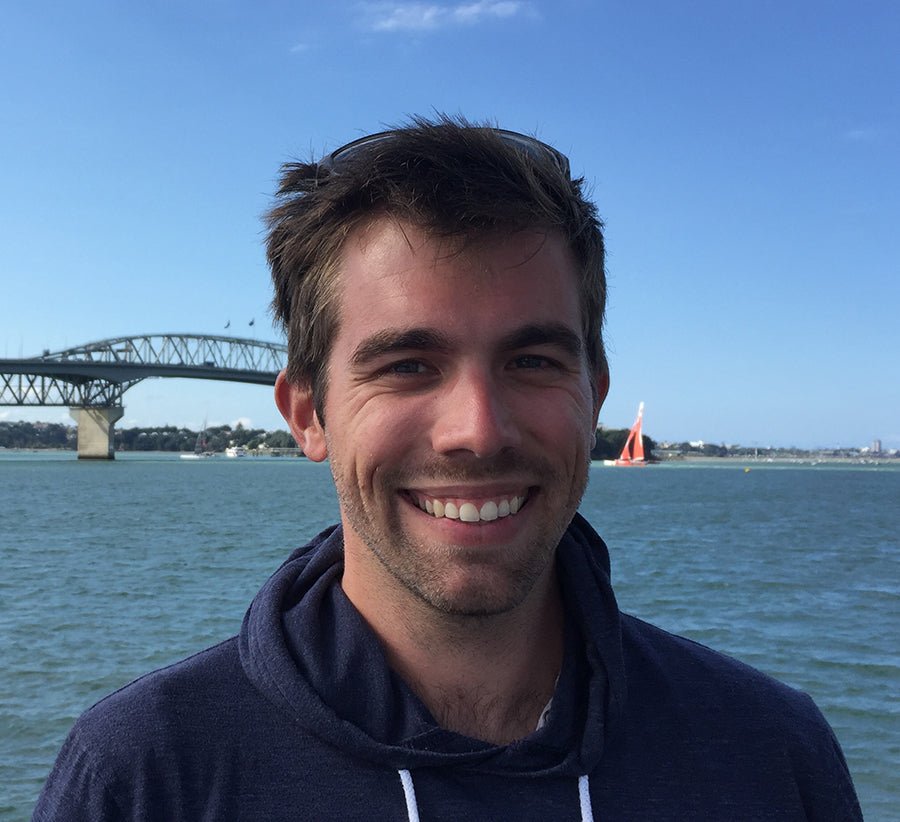
FRENCH DESIGN ENGINEER MATHIEU GUILLAUD JOINS THE AUCKLAND TEAM
NORTH SAILS IS PLEASED TO ANNOUNCE THE ADDITION OF FRENCH DESIGN ENGINEER MATHIEU GUILLAUD TO ITS AUCKLAND TEAM.
Guillaud, from the western coast of France, first came to New Zealand, and North, back in 2015, but has recently returned from a stint servicing superyacht sails in Mallorca to join the design team here.
Mathieu Guillaud
Guillaud trained as a mechanical design engineer but always wanted to work in the marine industry. He originally came to Auckland to improve his English and gain experience after finishing his science degree and engineering apprenticeship, ‘because it’s the city of sailing.’
He started work interning as a sailmaker in the North loft, then while on secondment to North Sails Palma was offered a permanent position back here.
‘Since the beginning I knew I wanted to be a sail designer, so as soon as I was offered the opportunity to come back to New Zealand and move into this area, I jumped at it,’ he says.
Guillaud grew up sailing Lasers, on the coast not far from the port of Les Sables-d’Olonne, home of the Vendée Globe single-handed round the world race. ‘When I was growing up that was always a big deal,’ he says.
He now mainly sails keelboats, going out on a range of different boats to gain experience and knowledge of what Kiwi customers want.
‘When you are sailing with good people they can teach you a lot about what they want, and you can use that information when you are designing their sails.’
Guillaud is loving living in the new home of the America’s Cup, and is excited about what the future holds.
‘It’s the whole culture here — it’s all about sailing. Now everything is coming back here and it’s really exciting for New Zealand and the marine industry here.’
READ MORE
READ MORE
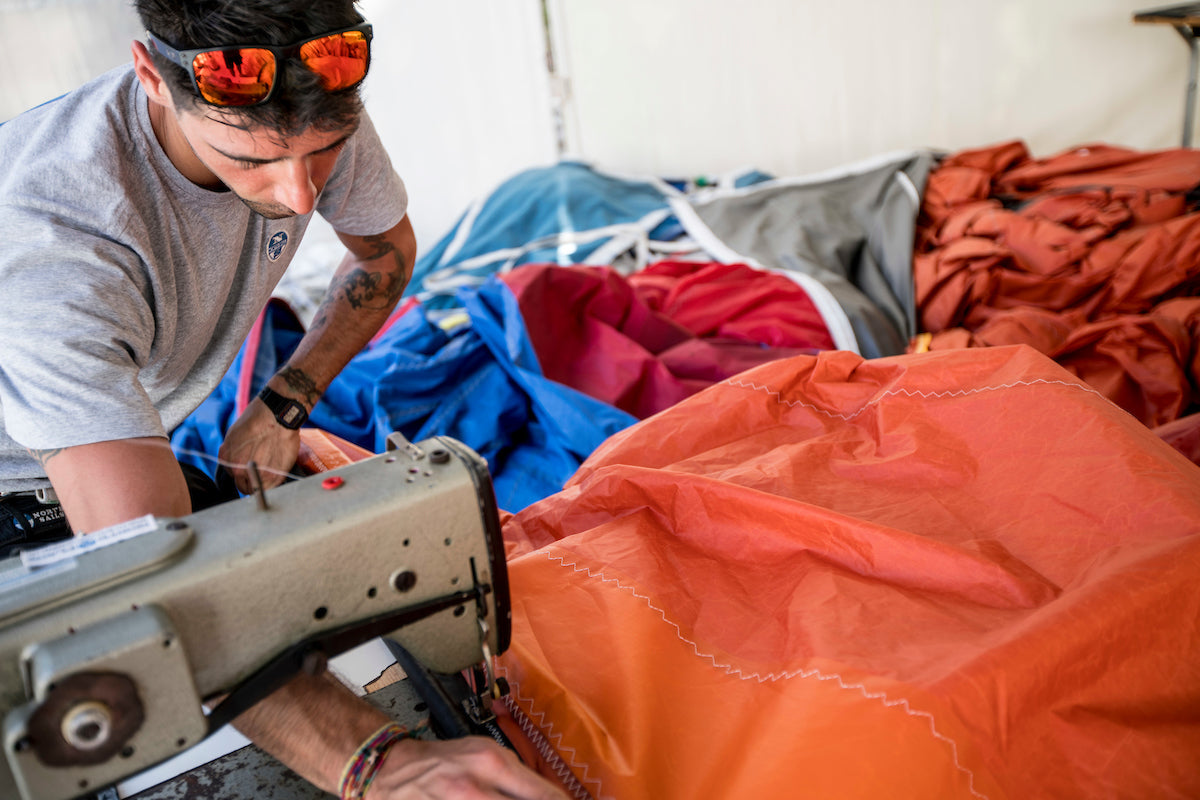
TIPS VOOR WINTER ONDERHOUD ZEILEN VAN ONZE NORTH SAILS EXPERTS
10 tips voor winter onderhoud van uw zeilen
Winter onderhoud zeilen - Met de winter voor de deur maakt het North Sails Service Team zich wereldwijd op voor enkele drukke maanden. We helpen onze klanten om zich voor te bereiden op het Caraïbische seizoen en zijn druk met het klaar maken en servicen van boten voor de winterperiode.
De in Palma gevestigde Ben Fletcher is Global Service Manager voor North Sails en deelt zijn beste tips om uw zeilen goed te beschermen: "Bij North Sails bieden we onderhoud service aan al onze klanten, vanaf een kleine Optimist tot aan een Tripp 85m."
"Voor alle eigenaren van alle boten, groot of klein, geldt exact hetzelfde; ze verdienen allemaal de beste, optimaal onderhouden zeilen. North Sails Certified Service voorziet hierin. Of u nou een wedstrijdzeiler bent of een toerzeiler, er is niemand beter in staat om samen met u uw zeilen in optimale conditie te houden, de levensduur te maximaliseren en de ultieme zeilperformance te behouden."
1. Voorkom onnodig klapperen van zeilen
Klapperen en trillende achterlijken kunnen de levensduur van uw zeilen aanzienlijk verkorten. Minimaliseer tegen de wind in varen op de motor met de zeilen omhoog en probeer zo snel mogelijk na het hijsen van de zeilen een koers te varen waarop de zeilen vol staan.
2. Verstel de reguleerlijn om trillende achterlijken te verhelpen
Afhankelijk van de leeftijd van het zeil, de windsterkte en de spanning op de schoot dient de spanning op de reguleerlijn aangepast te worden. Bij te weinig spanning zal het zeil klapperen en bij teveel spanning zal het achterlijk naar binnen gaan staan. Een goede stand is de reguleerlijn net iets meer aan trekken dan het moment waarop het klapperen stopt.
3. Gebruik uw zeilen voor het ontworpen windbereik
Neem contact op met uw North Sails Experts wanneer u het aanbevolen windbereik voor uw zeilen niet weet.
4. Laat de zeilen niet onder spanning staan
Zorg dat u de spanning van de genuaval, onderlijkstrekker en reeflijnen af haalt wanneer u klaar bent met zeilen. Op deze manier staan de zeilen niet onnodig onder spanning. Wanneer u langdurig van de boot weg gaat raden wij ook aan de spanning van de zeillatten te halen.
5. Voorkom onnodige blootstelling aan UV
UV straling is één van de grootste vijanden van uw zeilen. Het beste is om rolgenua’s te beschermen met een UV strook op het achter- en onderlijk. Wanneer u uw grootzeil op de giek laat, zorg dan dat deze altijd afgedekt wordt met een goede hoes.
6. Spoel uw zeilen met zoet water en droog ze voordat u ze opbergt om schimmel en uitgelopen kleuren te voorkomen
Spoel de hardware van het zeil met zoet water om corrosie te voorkomen en bewaar uw zeilen op een goed geventileerde, droge locatie. Daarnaast is het drogen van de zeilen voordat ze opgeborgen worden minstens zo belangrijk als het spoelen zelf. Natte zeilen veroorzaken schimmels. North Sails kan het reinigen van de zeilen ook voor u verzorgen.
7. Voorkom dat kreukels blijvende vouwen worden
Voorkom het vouwen van de zeilen op reeds bestaande vouwen zodat kleine kreukels in het zeil niet blijvend zijn.
8. Spoel zeilzakritsen regelmatig en spuit deze in met een siliconenspray
9. Laat uw zeilen minstens een keer per jaar controleren door een North Sails Certified Service expert
Wanneer u uw zeilen regelmatig laat controleren door een North Sails Certified Service expert kunt u op tijd kleine beschadigingen aan uw zeilen laten herstellen en voorkomen dat grotere problemen uw weekend of vakantie verstoren.
10. Houd een zeil logboek bij
Maak regelmatig foto’s van uw zeilen en houd bij hoe vaak u de zeilen gebruikt zodat uw zeilmaker een goed overzicht heeft van uw zeilinventaris. Uw foto’s kunnen ook gedigitaliseerd en geanalyseerd worden met een North Sail Scan. Neem contact op
met Jacco Huijgen voor meer details.
Voor meer informatie of vragen over winter onderhoud van uw zeilen kunt u contact opnemen met één van onze North Sails Experts in Stabroek, Rotterdam of Almere.
READ MORE
READ MORE
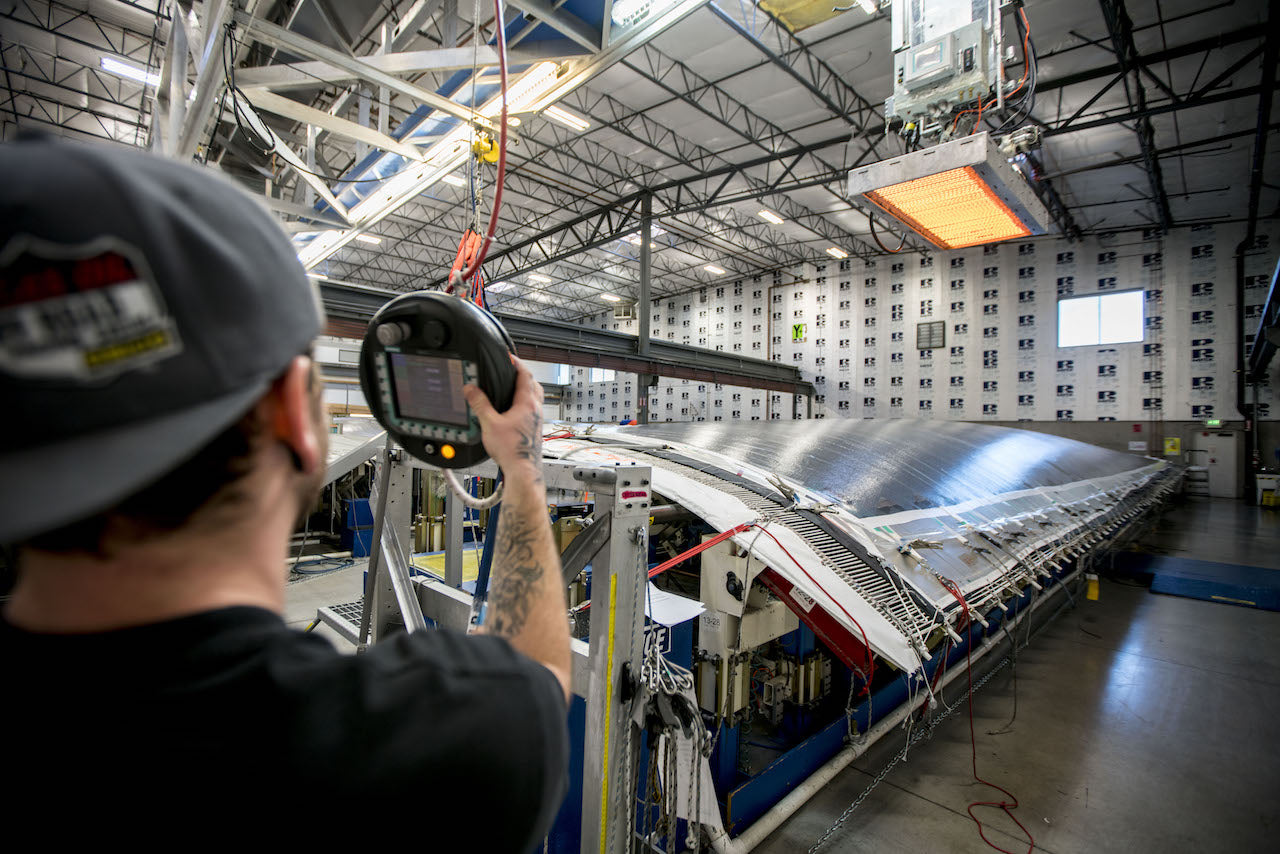
NORTH SAILS DOUBLES DOWN ON R&D
NORTH SAILS DOUBLES DOWN ON R&D
At North Sails, product development and technological innovation have been core functions for 60 years. As we look toward 2018, the company will further solidify its research and development roots by establishing a formal R&D hub at the loft in Vannes, France. Head-up by French designer, Gautier Sergent, the R&D center will organize the activities and energy that have historically been widespread throughout North Sails.
Most of the significant breakthroughs in sailmaking, from 3D molded sail manufacturing through to today’s 3Di composite foil structures, have been achieved by merging sophisticated computer modeling with creative mechanical engineering and bold ideas hatched on the water. With the Vannes R&D center, North Sails takes a proactive approach to bringing these three pillars of progress together.
Tools of the Trade
Fluid-Structure Interaction, or “FSI” in engineer-speak, is the practice of analyzing the relationship between a structure and its fluid environment, such as a hull passing through water or a sail through the wind. North’s development of bespoke software began in 1977 with the digitalization of 2D curves on the world’s first computers. Over the years it evolved to include a family of modules, notably MemBrain™ and Flow™ in 1987, which couple to apply wind pressure to a sail’s surface, calculate the load forces created and the resulting deformed shapes. Today, North Sails Design Suite™ (NDS) is the most powerful and diverse sail design tool in the industry with 14 modules delivering unprecedented flexibility to sail design and rig/hull analysis. By interfacing with Open Foam software, NDS offers a complete FSI and the ability for North Sails designers to virtually test a boat and sails in an infinite variety of conditions before the boat is even built.
Even Better in 3D
If designers use software to draw a perfect shape, it’s the engineer’s job to build it in real life. North Design Suite is fully integrated with North’s automated 3D manufacturing, providing the designer and the engineer complementary tools to achieve results. Starting with raw materials, the North Sails R&D team is able to design and manufacture a sample completely from scratch within a controlled manufacturing process. This opportunity for in-house development has fueled the patent of new manufacturing technologies and breakthrough products. The 1992 introduction of North Sails 3DL marked the first sails to be built on a three-dimensional mold according to a design load path. North Sails 3Di followed in 2010 to mark the first composite sail ever brought to market. Also built on a 3D mold, North 3Di has set a new standard for shape and structural durability, with clients sailing upwards of 5,000 hours on the same set of sails, while breaking the toughest records on the ocean.
Dreams with Discipline
Our founder, Lowell North, pioneered his own approach to sailmaking by applying a scientific method to the pursuit of his vision. Remaining at the forefront of development is possibly the clearest example of how Lowell’s core values have enabled North Sails to prosper well beyond his own tenure. No idea is rejected for being too difficult. All development is carried out with the discipline of scientific method.
It takes confidence to dream, and expertise to make dreams reality. By anchoring North Sails R&D in Vannes, the team joins a community that has consistently pushed the boundaries of our sport harder, and earlier, than anywhere in the world. North’s track record of disrupting the industry with new technology matches the ambition of the world’s top sailors, many of them based in France.
As the new leader of North Sails R&D, Gautier Sergent brings a wealth of experience and fresh energy to the department. A French native, Gautier started out as an apprentice designing for a senior team at North Sails in New Zealand – another highly innovative sailing pole – after which he took on a sequence of major design projects for the company. Gautier is the Volvo Ocean Race sail designer of record for the VO65, including the 2014-15 and 2017-18 race inventories, and designs for a handful of high profile clients currently making history on the water; Thomas Coville, Francois Gabart, Jean-Pierre Dick to name a few. As Thomas broke the Transat Jacques Vabre course record this week, Francois broke his own standing 24hr solo distance record on Tuesday, November 14th. At the moment the young Francois is sailing well beyond the pace needed to surpass Thomas’ circumnavigation benchmark, on a boat that dates our wildest dreams by a year or two.
After breaking the singlehanded circumnavigation record last Christmas, Thomas Coville thanked North Sails.
“I want to thank North Sails for trusting in me. It’s easy to find people to trust you after the idea works, but North Sails was with me from the start. And that is why I am here today. With our project, with our dreams, you prove there is nothing and no one who can stop you if you have a dream.”
In the past three years, Gautier relocated to Minden, NV in the United States to manage the company’s 3Di production hub. The 3D factories are special places where material science, mechanical engineering and machine build are all handled completely in-house. Three years of working in close proximity with North’s inventive staff has given Gautier a solid foundation in our capabilities, the potential of our materials and the R&D process that has proven successful. Along with his background in sail design, this experience combines well with a personal passion for cultivating ideas and leading a team to pursue the impossible.
READ MORE
READ MORE
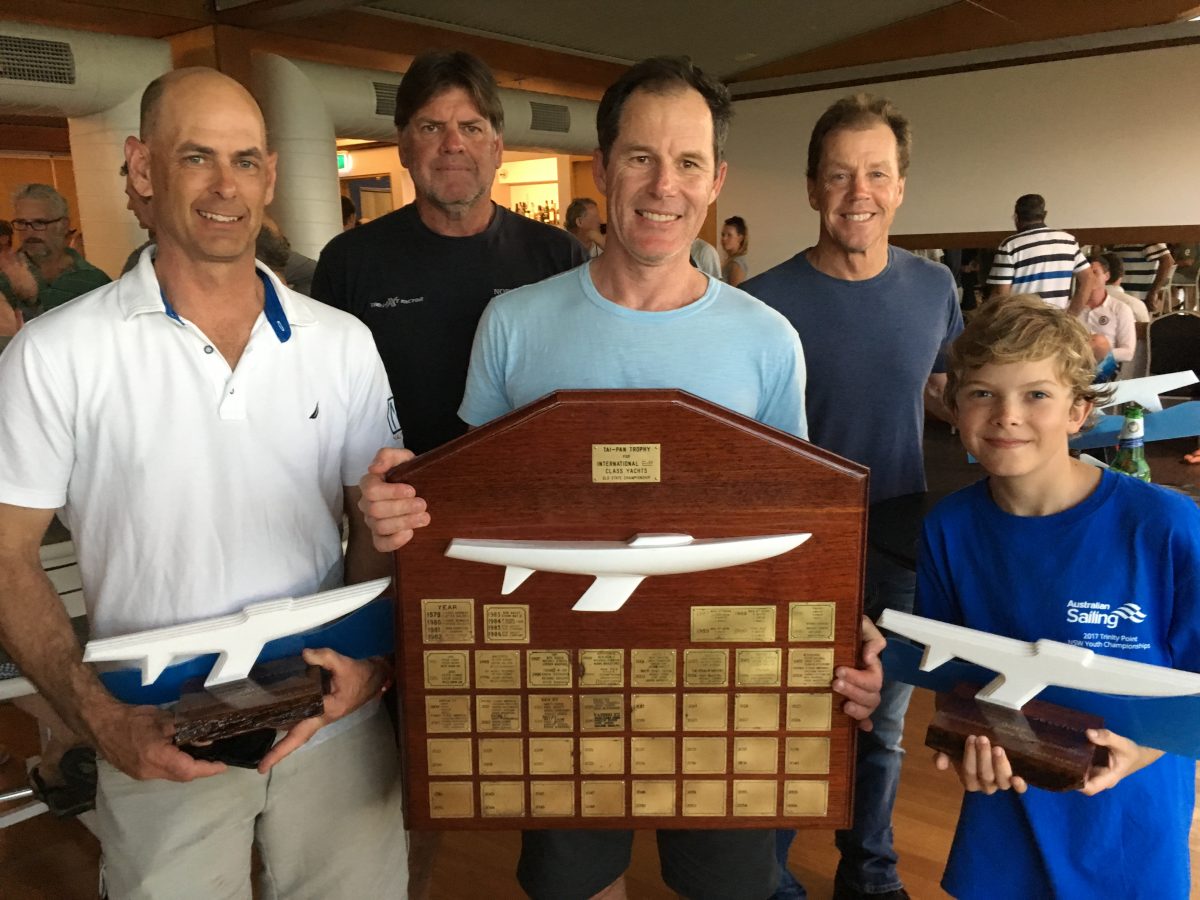
"CLARKY" WINS ETCHELLS QLD STATE TITLE
Australian Etchells Class expert Ian Johnson interviewed David Clark (Clarky) after his convincing win at the QLD, Etchells State titles against a very strong fleet.
Clarky teamed up with well known Western Australian sailors Ray Smith, Alan Smith and young champion from QLD Mitchell Luxton at just 11 years of age.
The winning team © Kylie Wilson - positiveimage.com.au
Backing the team up was larger than life Mike Hughes also from W.A. Hughesy ran the coach boat and kept the team in check on and off the water.
All of them had sailed with each other before but not as an Etchells team of four.
Having the two days on the water prior to the regatta to get the team work and boat speed on track was invaluable. This is when having a coach and coach boat pays off says Clarky. Tuning up with Bruce Ferguson and his team was great to get up to speed.
I asked Clarky about the crew roles on the boat.
"All of us knew each other well and the dynamics fitted pretty quickly. Young Mitch Luxton sails Optis. He also sails with his brothers and family at RQYS. Having a young set of eyes and extra set of hands was great. "
"Ray Smith did the main sheet and kept the boat rolling, and me in check. Ray is a great sailor and loves his Etchells racing. This program was put together by Ray.
Alan Smith sat up the front and did tactics. Alan and I sailed together in the Sydney Worlds so It didn't take long to get our communication up to speed. He did a very good job."
Working hard down wind © Kylie Wilson - positiveimage.com.au
What boat equipment were you using Clarky?
"The boat is a new Smidmore boat and Smidmore mast.
We used North Sails Jibs, LM2L and LM2H, Main TKR and a VMG Spinnaker."
It was the first time I have sailed with North Sails in a long time. I never felt compromised with boat speed. It was nice not to think about sails and go yacht racing.
What's next Clarky?
"I will start thinking about putting the program together for the Worlds in Brisbane next year. It was great to sail at RQYS, It's an amazing facility, race track and organisation I and look forward to coming back next year."
READ MORE
READ MORE
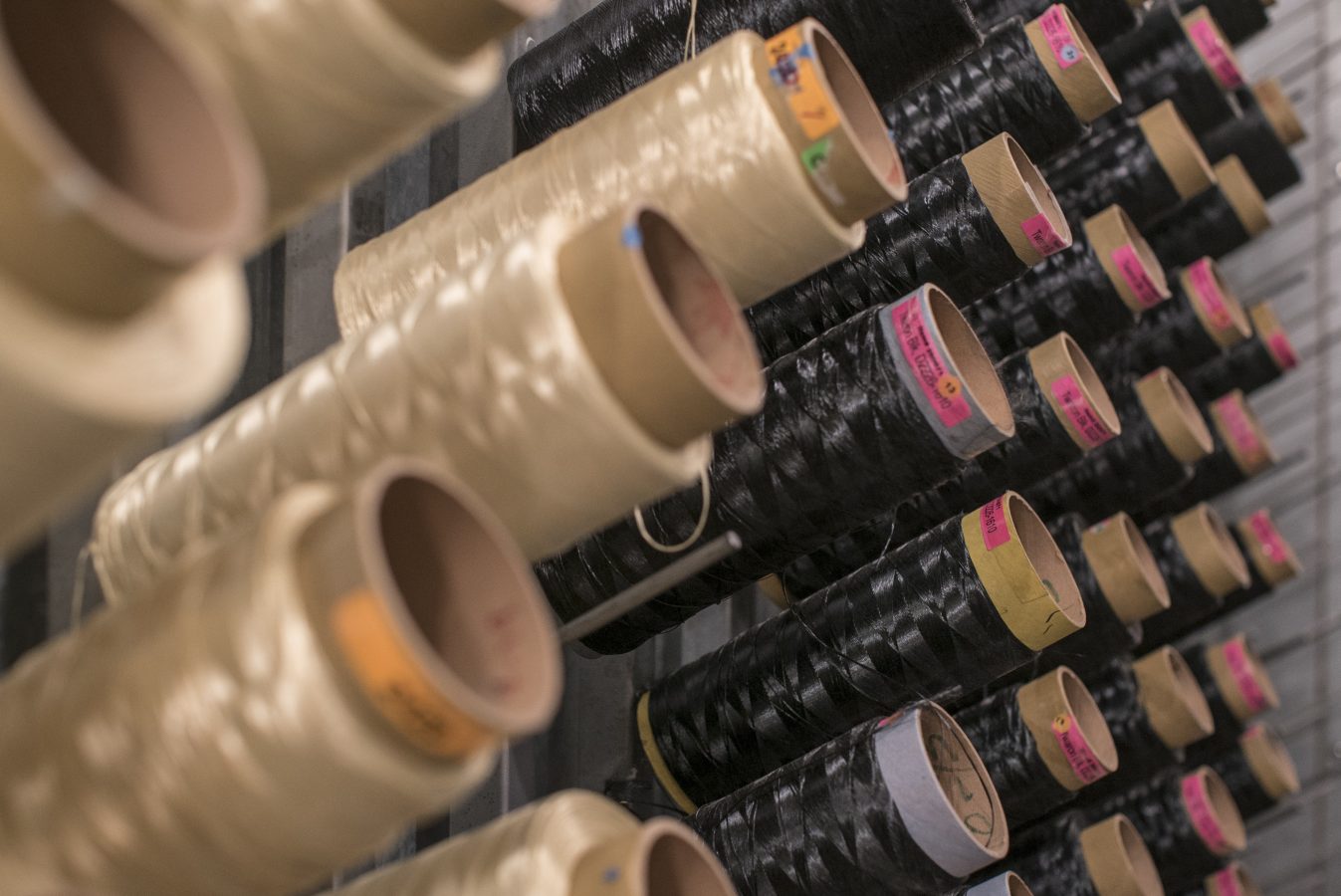
NORTH SAILS GROUP SELECTS VANNES FOR ITS GLOBAL R&D HUB
North Sails Group selects Vannes for Global R&D Hub
Boat Industry interviews North Sails head of R&D, Gautier Sergent on his ambitions for the department
2018 will see North Sails found a center for Research and Development out of Vannes (France). Experienced designer and department head, Gautier Sergent, explains to BoatIndustry their objectives and philosophy, which have the potential to go beyond sails.
You are going to take charge of the North Sails R&D center in Vannes. Could you tell us how you got here?
Gautier Sergent: After completing my studies in engineering in France, I joined North Sails in New Zealand in 1999 for a final internship. At the dawn of the America’s Cup in 2000, the teams were very busy out there and so I was able to help, which got my foot in the door. I was hired by the sail loft whilst also undertaking a Masters at Auckland University in the Yacht Research Unit at the same time. I then worked on the development of the software for CFD (Computational Fluid Dynamics), and then I became a designer.
In 2010, I returned to France to work on the Groupama project in the Volvo Ocean Race. I spent time with members of the crew who also each had their own teams, such as Thomas Coville. We built up some great relationships and I stayed in France to work on a number of IMOCA and Ultime projects.
In 2014, I became head of the 3D factories for the North Sails group in Minden (USA) and Sri Lanka. At the end of three years, which we had agreed would be the minimum required for such a post, we determined with management that my profile and expectations corresponded to the new project to develop R&D within the group. From October 1st 2017, I will therefore take charge of the new R&D center.
How has R&D at North Sails worked up until now and what were the reasons behind creating this R&D center?
GS: Of course R&D existed before this initiative. It is even part of the DNA of North Sails, but up until now it was spread within all the different entities of the group. It was never the priority of one person in charge, which could slow down the process. Moreover, it was never considered for all the markets and the information was scattered.
From now on, I will be in charge of structuring and coordinating the R&D efforts for North Sails around the world. Thanks to the R&D center, we will be able to streamline and ensure the research efforts are as efficient as possible. As a first step, I want to establish an inventory and back catalogue of North Sails R&D. From there, we will be able to establish a 5 year plan of attack and forecast the budgetary and personnel requirements. The objective in the long term will be to hire 3-4 people.
What are the main areas of R&D that you are exploring?
GS: Even if the subjects are refined after the inventory, several research topics are already envisaged. There will obviously be development for CFD software. We will also work to simplify and integrate as much as possible, or even completely remove the some finishing aspects of sails, such as straps. We are going to study the integration of the mast and sail with Southern Spars which, together with North Sails, is part of the North Technology Group. Electronics and the gathering of data is an area we’d like to streamline in order to better understand the dynamic behavior of sails, and apply this knowledge to physical test protocols and laboratory simulation for sails.
We will also focus on product development and continue to expand 3Di to cover all types of sailing. With this year’s introduction of 3Di NORDAC, we have made a huge step by using a new material: Dacron. With this result we will work to see the possibilities of marrying up polyester fibers with Aramid, Dyneema or Carbon, to draw out the best characteristics from each one.
Why did North Sails choose France to install its R&D center?
GS: The French sailing market is one of the least cautious. The projects that one can find between Lorient, Port-La-Forêt and la Trinité are exciting and the French are not afraid to invest in technology.
On the other hand, with the tax credit, it is possible to reduce personnel costs to the level of other countries. Among the hires at the R&D center, there will certainly be someone in charge of partnership management with universities, companies and grants.
This interview was originally published by BoatInsider.com
© Amory Ross/ North Sails
© Ian Roman / North Sails
© Ainhoa Sanchez/Volvo Ocean Race
READ MORE
READ MORE
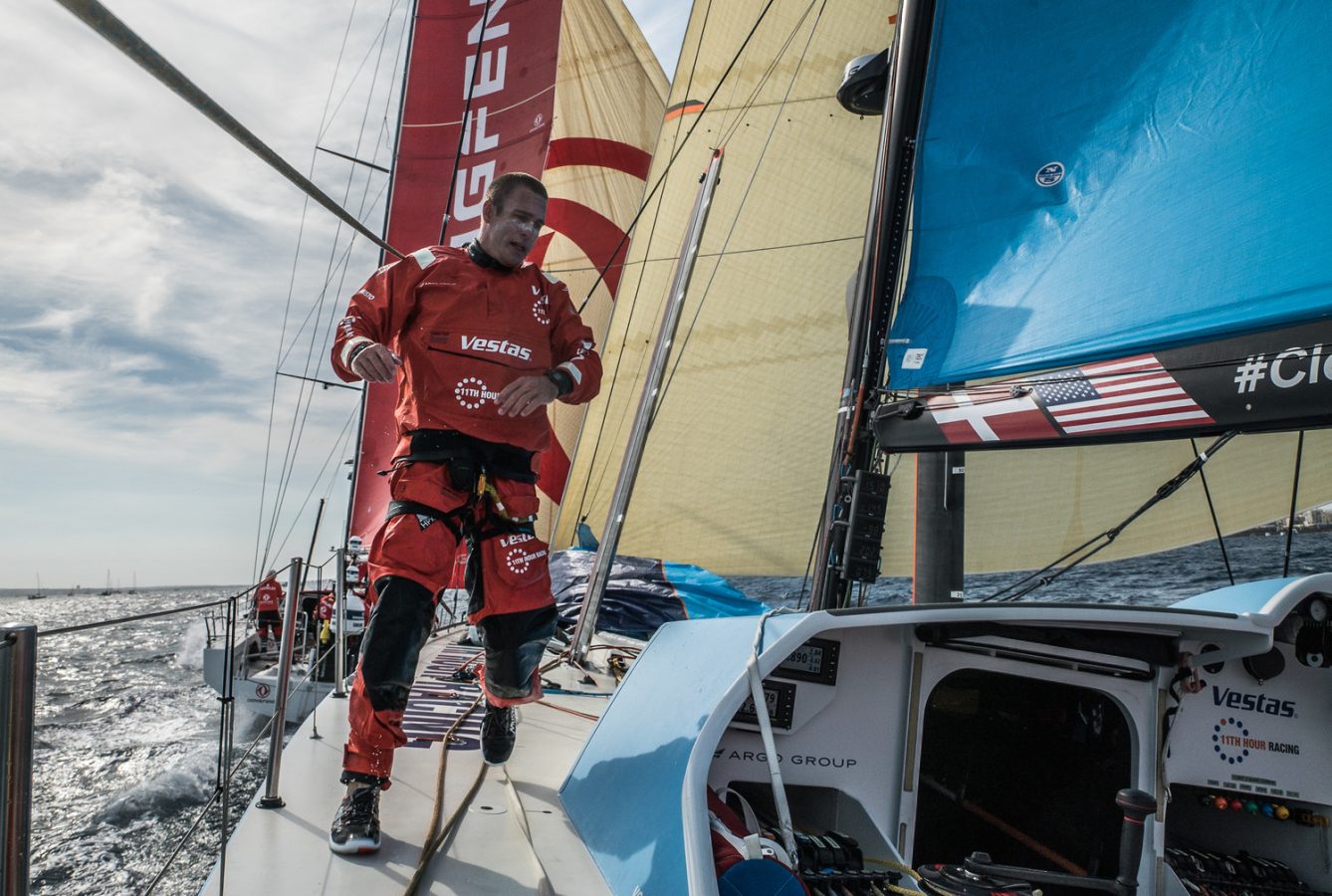
3Di FORCE FEATURED IN SEAHORSE TECHNICAL REVIEW
Fast Boats Just Got Faster
The 3Di Force Code 0 built for Volvo winner Groupama is now available for all
© Pedro Martinez / Volvo Ocean Race | Mapfre leads this year’s seven-boat Volvo Ocean Race fleet across the startline in Alicante. An increasingly popular application of 3Di Force can be seen here in the one design A3 in this year’s VO65 sail inventory.
Building on its success with 3Di across grand prix, offshore and superyacht fleets, North Sails has launched a new variant tailored specifically for downwind applications. For the Volvo Ocean Race 2011-12 sail limits on the outrageous VO70s were tightened down following the previous event from 24 to 17 sails for the whole race. North’s immediate focus was to try to figure out if any sails could be removed from the previous inventory without negatively affecting performance over the length of the course. 3Di was a new technology back then, and the bet was taken by both North Sails and some of the teams that it would perform better, and for more hours than string sails, therefore allowing fewer sails to be carried onboard.
Gautier Sergent, lead sail designer, had felt that in heavy-air downwind crews tended to back off to avoid breaking the boat – and the sailors. So if there was a sail that could be removed from the replacement cycle through less wear and tear, it might be the heavy-air downwind fractional Code 0 – as long as weight did not have to be added to make it bulletproof. Hence it was decided to develop a new fractional Code 0 that could last the whole race, while being light, fast and stable enough to reach at higher angles than the previous sail; the 3Di Force concept was born. This sail type not only went around the world on Groupama without any problems, it ended up becoming quite famous… as the team approached Lorient on the race’s epic penultimate leg.
With the wind blowing 48-50kt, it was time to gybe for the finish. The Groupamacrew decided to gybe with everything up, focusing their attention on the mainsail to ensure they did not break all their battens… or drop the mast. So the fractional Code 0 would have to survive this manoeuvre while being attended to last, left to flog in the howling conditions before being sheeted back in. The crew pulled it off, the sail survived. And they went on to win the leg and the race.
Skipper Franck Cammas later reported to Sergent that they had faith in their 3Di Force and were not unduly worried about breaking the sail – being more concerned about dropping the mast…
Similar on the outside… inside it’s a whole different story
The 3Di layout spreads filament pre-peg tapes in a multiplicity of orientations which enables a downwind sail to be engineered with high precision, and without the weight of the film required for a Mylar-based string sail. 3Di manufacture is also a vertically integrated process, North Sails controlling everything down to the tape manufacture. This allows the company to tailor materials for applications and opens up an infinite number of fibre combinations in terms of type, dpi and adhesive content/type.
This is what allows Force to be completely different from 3Di Raw. 3Di Force was designed from the outset for downwind applications, so loadings are quite different from the upwind case and more biased towards the luff than the leech. The AWS is typically much lower downwind and the sails much larger than upwind sails, so the weight becomes a greater factor in ensuring the sail flies correctly.
The loading is also more dynamic because of the broader angles and faster AWA changes as the boat accelerates/slows. This requires a high strength-to-weight ratio: the ability for a sail to sustain high loads for a given weight.
The sails are deeper than upwind sails as well, so the weight-tomodulus ratio (the ability of a sail to resist stretch for a given weight) can be slightly moderated. In fibre terms this typically means significantly more Dyneema than would be used in an upwind sail.
Combining those two factors – a luff-loaded structure and high Dyneema content – is a great solution for a light but durable downwind sail, while retaining the flying stability of 3Di. 3Di Force employs North’s proprietary 3D moulding technology with its precise control over shape, combined with the high-resolution
3Di tape structure. The end result is 3Di Force being capable of creating super-light sails with exceptional shape stability.
Why did it take North so long to release 3Di Force to the general market? Mainly because its application was limited due to the minimum weight of a 3Di sail at the time. Later, in 2013, North invented 3Di Raw, which reduced the minimum achievable weight without compromising the sail structure. Today 3Di Force has become the benchmark for downwind sails on fast boats. It is light, strong, very precisely shaped and more stable than other technologies. Sailors commonly highlight improvements in acceleration detected with sails built in 3Di Force; a big reason for this responsive performance is that the unmatched stability of these sails means better use of gusts, translating the extra power into speed. It also shares the attribute of every 3Di sail and increases the sweet spot/effective wind range of the sail, thereby reducing the number of sails needed.
From Imoca 60s to Ultimes, boats are doing away with paneled downwind sails completely. The 3Di Force fractional Code 0 is also a great addition to the armory when reaching with AWA ranging from as close as 45° upwards…
This story was originally published in Seahorse Magazine Technical Review, December 2017.
© Jen Edney/Volvo Ocean Race
READ MORE
READ MORE
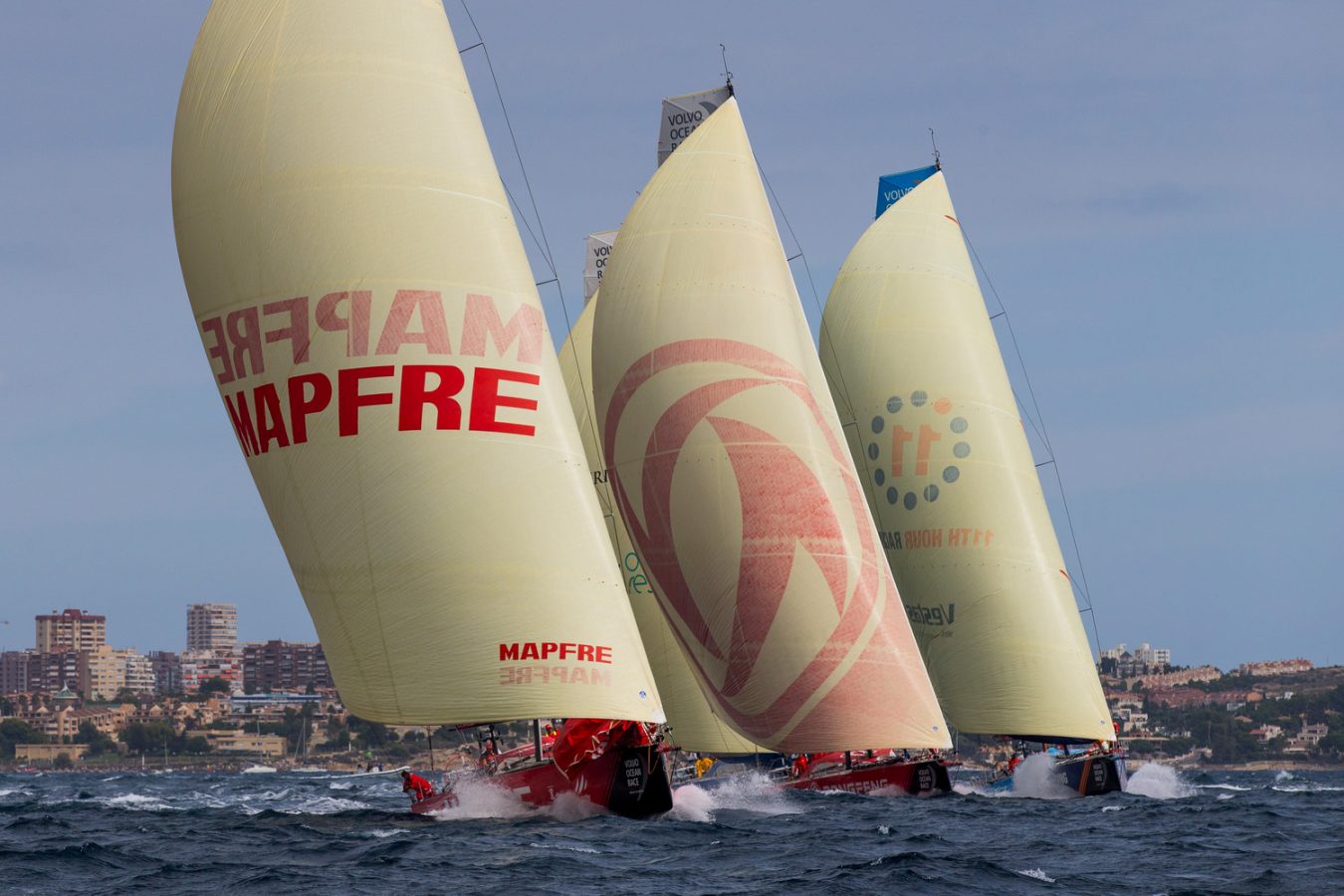
SAIL PROFILE: VOLVO OCEAN RACE A3
SAIL PROFILE: VOLVO OCEAN RACE A3
What are those yellow sails on the Volvo Ocean Race boats? North Sails CEO, Dan Neri, explains what’s so unique about the Volvo Ocean 65 A3
© Pedro Martinez / Volvo Ocean Race
The Volvo Ocean 65 A3 is unique because it is shaped like an Asymmetric Spinnaker, built like an upwind sail and furls like a genoa. The sail structure is 3Di Force, the lightest application of the 3Di composite sail product line.
3Di Force sails are made using prepreg tapes with a very high concentration of UltraPE material, co-mingled with Aramid filaments. The UltraPE provides high modulus and incredible toughness while the Aramid component resists compression and shrink. Like all 3Di sails, Force products are free of Mylar films which is one reason why the 3Di structures have extremely high strength to weight ratios. The newly developed 3Di Force product is so strong, and so reliable, that the Super-Maxi Comanche brought a single downwind Force sail for its recent Transpac record-setting run to Hawaii.
The yellow hue of the Force sails comes from the combination of UltraPE filaments (which are translucent, white) and Aramid filaments (which are gold). To keep the weight as low as possible, the A3 sails have very little branding so they show their true colors. All of the other sails in the Volvo Ocean Race 65 inventory are fully branded which masks the color of the sail structure. We are especially proud of the work done by the North Graphics team for this edition of the VOR. Our team painted 130 VOR sails over the course of just 6 months. We think the sails all look fantastic with the teams’ colors and logos.
All 3Di sails, including 3Di Force sails, are made on North Sails proprietary, full scale adjustable molds. However, a careful look at the photos will reveal a number of seams in the Force sails. The seams are required because these sails have very high camber ratios (remember, they are essentially spinnakers) and our molds are engineered for camber ratios found on upwind sails.* So the engineers at the 3D factories break each Force sail into sections for molding. Each section of the sail has camber in the range of an upwind sail, and when the sections are assembled the sail reaches the downwind camber dictated by the sail designer, with every square meter molded into a smooth 3-D surface. The seams are joined with a 2-part, ballistics grade Urethane adhesive. The width of each section joining seam is calculated to achieve a bond strength that is equal to the tensile of the 3Di composite in the area of the seam. The whole structure is in balance.
© Jen Edney/Volvo Ocean Race
3Di Force sails are proving to be downwind game changers for ocean racing boats that sail at high enough speeds to pull the apparent wind forward of the beam. The sails are too inelastic, and marginally too heavy to be used on boats that sail with wider apparent wind angles and less pressure on the sail. That might change in the next few years as we move further down the path of learning what is possible with 3Di composite sail construction.
*A good question is, “Why don’t you make deeper molds to allow one piece downwind sails?” The answer has more to do with real estate than engineering or economics. Our 3Di molds position the sail structure in space. The mold space has X,Y and Z dimensions. The tools we use to construct the sail structure on the mold hang from a gantry which is positioned over the mold. The gantry has to fit inside the building. Our current molds have a Z-throw limited by the height of the gantry (if the mold is adjusted to a camber exceeding the Z-limit, the gantry tools will crash into it). The gantries just clear the roof. To get more Z-throw we either have to raise the roof or lower the floor. Both of those options are ruled out by nature and government. The floor of the factory cannot be lowered because in the high desert of Nevada, the water table is just below the surface of the ground. If we dig down, we will make a swimming pool. The height of the factory building is restricted by local zoning ordinances because we are located adjacent to an airport. If we built higher, the local glider pilots might have trouble clearing our roof!
© Jesus Renedo/Volvo Ocean Race
READ MORE
READ MORE
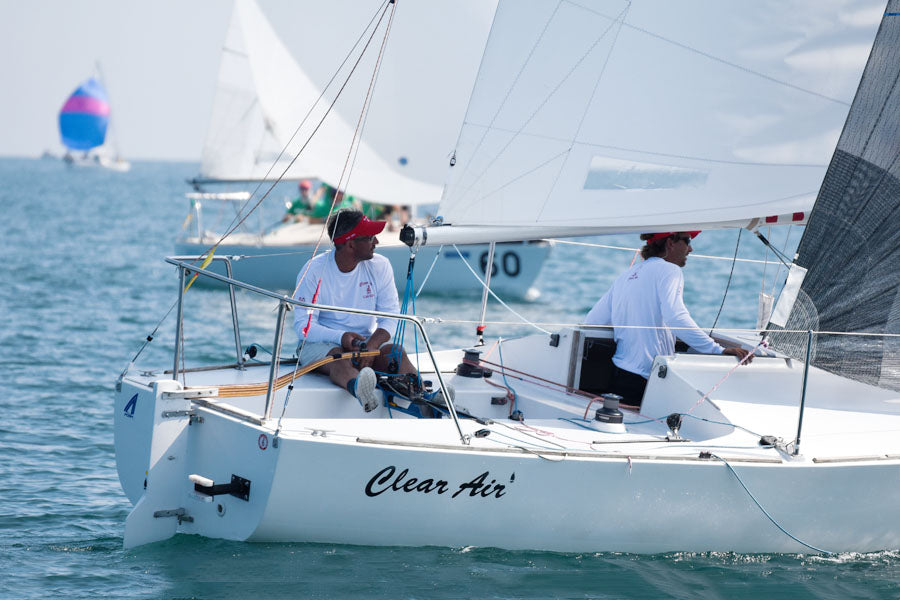
A WEEK OF CLEAR AIR
A WEEK OF CLEAR AIR
Interview with Rossi Milev, 2017 J/24 World Champion
Rossi Milev sailed his first J/24 Worlds in 2000 in Newport. He didn’t win, but really enjoyed the class and the boat, so like a lot of J/24 sailors, he kept coming back for more. Seventeen years later, he finally sailed to victory at his home yacht club in Port Credit, Ontario. He set his sights on the Worlds, which happened in September of this year. Boats began to collect in the parking lot days before the event with sailors who were eager to get their boats measured in and race-ready. Port Credit Yacht Club was so “on-point” for the World Championship, they were able to get all 63 boats registered and measured one day ahead of time. From a racer’s perspective, this speedy inspection was ideal, as sailors wanted to start focusing on racing and put in some practice time. Given the conditions that happened this year, and keeping in mind that weather is unpredictable, Rossi worked hard to get this regatta to his home yacht club, as he knew they would do a great job running a World Championship for the J/24 Class. Once they won the bid for hosting the event, Rossi set his sights on taking home the trophy.
Before the first race came to an end, the fleet knew this was going to be a very tough regatta. Rossi’s team Clear Air came across the finish line not quite where they expected.
“Looking at our results from the first race, local knowledge did not pay off. The fog was thick. Halfway through the beat we had committed to the left, which was normal, but it didn’t pay off at all.” Team Clear Air was disappointed, but before the second race they put their heads together and shared a prediction. “Everybody can have a 46th place. This is the World’s. It’s going to come down the last leg of the last race.”
“We had pretty good starts, and some not so good ones. When we had bad ones we flipped on port and made the best of it. It was the perfect opportunity to crack off the sails and get the boat going as fast as we could. We would take some sterns, and even duck, which wasn’t necessarily bad. Boat speed was so important.”
All the teams found their own challenges during 8 light air races, including current. Rossi stated; “The current here was going east to west, it wasn’t really normal. We usually see more in windier weather.” This unexpected adverse current became an obstacle when coming in on the starboard lay line and at mark roundings.
“Winning the J/24 Worlds is as hard as winning the Worlds in any other class. It may actually be harder, because the boats are all even. There are a lot of great sailors in the class who had deep results. Up until the last race it was still not determined who would win.”
Rossi’s team sailed the 2016 North Americans (minus 1 crew member) as well as many local races, so they knew each other; they just hadn’t been sailing the J/24 together leading up to the Worlds. Rossi only sailed one J/24 event a couple weeks before the Worlds at his home club, with a different team. “Everyone has families, work, growing businesses. We all kind of parted ways for a while.”
For the Worlds, he said, “Each day our communication got better.” He was very confident in his crew. Although they hadn’t been sailing much together, they were able to pick up where they left off. By the end of the week, they were right where they wanted to be. Rossi was also very familiar with his boat, which had won a previous J/24 Worlds. He claims she has unbelievable speed, especially in light air.
Rossi worked with Will Welles when he won the 2014 J/24 Worlds, and he says he learned a lot from his experiences sailing with and against Will about technique and boat setup during their tuning sessions. “I keep my rig just a bit looser than what the tuning guide says. I can feel the boat better, and I feel quicker and have more options and can settle into the groove.” He uses the tuning guide as a tool. He knows he is in a “safe” range, then goes by feel. He has a great feel for the boat and knows when changes need to be made for overall boat speed improvement. Rossi had trained on Lake Ontario in light air ahead of the Pan Am Games a few years ago. He said that contributed to his loose rig setting at this years’ Worlds; in the same conditions, he felt very confident in his settings.
“The steps I would move to on the rig were in increments, at a half-turn rate. Small adjustments are key in lighter air, and I never go the next full step unless the wind picks up more significantly. I have a great feel for the boat and helm, and can tell when changes need to be made.”
We asked Rossi what he thought about moving the mast butt. “I did move it a couple of times when I was training with Will and Tony Parker in the days prior to racing. I found a sweet spot that I liked and the boat felt great. I ended up leaving it there for the whole regatta, as it was the right balance between my sails, foils, and helm.” As for moving the mastbutt, he says, “just gives you a piece of mind.”
We asked Rossi what his number one tip would be to all J/24 sailors. He replied;
“Always look at your leeward shrouds. You want to see them dangle a bit. That’s how I decide how much I need to come on or off the rig.”
Rossi is focusing on work again, but he’d like to sail with other teams in 2018. He already has his sights set on the 2019 Worlds in Miami, and the upcoming winter circuit is of interest to him spending time sailing with good friends.
“Miami will be awesome. It will be another hard Worlds to win again. The stronger more prominent current, bigger breeze, and waves will have more effect on overall performance. It will be very different from this year.”
We asked Rossi what he likes about the J/24 Class and what keeps him coming back for more. He was humble as he replied;
“I like the J/24 Class because it is affordable and the sailors are very good. We wouldn’t have as many youth and women’s teams out there if it was expensive like a lot of other more high-performance classes. The J/24 is a great boat to learn from and race, and the events are a lot of fun. There is a reason why nothing has replaced it. How many young people have learned how to sail on a J/24? A lot of them. Because it is fun. It’s a good Class to be a part of.”
For the 2017 Worlds, Rossi’s inventory consisted of North Sails Fat Head Mainsail, DX-7TT Genoa, and FR-2 Spinnaker. Click here for more information on our products, or to speak with your local expert.
North Sails J/24 Tuning Guide
READ MORE
READ MORE
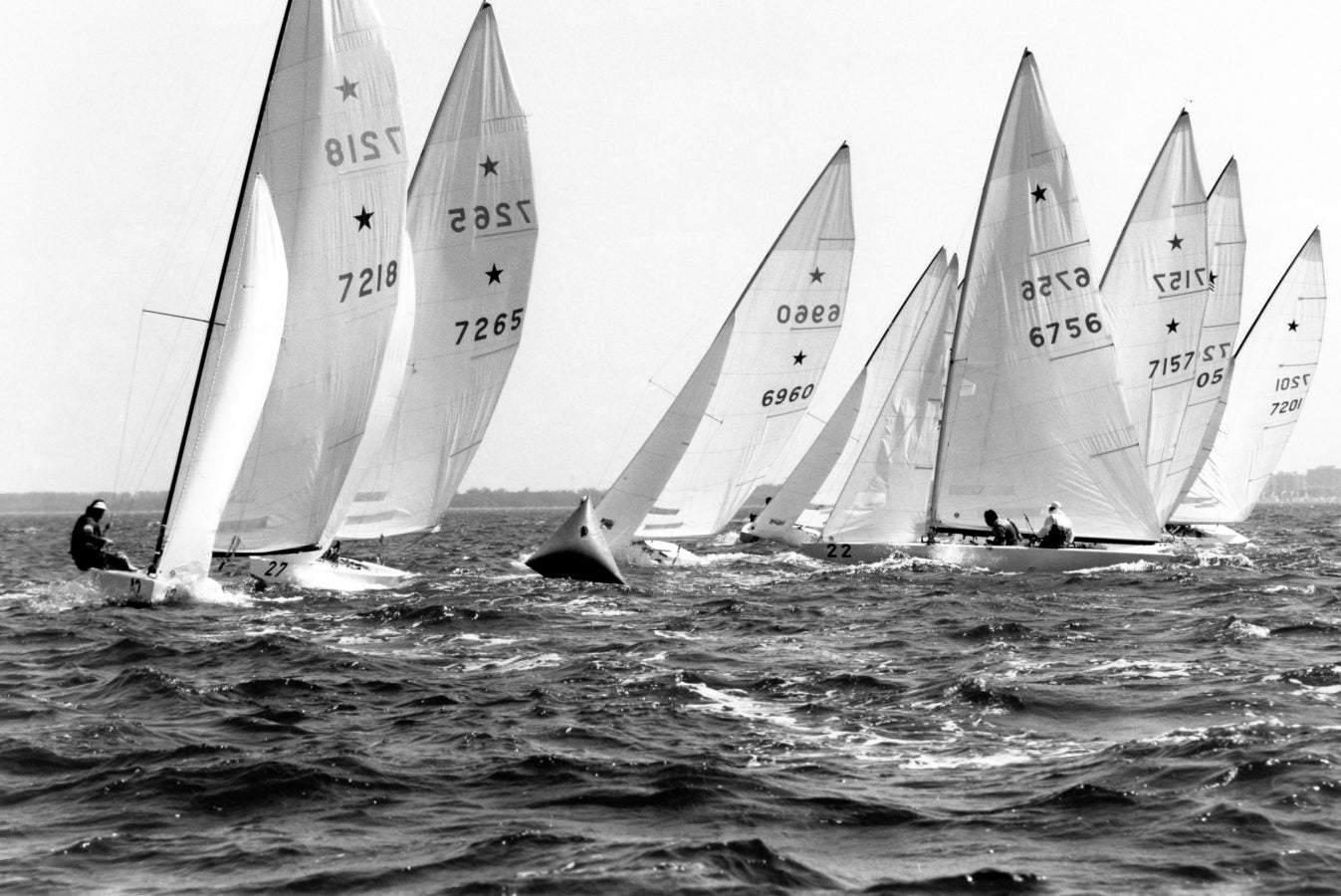
1968 - OLYMPIC SAILING SUCCESS
1968 – Olympic Sailing Success
In the original North Sails loft in San Diego, Lowell North initiated in-house testing of sail cloth and design shape. With a focus on the Star class, it was in this loft that he developed the sails he would win Olympic Gold with in 1968 in Mexico City. Olympic success has run strong throughout North Sails history, with numerous medal-winning staff members and a wide-reaching commitment to providing the best one design products across different classes. Recent examples include the Finn, Women’s 470, and Women’s 49er FX, in which North sailmakers work closely with Olympic sailors to achieve performance gains through cutting edge design and complementary trim and tuning.
In this video we hear from one design expert and Olympic sailor, Vince Brun, who’s leadership guided North Sails One Design for 35 years. In addition, Olympic medalist Caleb Paine (Finn, USA) shares how North influenced his winning performance at the Rio Games, and European President of North Sails One Design, Paul Hobson, gives a sailmakers’ perspective by drawing from his 20 years of working with the Finn class.
READ MORE
READ MORE
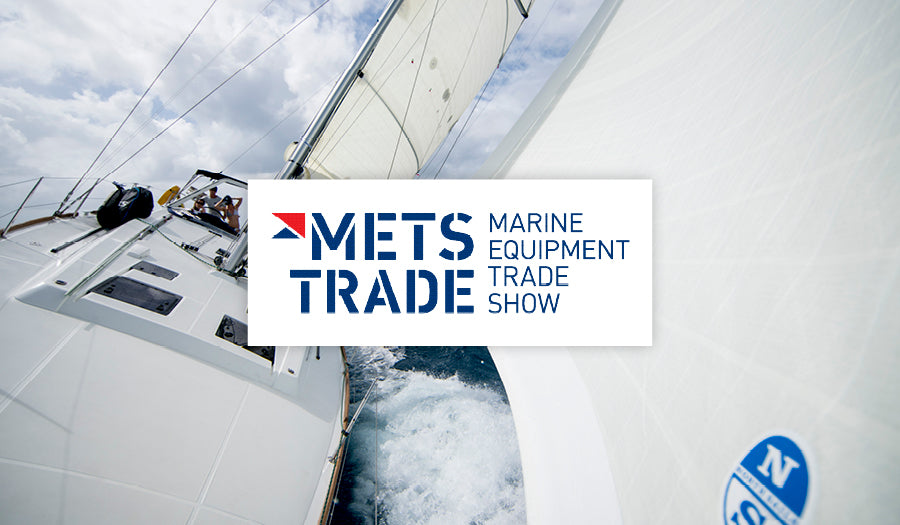
BEZOEK NORTH SAILS TIJDENS METSTRADE 2017
Bezoek North Sails tijdens METSTRADE
North Sails is aanwezig op de METSTRADE in de RAI Amsterdam van 14-16 november 2017
Bezoek North Sails tijdens de METSTRADE in Amsterdam, ons standnummer is 07.155. Kom langs of maak een afspraak met één van onze North Sails experts. Meer informatie over tickets voor de METSTRADE 2017 is te vinden op https://www.metstrade.com/tickets
READ MORE
READ MORE
